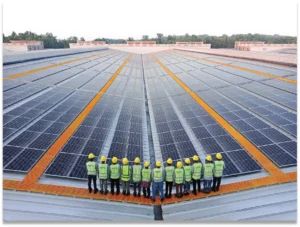Latest Issue

A Litmus Test for Bangladesh Economy
It began with a verdict. Not a speech, not a scandal—just a quiet ruling from Bangladesh’s judiciary. On June 5, 2024, the High Court reinstated a quota system for government jobs, reserving 56 percent of positions for specific groups, including descendants of freedom fighters. For many students, it felt like a door slamming shut. Within days, campuses across the country stirred with frustration. The movement that followed—Students Against Discrimination—was born not in fury, but in resolve. Their rallies were orderly, their chants measured. But beneath the surface, tension simmered. By early July, that tension boiled over. The protests evolved into the “Bangla Blockade,” a sweeping shutdown of roads and highways that paralysed the nation’s arteries. Buses vanished. Containers stacked up at ports. Supply trucks idled outside factories. Dhaka’s markets emptied as perishables spoiled in the heat. Exporters missed deadlines. Small traders watched their earnings evaporate. What began as a student movement had metastasized into an economic crisis. DEFINING MOMENTS June 5 | 2024 High Court reinstates quotas June 7-15 | 2024 Students begin peaceful rally, social media activism July 01 | 2024 Nationwide Bangla Blockade begins July 16 | 2024 Violent crackdown, leaving dozens killed Late July | 2024 FDI approvals drop 40%; export delays, gas shortages August 5 | 2024 Interim Government formed Sep–Dec | 2024 Interest hits 10%; ADP spending 49-year low Jan–Mar | 2025 Remittances peak; inflation eases; current account surplus Apr–Jul | 2025 Recovery phase: DSEX up 12.5%; exports rebound; MFS grows 64% August 5 | 2025 One-Year Anniversary A Nation on Edge On July 16 of 2024, the calm shattered. Security forces moved in with batons, tear gas, and live ammunition. The clashes were brutal. Ambulances raced through smoke-filled streets. Students lay bloodied on stretchers. Families camped outside police stations, desperate for news. Independent monitors reported hundreds injured and dozens dead. The government disputed the numbers. But the images—broadcast across television screens and social media—left little room for doubt. The shockwaves were immediate. Investor confidence collapsed. The Dhaka Stock Exchange saw its sharpest single-day drop in five years. Foreign direct investment approvals fell nearly 40 percent in the second half of 2024, according to the Dhaka Chamber of Commerce and Industry. The city, once buzzing with commerce, fell into a hush. Three weeks later on August 5, an interim government was announced, led by Nobel laureate Muhammad Yunus along with a panel of technocrats and civil society leaders. Their mandate: restore stability, rebuild trust, and prevent further economic unraveling. The Economic Aftershocks The July Uprising, as it came to be known, left no sector untouched. While the garment and ceramic sectors bore the immediate brunt, the ripple effects extended far wider. The banking system, already strained by years of financial irregularities, teetered on collapse. A post-uprising asset quality review revealed widespread non-performing loans and misappropriated funds, prompting the interim government to initiate recovery drives and liquidity injections. The Bangladesh Bank raised the policy rate to 10 percent to tame inflation and stabilise the exchange rate. Net foreign direct investment (FDI) dropped to a five-year low in 2024, as global investors cited political instability and opaque regulatory frameworks. The World Bank flagged Bangladesh’s deteriorating investment climate, while local chambers warned that the budget lacked a clear roadmap for restoring investor confidence. The energy sector faced dual shocks: gas shortages crippled industrial output, while privatisation efforts triggered an 18 percent hike in urban electricity tariffs, sparking fresh protests. The mental health toll was staggering. A Bangladesh Medical University seminar revealed that 82.5% of injured protesters suffered from depression, and 64% showed signs of post-traumatic stress disorder, underscoring the long-term human cost of the crisis. In the ceramic industry, 70 factories struggled to stay afloat. The Bangladesh Ceramic Manufacturers and Exporters Association (BCMEA) reported that gas pressure—critical for kiln operations—dropped to as low as 2 PSI in some zones, far below the required 15. Production stalled. Costs soared. Their demands were precise: uninterrupted gas supply, priority allocation, compressor permissions, a five-year tariff freeze, and duty-free solar imports. None were met. The garment sector fared no better. The Bangladesh Garment Manufacturers and Exporters Association (BGMEA) confirmed shipment delays averaging two weeks during the unrest. Export Promotion Bureau (EPB) data showed a 7.8% decline in garment exports in Q3 of 2024. Buyers in Europe and North America have shifted orders to Vietnam and India. Smaller exporters faced penalties and lost contracts, according to the Bangladesh Knitwear Manufacturers and Exporters Association (BKMEA). The Foreign Investors’ Chamber of Commerce and Industry (FICCI) called for stronger rule of law, faster customs clearance, and smoother approvals. The Bangladesh Chamber of Industries (BCI) highlighted the plight of agro-processors, many of whom faced wastage and layoffs. Their appeal: concessional loans and tax relief. Even real estate, long seen as a safe haven, stumbled. The Real Estate and Housing Association of Bangladesh (REHAB) reported a sharp drop in property transactions, citing high registration fees, interest rates, and uncertainty over the Detailed Area Plan (DAP) revisions. Across industries, the message converged: without urgent reform, Bangladesh’s hard-earned gains risked slipping away. The Numbers Behind the Crisis The numbers told a sobering story. By late 2024, exports faltered, imports shrank, and growth slowed to its weakest pace in years. The disruptions that began with student protests soon seeped into every corner of the economy, from factories to food markets. Inflation surged through the summer, eroding wages and squeezing households already under strain. Though the pace of price rises eased the following year, the scars remained. Construction sites went quiet, housing demand collapsed, and long-promised infrastructure projects were postponed. The slowdown was no longer abstract—it showed in half-finished bridges and shuttered shops. Private investment also lost its footing. Business registrations dwindled, banks groaned under bad loans, and confidence withered. Even as revenue collection improved, it could not
Read More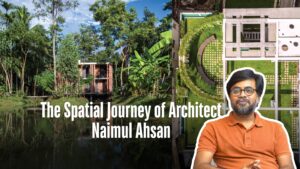
The Spatial Journey of Architect Naimul Ahsan
Architecture begins with a dream, but its true value lies in design—making buildings easy to construct, comfortable to inhabit, and meaningful for those who live in them. This is the guiding principle of Naimul Ahsan Khan, founder of Spatial Architects, who spoke about his philosophy on a calm evening in his studio. For Khan, architecture exists for the people. Simplicity is not just aesthetic but ethical—a way to make spaces accessible, functional, and enduring. His career, marked by both imagination and pragmatism, reflects this belief. After graduating from BUET in 2006, Khan began his professional journey at VITTI Sthapati Brinda Ltd., while teaching at the University of Asia Pacific, later joining S. Islam Consultants to gain formative experience. Yet even before these formal beginnings, in 2005, he co-founded Matra Architects with three friends, working from a small room at Sher-e-Bangla Hall before moving to Kalabagan. Though the firm dissolved in 2009, it set Khan on the path to independent practice. That same year, he and his wife, architect Farzana Rahman, established Spatial Architects, which has since delivered over 200 projects across Bangladesh. Khan’s design philosophy is rooted in modernist minimalism, inspired by Mies van der Rohe’s dictum “less is more.” But he translates this principle into a distinctly Bangladeshi context, using simple forms, local materials, and designs that respond to everyday life. Tagore’s words— “simple words are not easy to say”—resonate with him; simplicity in architecture is often the hardest to achieve. Influenced also by Arundhati Roy, who abandoned architecture because of its alienating language, Khan strives to make his work understandable to ordinary people. This approach is evident in his most celebrated project, Shikor. More than a farmhouse, it is a journey back to rural roots, connecting four generations of the family it was designed for. The design process was deceptively simple: reinterpret elements of rural architecture in a universal, contemporary language. The project transformed the surrounding village, too—muddy roads were paved, solar lights brightened the nights, and a community library was built. “A city family reconnecting with their village changed the village itself,” Khan reflects. In Chattogram, his Chandrapuray Kichukhon project challenges the dominance of isolated urban apartments. The nine-storey residence, designed for an extended family, revolves around courtyards, gardens, and communal spaces, reviving collective living in a dense city. “We won’t be here forever, but the memories will remain,” the clients told Spatial Architects—a vision the design honours. Even religious projects follow Khan’s principle of restraint. In Narsingdi, the Baitul Mamur Mosque occupies a modest 55 by 25 feet plot. “It’s such a small piece of land—nothing conventional could be built, so we decided not to force anything,” he explains. Instead, perforated brick walls breathe, and a lightweight metal roof allows air and sunlight to flow freely, creating a spiritual space that feels open and alive. Khan’s influence extends into education architecture. Working with the Education Engineering Department, he is reshaping rigid, prison-like school layouts into environments that foster joy, safety, and learning—a quiet revolution in the country’s classrooms. His work has earned international acclaim: First Prize in the Fael Khair Programme International Competition (2009), the Gold Diploma at the Eurasian Prize (2021, Russia), Best of Best at the Architecture Master Prize (2021, California), and First Prize in the NESCO Head Office Complex Competition (2024). Yet for Khan, success is measured not in awards but in client satisfaction. “I want to put my clients first. Their satisfaction is my real achievement,” he says. Sustainability, for him, is local. “Being local is sustainable,” he asserts, advocating for indigenous materials and designs that respond to climate, context, and community. Initially skeptical contractors come to appreciate the clarity of his solutions, and over time, he has built trusted teams of masons and builders who “understand his language”. Khan is equally outspoken about urban planning in Bangladesh. “We’ve done master plans and detailed area plans, but what we need is urban design,” he insists, warning against overburdening Dhaka and urging development in other cities. He is critical of RAJUK, which he sees as prioritizing promotion over development, emphasizing that regulations must be transparent and serve the public. Deeply influenced by Bashirul Haque and Mazharul Islam, Khan consults their work when in doubt. He admires contemporaries like Kashef Mahbub Chowdhury and Marina Tabassum, while following global figures such as Tadao Ando. He also champions architectural publications, asking, “A hundred years from now, how will people know what Bangladeshi architecture was like?” For him, publications bridge architects and the wider public. Optimistic about the younger generation, he says, “They’re smarter than us. They don’t need our advice.” Yet he encourages students to study more about Bangladesh if they intend to practice locally. Khan’s buildings do not compete for attention—they settle into their surroundings, listening to the land, the people, and the passage of time. For him, architecture is a lived experience, not an abstract statement. By making it easy to build, easy to inhabit, and easy to love, he has created a practice that resonates deeply with the essence of Bangladesh itself. Written By Arefin Murad
Read More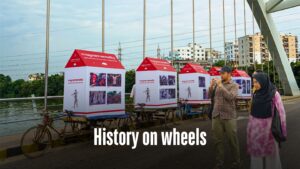
Dhaka’s Moving Tribute to July Revolution
Pedestrians paused in silence, bus conductors gazed from their windows—some recognising familiar faces, others lost in painful memories. A powerful street exhibition in Dhaka displayed haunting images from Bangladesh’s July 2024 Mass Uprising, bringing the city’s recent trauma into public view. “While traditional galleries in Dhaka often cater to only a certain class of people, a floating street exhibition was envisioned as a way to bring art into public spaces—making it accessible to people from all walks of life,” says Taslima Akhter, the acclaimed photojournalist and activist who organised the event alongside Pathshala South Asian Media Institute. On August 11-12 of 2025, five exhibition vans set out from the Raju Memorial Sculpture at Dhaka University, bringing the story of the July Uprising to the streets of Dhaka, covering most of the significant spots where the revolution took place. The key aspects of this floating exhibition were to demonstrate the participation of students, professionals, everyday people—especially women—and the significance of D-Day, August 5. Creatively set up on vans, photographs and artworks were mounted on temporary house-like structures with striking red roofs, drawing the attention of day labourers, students, office workers, chauffeurs, and people from all walks of life—just as they once came together to free the country from the 15-year authoritarian regime under Sheikh Hasina’s government. The vans stopped at key sites of the uprising, letting visitors engage with the images. Organisers admitted the street exhibition was challenging—but they were committed to reaching as many people as possible. Originally planned to honour the martyrs on the uprising’s first anniversary, the exhibition was postponed due to logistical challenges. “What you see now is a collection of the works we were able to gather, with consent from the participating photographers,” said Taslima. She further said how we’re not only fighting the effects of fascist ideology in our society, but also confronting it within our own thought processes. In the past, many artists and photographers hesitated to share their work—uncertain whether to publish without captions, or anxious about choosing the right words. But now, we’re seeing more and more artists overcome that fear, driven by a collective urge to tell the truth through their work. When asked about the downside of everyone having a camera in their hands today, Taslima shared a different perspective. On the contrary, she explained how portable devices have empowered not just photographers but everyday people to document history like never before. If it weren’t for ordinary citizens, much of the horror of the July revolution across the country would have gone unseen. What was once a tool for personal use has now become a powerful instrument for capturing and sharing the truth. Exhibitions like this mark a crucial shift in the power dynamics of information. They democratise memory, ensuring the story of the revolution belongs to everyone—not just a privileged few. They also remind us that art and photography are powerful tools of resistance and collective remembrance. Written by Fariha Hossain Photo: Md. Rasel Ahmed
Read More
Meghna Ceramic’s Fresh brand redefining Bangladesh’s ceramic industry
Sustainability, innovation, and design leadership define Meghna Ceramic Industries Ltd. (MCIL), a concern of Meghna Group of Industries (MGI). Since its establishment in 2021 under the brand Fresh Ceramics, the company has rapidly grown into one of Bangladesh’s leading tile manufacturers while setting new benchmarks in responsible ceramic production. Nestled in Ashariar Char of Meghnaghat, Sonargaon, Narayanganj — nearly 39 kilometres from the capital Dhaka — MCIL boasts the highest tile production capacity in Bangladesh at 51,000 square metres per day. With cutting-edge machinery from the USA, Germany, Italy, and China, and Bangladesh’s longest kiln (261 metres) under a single shade, MCIL reflects both scale and vision. But what truly distinguishes it is a deep commitment to sustainability and environmental stewardship, ensuring growth aligns with ecological responsibility and worker wellbeing. Sustainability at the Core AKM Ziaul Islam, chief operating officer at Meghna Ceramic, explained how Fresh Ceramics is working to remain true to its promise of “A Fresh Start to an Aesthetic Life.” “We have designed our factory to minimise environmental impact while maximising efficiency.” MCIL has taken six core initiatives: Zero Groundwater Dependency: Surface water treated in-house through a Water Treatment Plant (WTP). Wastewater is purified in an Effluent Treatment Plant (ETP) and safely discharged — ensuring a closed-loop water cycle. Emission-Free Operations: Kilns release only clean white vapour, with no carbon emissions or black smoke. Advanced Heat Management: Controlled heat systems eliminate external heat emissions, ensuring worker-friendly indoor conditions. Dust-Free Environment: A dust management system ensures minimal discharge, protecting workers and the community. Renewable Energy Integration: Solar panels feed into the company’s grid, reducing fossil fuel dependence. Daylight Optimisation: Architectural features reduce the need for artificial lighting, lowering electricity use. Together, these initiatives underscore MCIL’s leadership in sustainable manufacturing and its role as a responsible industry pioneer. “We designed the factory not only to protect the environment but also to ensure a safe, healthy, and efficient workplace for our employees,” Islam added. Vision and Growth “The vision behind MCIL was to redefine aesthetic living in Bangladesh by offering high-quality ceramic tile solutions that combine durability, functionality, and design,” Islam said. Fresh Ceramics started with small-sized tiles before expanding across all ranges and surfaces. Known for glossy tiles with exceptional smoothness, it became the first in Bangladesh to introduce a full line of double charge tiles in three market-winning sizes. Building on that success, MCIL now offers matt and matt-carving tiles, with its R&D team pushing innovation to match modern lifestyles. Nationwide, the brand has built a robust distribution network through dealers, retailers, and exclusive showrooms. Its flagship display centre, “House of Aesthetics,” opened in Dhaka’s Hatirpool, with another underway in Chattogram. Innovation and Technology Meghna Ceramic has invested heavily in advanced laboratories and modern systems, ensuring precision, durability, and design superiority. Its laboratory is currently the most advanced in Bangladesh, capable of analysing raw materials and finished products with extreme precision. Social Responsibility “Our parent company, Meghna Group of Industries, is actively engaged in a wide range of CSR initiatives, contributing significantly to community development across Bangladesh,” said the COO. “Uniquely, we have introduced an insurance policy — the first of its kind in Bangladesh’s tile industry — for over 3,000 tile fitters, recognising their essential role in the sector.” Along with this, every year the “Eid Express” campaign is organised, through which the group ensures safe travel for lower-income tile labourers, workers, fitters, and store assistants at dealer showrooms. MCIL also takes pride in other efforts that the group undertakes to contribute to society. “We have currently employed over 1,500 people across our factory, sales, distribution, and support departments. Women are working side by side with men, ensuring an inclusive and diverse workplace,” Islam added. Meghna Ceramic also maintains a clean, safe, and climate-controlled work environment, where skilled and semi-/non-skilled individuals are hired and provided with on-the-job training to help them gain industry-relevant skills. Challenges and Resilience The ceramic industry faces hurdles such as raw material dependency, volatile energy prices, and high taxation. “Over 90 percent of essential raw materials are imported, making manufacturers vulnerable to global fluctuations,” said Islam. MCIL tackles these challenges by running efficient production lines, sourcing through diversified suppliers, adopting renewable energy, and advocating for supportive policies. Market Leadership and Future Outlook Domestically, Fresh Ceramics has become the highest-selling tiles brand in Bangladesh. MCIL is confident of entering global markets soon, backed by international-standard production and competitive pricing. Meghna Ceramic is preparing to expand into sanitaryware alongside new surface technologies and tile sizes. Its strategy balances nationwide reach with a growing focus on metropolitan and cluster markets. “We actively gather market insights and conduct R&D to drive innovation. Our future expansion is designed to make Fresh Ceramics a complete lifestyle solution for customers,” Islam said. Ready for the Global Market MCIL is not just building for the local market — it’s thinking globally. Its advanced production lines, strict quality control, and trend-driven designs make it a strong candidate for international success. “From the ground up, we built MCIL with a global mindset. Our plant layout, automation level, lab testing capabilities, and product design are all geared toward international markets. We’ve already received interest from buyers in the Middle East and Europe,” said Ziaul. He emphasised the brand’s international readiness and commitment to excellence. “Fresh Ceramics is not just a local brand — it’s designed for global demand. Whether it’s product innovation or packaging, we’ve benchmarked ourselves against top-tier global producers. Our leadership believes that only those companies that combine innovation with responsibility will survive in the global arena.” Leading with Purpose With sustainability at its core, innovation driving its growth, and responsibility guiding its social impact, Meghna Ceramic Industries Ltd. is not just producing tiles — it is shaping the
Read More
Driving Tile Innovation in Bangladesh
Introduction: Bangladesh’s Ceramic Industry on the Rise Over the past decade, Bangladesh has witnessed remarkable growth in its ceramic industry, particularly in the field of ceramic tiles. What was once a modest segment catering primarily to domestic demand has now evolved into a thriving sector, contributing significantly to the country’s industrial output, employment, and exports. With rapid urbanization, rising consumer aspirations, and infrastructural development across the nation, ceramic tiles have become a symbol of both practicality and modern living. At the heart of this growth story lies a crucial but often less visible factor: the availability of high-quality raw materials, advanced technology, and reliable technical support. Without a steady supply of consistent, innovative, and globally benchmarked inputs, manufacturers would find it challenging to compete on quality, efficiency, and design. This is where Xphere Global has played a pivotal role through its flagship company, Vidres India Ceramics, driving innovation and providing dependable solutions that have reshaped Bangladesh’s ceramic landscape. Equally important is the role of technology, where Kerajet, Spain, has emerged as a new alternative for world-class digital printing solutions. These advanced technologies are now being introduced to Bangladesh through Trans India Ceramics, the authorized distributor of Kerajet and another group company of Xphere Global. Together, this integrated approach ensures that manufacturers have access to not only the finest raw materials but also cutting-edge printing technology — empowering the industry to deliver tiles and tableware that meet global standards of design and performance. Our Flagship Presence in Bangladesh: Building Trust Over 5 Years A key milestone in the evolution of Bangladesh’s ceramic tile industry has been the entry of Xphere Global and Vidres India Ceramics, which forayed into this market five years ago. Since then, the company has established itself as one of the trusted brands in the sector, delivering reliable solutions that empower manufacturers to enhance quality, innovate with confidence, and stay aligned with global trends. Through a blend of high-quality raw materials, consistency, and innovation-driven partnerships, Xphere Global and Vidres India Ceramics have contributed significantly to raising benchmarks in the Bangladeshi ceramic industry. Our efforts are not just about supplying materials — they are about nurturing long-term relationships and enabling manufacturers to bring world-class surfaces and finishes to both domestic and export markets. Beyond Supply: Technical Support as a Differentiator In the competitive world of ceramics, having access to raw materials is not enough. The real edge comes from knowing how to use those materials effectively to produce innovative, market-ready products. This is where our superior technical support sets us apart. Collaborative Development: Our technical teams work closely with Bangladeshi tile manufacturers, helping them fine-tune formulations, experiment with new surfaces, and troubleshoot production challenges. This collaborative approach ensures that our partners are not just keeping up with trends but setting them. Training & Knowledge Sharing: We conduct technical workshops, training sessions, and joint development programs to upskill local teams. By transferring knowledge and expertise, we empower manufacturers to push boundaries and explore new market opportunities. Problem-Solving Expertise: From glaze application issues to kiln performance, our experts provide hands-on guidance, reducing downtime and ensuring smoother operations. For many manufacturers, this level of support is the difference between staying competitive and falling behind. Technology Partnerships Driving Innovation Alongside raw material excellence, technology plays a transformative role in defining the competitiveness of the ceramic industry. Here, Trans India Ceramics has emerged as a crucial partner, serving as the official distributor for Kerajet S.A., Spain. Kerajet is recognized globally as a pioneer in digital printing technology, delivering highly effective printing solutions that cater to both the ceramic tile and tableware industries. By bringing this cutting-edge technology to Bangladesh through Trans India Ceramics, manufacturers are now empowered to produce tiles and tableware with superior design precision, versatility, and efficiency, ensuring they meet the evolving demands of both domestic and international consumers. This synergy of world-class raw materials, robust technical support, and state-of-the-art printing technology positions Bangladesh’s ceramic sector to compete confidently on the global stage. Leveraging Global Trends for Local Growth Ceramics is a truly global industry, with trends often originating in Europe, the Middle East, or Asia before spreading worldwide. Our presence in multiple international markets gives us a unique vantage point to bring global insights into the Bangladeshi context. Some of the key global trends we have been helping Bangladeshi manufacturers embrace include: Large-Format Tiles: Growing popularity of slabs and large surfaces for modern architecture and interiors. Eco-Friendly Production: Increased demand for sustainable, low-carbon processes and recyclable materials. Digital Printing & Advanced Surfaces: Innovative printing technologies creating wood, stone, and marble-like finishes. Functional Surfaces: Anti-slip, antibacterial, and easy-to-clean finishes gaining traction with health-conscious consumers. By aligning our raw materials and technical services with these trends, we enable Bangladeshi producers to compete not only in domestic markets but also internationally, enhancing the reputation of “Made in Bangladesh” ceramics.
Read More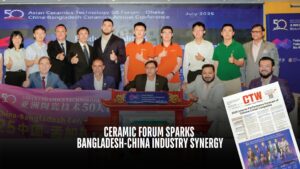
CERAMIC FORUM SPARKS BANGLADESH-CHINA INDUSTRY SYNERGY
In mid-July, Dhaka hosted the Asian Ceramics Technology 50 Forum at Hotel Amari’s Eden Grand Ballroom, marking a pivotal moment for Bangladesh’s ceramic industry. The event gathered leaders from Bangladesh and China to explore innovation, efficiency, and cross-border collaboration under the theme “Product Quality & Production Efficiency Enhancement and Investment Opportunities in Bangladesh – Win-Win Cooperation.” Delivering the welcome address, Irfan Uddin, general secretary of the Bangladesh Ceramic Manufacturers and Exporters Association (BCMEA), emphasised knowledge-sharing and sustainable growth. Praising China’s global leadership in ceramics, he said their participation reflected a shared commitment to regional cooperation. Chief guest Md Mamunur Rashid FCMA, acting BCMEA president and additional managing director of X Ceramic Group, highlighted the forum’s role in strengthening Bangladesh-China ties through joint ventures, technology transfer, and strategic investment. “Forums like this serve as a powerful platform for dialogue, innovation, and mutual growth,” he said, citing supportive government policies. The first technical session, chaired by Mohd Ziaul Hoque Zico, director of BCMEA and CEO of Hua Thai Ceramics, focused on quality and efficiency. Speakers included consultant Engr. Sadat H. Talukder and Luo Fei of Foshan Uniceramics Development. Discussants Saidur Rahman Khan of Akij Ceramics and Yang Shuilan of Foshan Lang Kun Electromechanical added insights. Yang noted rising consumer demand and costs, stressing that “quality and efficiency are not trade-offs but the double-helix genes of survival,” citing intelligent kiln control and AI visual inspection. Talukder pointed out Bangladesh’s low global market share—0.48% in tableware, 0.005% in sanitary ware, and 0.001% in tiles—despite resources, urging advanced kiln technologies, solar integration, and skill development. Khan said quality depends on customer satisfaction, warning that internal and external failures drive up costs, making productivity gains essential. The second session, chaired by Mahin Bin Mazher, adviser to BCMEA and MD of X Ceramic, explored cost reduction and tile performance. Mohammad Bayazed Bashar of DBL Ceramics proposed using locally sourced liquid sodium silicate to cut costs by 50%. He showcased DBL’s zero-waste strategy and cogeneration initiatives that saved 18.8 million standard cubic metre of gas—worth $1.2 million—with pilots targeting net-zero emissions by 2030. Liu Zhanjie of Foshan Uniceramics noted Bangladesh’s rising output. In 2023, the country produced 280 million square metre of tiles and 16 million sanitary ware pieces, with per capita tile consumption at 1.65 sqm—far below China’s 6.9 sqm in 2017 He projected tile output could reach 700–840 million sqm and sanitary ware 40–48 million pieces in a decade. AKM Ziaul Islam of Meghna Ceramic stressed lowering costs and boosting efficiency, citing the sector’s evolution since 1984 and labour advantages. Sun Bowen of Zibo Huayan detailed high-strength ceramic rollers and shuttle kiln technology, with 1.5 million-piece annual capacity. The final session, chaired by Dr Md Anwar Ullah FCMA, featured Md Mominul Haque of LankaBangla Investments, who cited GDP growth of 3.8–3.97%, inflation easing to 8.48%, and reserves rebounding to $31 billion. He noted Bangladesh’s emergence as the 9th largest consumer market by 2030. Muhammad Nazrul Islam of Sandhani Life Finance urged foreign investment, citing high dividend yields. Joanna Sun of Tangshan Hexiang highlighted sanitary ware expertise and 536 patents, including 37 inventions. The forum concluded with a shared vision: Bangladesh-China cooperation can drive innovation, reduce costs, and elevate Bangladesh’s ceramics industry to global prominence. Photo: Courtesy Written by Sajibur Rahman
Read More
Industry Leaders Unite for a Greener Bangladesh
A Call for Sustainable Transformation On January 30, 2025, the Sheraton Hotel in Dhaka hosted “Shaping Bangladesh: Designing Tomorrow, Building Today”, a landmark event organised by Ceramic Bangladesh Magazine. It brought together leaders from construction, real estate, and ceramics to champion sustainability and innovation in response to environmental challenges. Thought Leadership for a Greener Future As part of the series “Innovating for a Sustainable Future II”, the multi-panel format featured experts from ceramics, cement, and real estate. Moderated by Dr. Amir Ahmed of Daffodil International University, the panels included Muhammad Badrul Hassan (BBS Cables), Salehin Musfique Sadaf (GPH Ispat), Architect Faysal Ahmed (Concord Real Estate), AKM Ziaul Islam (Magna Ceramic), Mohammad Khorshed Alam (Akij Bashir Group), Asadul Haque Sufyani (Metro Cement), and Babor Hossain (Khadim Ceramics). Key Recommendations for Sustainability Panelists urged greater investment in R&D to reduce reliance on imports and foster local innovation. They called for collaboration across sectors to promote recycled materials and eco-friendly components. Suggestions included using fly ash and slag in cement, adopting hybrid or electric furnaces, and implementing energy-efficient manufacturing. Smart Materials and Policy Reform Experts advocated for smart glass technologies—low-E, solar, and self-cleaning—to boost building efficiency. They also recommended policy reforms to protect local manufacturers from zero-tariff imports and emphasized the need for government-run clay mines to secure raw materials for ceramic production. Bangladesh’s Tile Industry Comes of Age AKM Ziaul Islam highlighted the tile industry’s evolution since 1984. “We started with 100 mm tiles in one color. Now, we export to the USA,” he said. Despite high production costs, innovation has improved working conditions and sustainability, making the industry globally competitive. Real Estate and Domestic Innovation Architect Faysal Ahmed reflected on the sector’s overreliance on imports between 2000 and 2015. He stressed the importance of collaboration among architects, engineers, and academics to develop sustainable materials locally and reduce dependency on foreign technologies. Material Optimization for Environmental Impact Salehin Musfique Sadaf emphasized that optimized material use can reduce emissions and speed up construction. “Using 15,000 kg of cement instead of 20,000 kg without compromising strength means real sustainability,” he explained. Rethinking Cement and Energy Asadul Haque Sufyani discussed the carbon footprint of cement production and promoted fly ash and slag as eco-friendly alternatives. He stressed the need for affordable, sustainable materials and energy-efficient technologies. Energy Crisis and the Future of Glass Mohammad Khorshed Alam raised concerns about gas shortages affecting glass furnaces. He urged investment in hybrid furnaces and advanced technologies and called on architects to incorporate more locally produced glass to avoid overcapacity and unsold stock. Ceramic Bricks: A Smarter, Greener Choice Babor Hossain showcased ceramic bricks’ advantages over handmade red bricks—lower water absorption, higher strength, and reduced structural load. “They were used in national landmarks and can cut construction costs by 13 percent,” he said, advocating for government-run clay mines to sustain innovation. A Unified Path Forward The event concluded with a call for synergy among policymakers, industry, and academia. With rising climate risks and infrastructure demands, embracing innovation is not just strategic—it’s essential. Photo: Courtesy
Read More
Create your story in the alley of Kalabagan
magine walking down a road in a residential area when suddenly an old brick gateway catches your attention. A softly lit alley leads you towards a small, cosy restaurant with a beautiful antique and warm ambience. Located right beside the popular “Tea & Tea” restaurant and owned by the same person, this place remains crowded most of the time. Youngsters keep the restaurant lively throughout the day, while in the evening and at night families usually come here to dine. The cosy environment, ambience, décor, and food, everything is bound to make your time memorable. Architect Hashim Reza Opu, principal architect of Arch_Station, is the designer of this beautiful restaurant. He shared with us the design journey, concept, theme, and challenges. Designing a restaurant in such a compact area, only 12 by 23 feet, or 550 square feet in total, while accommodating seating, a counter, a spacious kitchen, an attached toilet, and even a semi-outdoor smoking zone, was a huge challenge. The building was old, and the designer wanted to keep its essence intact. Creating an antique-themed restaurant within a limited budget and compact space was also demanding. To meet the challenge, he began with the layout plan. By removing partition walls, he created a free-flowing space for the main dining area. Ar. Opu said, “Creating a memory, creating a story was the main concept of the design. Stories can be of many types — rock story, sad story, soft story, museum story. But what I wanted to tell was an old story. Kalabagan is a nostalgic place for many. People have memories here. I wanted to preserve that memory.” The walls, with plaster falling off in many places, were preserved in their natural undulated patterns. A basic colour coat was applied to the brick portions, and the lower plastered layer was finished with a thick skim coat in the colour of old lime plaster. This undulation gives the walls the vibe of a broken hill. Seating was carefully designed with ergonomics in mind. Sofa heights were adjusted for comfortable dining, and circulation was kept clear. Multiple seating modules make the compact space versatile: couple seating, four-person arrangements, and cluster options where two four-person tables can easily host eight. There’s also a single chair tucked into a corner by a bookshelf, where someone can sip a drink and read; either a book, or simply the whole atmosphere of the place. The handcrafted, polished tables are beautiful enough to spark curiosity about their story. Every detail starting from the tables to the antiques on the wall, from the windows to the ceiling ribs is thoughtfully designed to capture attention. The window grills, repurposed from the upper floors, were painted in vintage green and white. The ceiling features wooden ribs reminiscent of old zamindar houses, with concealed lighting that creates a warm ambience. The lighting adapts to the crowd, with three different moods: concealed ceiling lights, hanging lamps above tables, and directional spotlights highlighting the exhibits. The walls act as canvases, displaying art and antiques: rickshaw wheels with strip lights, a striking wood carving of a woman, an antique clock, a heavy bell, and more. Solid doors were partially replaced with glass, creating curiosity and ensuring visibility of the place. On one wall, an “urban elevation” was designed with two doors and two windows, and even a vintage grill was placed on a closed wall to continue the elevation effect. The counter is particularly unique. Built from the bricks of the existing walls, it alternates layers of wood, brick, and lime plaster, with lighted glass voids in between. This experimental design turned out beautifully. Behind it, a compact 8-by-12-foot linear kitchen supports the operation. One highlight is the “Van Gogh Corner,” where a large Café Terrace at Night painting adorns the wall. This veranda-like space serves as a smoking zone and makes visitors feel as though they are inside the painting. The artwork extends into the seating area and lighting, with warm illumination falling on stone flooring below. Every small detail contributes to the crafted atmosphere. The walkway, handmade with brass concrete textured using nails, is designed like a landscaped path inside a city alley. From its entryway to its tiniest detail, the restaurant tells a story; a story of memory and nostalgia, enriched with antiques and thoughtful design. The alley of beautiful memories is waiting for you in Kalabagan. Written by Sadia Tarannum
Read More
A Legacy Written in Brick and Trust
In 1992, when Dhaka’s middle class was just beginning to dream beyond modest apartments, a quiet vision began to take root. It was not about towers or market share but something simpler: “We stand for more than just buildings. We stand for trust, quality, and long-term relationships,” said Wasif Shamsul Alamin, Executive Director of Shamsul Alamin Group. That ethos, inherited from his grandfather, has since grown into one of Bangladesh’s most enduring real estate legacies. From its official founding in 2003, Shamsul Alamin Real Estate Ltd. built its reputation project by project, with a principle as straightforward as it was profound—do what you promise. “Our reputation wasn’t built on advertising slogans; it was built on living up to our core principles of trust and quality, project after project,” Wasif explained. Today, with more than 50 completed projects across Dhaka, the company’s presence stretches from Gulshan and Banani to Uttara, carrying forward a legacy of care, not just construction. Resilience in a Changing Market The journey has not been without challenges. Financing remains a major obstacle, as higher bank rates strain both buyers and developers. Rising costs of steel, cement, and land add further pressure. Yet the company continues to innovate, exploring modern methods like steel-frame construction and embedding sustainability features such as rainwater harvesting and energy-efficient materials. “We’re not driven by volume or profit. We’re driven by purpose—to create high-standard, thoughtfully designed living spaces,” Wasif said, underscoring how the firm positions itself in a market projected to reach $3.53 trillion by 2028. Living Spaces with Soul In Baridhara’s diplomatic enclave, the company’s philosophy finds expression in Alamin Tonmoy, a residential project that feels more like a sanctuary than a structure. With its lush greenery and private, one-apartment-per-floor design. Tonmoy embodies what Wasif describes as “homes, not just properties”—spaces where life breathes and privacy thrives. Back in Gulshan 1, Alamin Angur offers another lens into the company’s vision. Its three-bedroom residences reflect tranquillity and family living, designed for those who value both space and community. Angur demonstrates the company’s sensitivity to everyday life in Dhaka, marrying functionality with understated elegance. Workspaces for a Modern City If Tonmoy and Angur show the company’s care for private living, its commercial ventures display equal attention to the rhythm of modern business. In Banani, A&A Alamin Business Bay reimagines what a workspace can be. With thermal glass façades and wellness- oriented design, it is less about corporate square footage and more about creating an environment where businesses flourish holistically. At Kakrail, Alamin Capital Square rises with quiet confidence. Its design balances aesthetics with longevity, providing corporate tenants not only modern facilities but also a sense of permanence. From prayer spaces to community floors, the tower reflects a corporate philosophy grounded in dignity and practicality. Further north, in Uttara, Plaza 15 stands as a landmark of accessibility and commerce. Along the wide Gareeb-E- Newaz Avenue, the development’s positioning makes it a hub where business meets community. Its scale and convenience are matched by a forward-looking approach to safety, offering Dhaka’s new commercial class both ambition and assurance. Problems that Demand Solutions Yet behind this skyline of promise lies a sector grappling with deep-rooted problems. Financing remains perhaps the most pressing. As Wasif explained, interest rates on home loans now hover between 9 and 18 percent, making mortgages unaffordable for many aspiring homeowners. Developers, too, feel the squeeze as project financing grows increasingly expensive. “We saw the positive impact when government pushed for single-digit housing loans,” he recalled. “Those initiatives truly stimulated demand. To keep this growth going, we need a similar approach.” Land scarcity in Dhaka adds another layer of complexity. Prices continue to soar, putting pressure on companies committed to affordability. Add to this the volatile costs of raw materials—cement, steel, glass—and the challenge of offering high-quality housing at reasonable prices becomes all the more daunting. For firms like Shamsul Alamin Real Estate, the task is not only to build but to do so within constraints that demand creativity and resilience. A Sector of Immense Potential Still, the potential of the sector is undeniable. With rapid urbanisation and a rising middle class, demand for housing remains resilient—even in the wake of global disruptions like COVID-19. Over the past 15 years, Bangladesh’s real estate market has witnessed remarkable growth, now valued at $2.68 trillion and projected to expand to $3.53 trillion by 2028. “Urbanisation and rising incomes are driving huge demand for homes. The numbers speak for themselves,” Wasif observed, framing real estate as not just an economic driver but a reflection of the nation’s transformation. Charting a Way Forward The solutions, according to Wasif, must come from both industry and policy. Innovation in design and construction can help lower costs and speed up delivery. Techniques like steel-frame building, once an experiment, are now becoming viable tools for efficiency. Sustainable features—energy-saving materials, green spaces, rainwater harvesting—are being embedded not just for environmental reasons, but because they reduce long- term living costs for homeowners. Policy, too, must evolve. Affordable, long-term mortgage schemes would unlock home ownership for middle-income families, while easier access to credit for developers could keep projects moving forward. Collaboration between state and private sector, Wasif argued, is the key to ensuring that the housing dream remains within reach for millions of Bangladeshis. Building More than Structures For Wasif, the mission is deeply personal. “Working in this company means being part of something bigger than just business—it’s about contributing to a legacy of honesty, care, and creating lasting value in people’s lives,” he said. In his words, real estate is not about concrete alone—it is about the dreams of families, the pride of ownership, and the future of a city that is still writing its skyline. Shamsul Alamin Real Estate
Read More
SACMI Continua+ Veloce: unmatched productivity
Available on all models, this new configuration delivers higher speeds and output rates up to 35,000 square meters per day. Further new features: it’s now possible to produce fired slabs up to 200 cm wide, with all the intrinsic advantages of a technology that sets the industry standard for productivity, versatility and low consumption. The number of solutions sold worldwide is now fast approaching 200. More productivity, less waste and lower consumption are the hallmarks of SACMI ceramic plants. Now, the Continua+ Veloce configuration takes those advantages to the next level. With this latest hyper-productive PCR version, the world-leading Continua+ slab and sub-size manufacturing technology now delivers higher speeds and a productivity up to 35,000 m2 per day for single machine. Now available on all PCR models, the Veloce configuration enhances the intrinsic advantages of this technology: for example, with the increased productivity, specific consumption at the compaction stage – already the world’s lowest – drops to just 0.04 kWh/m2. And there’s more. It’s also possible to combine the Veloce configuration with a broader compaction front to let manufacturers produce fired slabs up to 200 cm wide, vary thickness from 3 to 30 mm and obtain potentially infinite lengths. The increasingly popular Continua+ (the number of solutions sold worldwide is fast approaching 200) continues to be the leading ceramic slab and sub-size production technology. On Continua+, in fact, compacted scrap is always less than 1.5% regardless of the size, with all of it able to be recycled back into the process. Recipes and settings can be controlled flexibly via the operator panel, while motor-driven size changeovers maximize efficiency when handling complex, diversified production mixes. Quiet, easy to manage and with powerful results, Continua+ also reduces hydraulic oil requirements by over 90% compared to traditional or discontinuous presses. Slow, controlled de-airing ensures product uniformity and consistency, resulting in versatility with all body types and outstanding quality: a vital finishing touch to a solution that lies at the heart of the SACMI ceramic plant. More power, more control: alongside the latest Continua+ configurations, customers can also enjoy the advantages of new process control devices such as Optima+, part of the broad range of vision systems with which SACMI completes digitalization of the plant, simplifying its running while reducing the need for manual tasks.
Read More
Gruppo Tecno Ferrari S.p.A.
Gruppo TecnoFerrari S.p.A. is a leading Italian company with over 55 years of experience in manufacturing and supplying industrial automation for ceramics. The company’s product range includes – Handling and storage systems – Intralogistics solutions – Digital printers – Vision, quality control, and end-of-line systems Thanks to the high-quality know-how, TecnoFerrari extends its service to all manufacturing sectors, with a focus on ceramics, automotive, glass, food and beverage, paper and tissue. TecnoFerrari guarantees maximum plant reliability and the efficiency of highly customized solutions. New Product Details TecnoFerrari introduces a new way of digital decoration and application. The Decora line-up includes super-rigid monocoque frames with configurations that can accommodate 2, 8 or 12 colour bars, offering flexibility to design an optimized decoration line. Decora 2 takes the concept of flexibility to the next level by allowing the enrichment of the ceramic surface through the use of functional inks. It offers a new way of digital glazing. Same layout, same raw materials, but different effects. Unique Features: Compact, Flexible and Movable. Uses: Ideal for creating special effects and functional surfaces. Benefits: No more static images: each product becomes a unique, personalized piece. This technique delivers outstanding performance, especially in the production of structured or functional surfaces, combining the mass of material with the definition of the printed design. It can synchronize with existing printing machines, enabling optical centering of the image on tile.
Read More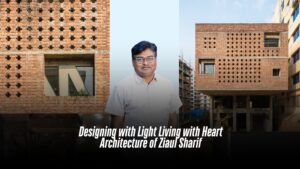
Designing with Light Living with Heart Architecture of Ziaul Sharif
In the narrow lanes of early 1990s Dhaka, a young boy paused in front of construction sites and miniature models displayed on black-and-white television sets. These fragments of the city—raw, unfinished, full of potential—captured his imagination. For Ziaul Sharif, architecture began not in a classroom, but in the rhythm of passing buildings, the dance of light on brick, and a deep curiosity about how spaces are made. Now the founder and principal architect of Vuu-Maatra Consultants, Ziaul Sharif is shaping a quietly radical vision for contemporary architecture in Bangladesh—one where light, air, greenery, and local wisdom are not design options, but essentials. A Creative Foundation Born in Rajshahi and raised in Dhaka, Ziaul Sharif grew up in a home where intellect and creativity were part of daily life. His father, MM Shahidullah, practised law with conviction; his mother, the late Mrs. Shireen Shahid, fostered a home filled with music, art, and community spirit. From teaching music to children at Ghashful Khelaghar Asor to painting and acting, Sharif’s early exposure to the arts enriched the spatial sensibility that now defines his work. After completing his education at Rayer Bazar High School and Dhaka City College, Sharif pursued architecture at BUET, one of Bangladesh’s most respected institutions. There, he studied under the renowned Professor Shamsul Wares and found himself drawn to the work of Louis Kahn—especially the National Parliament Building, whose poetic use of space and light remains a lasting influence. Design as Responsibility Sharif’s early professional journey included stints with Bashirul Haque & Associates, Indigenous Architects, and Nandan Architects. In 2006, he took on the resident architect role for Westin Dhaka, a five-star hotel project that refined his understanding of scale and detail. But it was in 2008, with the founding of Vuu-Maatra Consultants, that his practice truly found its voice. Today, the studio is home to 15 designers, architects, and engineers, and their portfolio spans from high-rise commercial buildings to hotel interiors and private residences. But what sets the firm apart isn’t the scale of its projects—it’s the intention behind them. “We don’t just design buildings,” says Sharif. “We design environments for life. For growing up, resting, healing, thinking. For breathing.” This approach is deeply humanistic, rooted in the belief that architecture has a profound impact on the mental and physical well-being of its occupants. In a city where poorly ventilated, densely packed housing is the norm, Architect Ziaul Sharif advocates for an alternative: buildings that breathe. Vasat Vita: A Living Prototype Nowhere is this philosophy more evident than in Vasat Vita, Architect Ziaul Sharif’s residence and studio in Dhaka’s Aftabnagar. Completed in 2022, this three-storey structure sits on a compact 200-square-metre plot but opens inward to an expansive experience of air, light, and greenery. Built with passive cooling principles inspired by Vaastu Shastra, the building features a central courtyard open to the sky, a waterbody that moderates internal temperatures, and a layered brick façade that filters sunlight while ensuring privacy. A ribbon of plants tucked between the perforated brick shell and the glass wall brings nature directly into the building’s envelope. “Vasat Vita is not just a home or an office,” Sharif explains. “It’s a lab for ideas. A demonstration of how we can live better, even in the tightest corners of Dhaka.” The project was recently featured in ArchDaily, highlighting its relevance not just to local contexts but to global conversations about compact urban sustainability, thermal comfort, and culturally responsive design. Architecture for People Architect Ziaul Sharif’s commitment to accessible design extends beyond his client list. Through Vuu-Maatra, he has initiated a pro-bono programme to offer free architectural services to families who cannot afford professional help. Projects in Khulna and Kushtia, including a residence for Aarti Rani Mandal, are built on this ethos of design as dignity—ensuring that even modest homes receive the same care and thought as luxury hotels. This vision challenges the long-held assumption that architecture is a service for the elite. “Everyone deserves a well-designed home,” Sharif insists. “Good architecture shouldn’t be a privilege. It’s a necessity.” A Future Rooted in the Past Sharif’s work draws as much from memory as it does from modern techniques. He recalls walking past old brick buildings in Old Dhaka, noticing how they aged gracefully, filtering air and light through intricate jaali patterns. These early experiences now manifest in his façades, his ventilation strategies, and his material choices. In an era obsessed with glass towers and instant spectacle, Ziaul Sharif’s architecture is refreshingly quiet. It invites you to pause. To feel. To notice how the air moves, how shadows stretch, and how a space can hold you gently. With every project, Sharif is not just building structures—he’s building the belief: that architecture can be beautiful, democratic, sustainable, and deeply personal. Vuu-Maatra Consultants is currently expanding its portfolio across Bangladesh, continuing its mission of designing with empathy, responsibility, and rooted imagination. Written by Fatima Nujhat Quaderi
Read More
Clay Dreams Crafted by Hand Ali Ceramic Industry Limited
A Parcel That Changed Everything In the early 1980s, a seemingly ordinary parcel delivered from Italy to a Bangladeshi family quietly set the stage for a life-changing transformation. Inside were handmade clay tiles—simple, earthy, and elegant—that inspired a new industrial journey rooted in tradition. The arrival of the tiles sparked an unexpected curiosity, drawing the family, engaged in ship management, into the intricate world of terracotta craftsmanship. This newfound passion led them from coastal shipping operations to the rural “Pal Para” villages, where generations of potters lived and worked. Decades later, that spark has evolved into Ali Ceramic Industry Ltd (ACIL), a rising name in Bangladesh’s ceramic sector. The company is now dedicated to producing 100% eco-friendly terracotta tiles, continuing a legacy built over 43 years. Backed by deep experience and a commitment to preserving clay artistry, ACIL is on a mission to blend sustainability with tradition. However, the ceramic maker had to go through numerous hurdles to reach today’s position. From economic turmoil to energy challenges, Ali Ceramic’s journey has tested its resilience—making its commitment to green craftsmanship truly admirable. From Shipping to Shaping Clay Before entering the ceramic business in 1982, the family of Ali Askar—now the Managing Director of ACIL—was involved in managing ships. Askar himself was just a Grade 9 student when he first began assisting in the family’s factory office. What started as part-time help during his school years gradually grew into a lifelong calling. The pivotal moment came through a surprising phone call. One day, Askar’s father was contacted by an Italian friend who asked if a product could be manufactured in Bangladesh. Without disclosing details, the friend sent a parcel. Inside were handmade clay tiles—a product so visually striking that it would eventually redefine the family’s business path. In Search of the Perfect Artisan Motivated by the parcel, Askar set out on a mission to find skilled artisans capable of replicating such craftsmanship. He travelled across Bangladesh, visiting various districts and exploring ‘Pal Para’—traditional villages of potters where pottery is not just a livelihood, but a way of life. After surveying several regions, Askar discovered exceptional potters in Satkhira. The Italian friend even joined a visit to the village and was impressed by the quality of work. This validation paved the way for launching an export-oriented business producing 100% eco-friendly handmade terracotta tiles under the name Maa Cottos Inc. Maa Cottos and Nikita International: A Legacy in Clay Maa Cottos Inc. serves as the parent company of ACIL, while Nikita International—another venture under the same umbrella—also manufactures 100% handmade terracotta tiles. Founded in 1982 as a family-run enterprise, Nikita International has grown into the largest handmade tile manufacturer not only in Bangladesh but across Southeast Asia. Over the past four decades, the company has built a reputation for high-quality structural clay products, including roof tiles, wall cladding tiles, and floor tiles. Their dedicated in-house research and development team continues to innovate, ensuring they remain relevant in both domestic and international markets. While Nikita International specialises in a broad range of traditional clay products, ACIL has taken a more modern approach, focusing on high-end machine-made terracotta tiles designed for contemporary architectural projects. Ali Ceramic’s Battle to Rise “Ali Ceramic was established in 2021, but its commercial production began in July 2024,” said Ali Askar. With a current daily output of 40,000 square feet of tiles and 170 employees, the company has already made a strong start. Its total investment stands at Tk 1.5 billion. However, Askar noted that despite this solid foundation, ACIL’s growth is being hampered by external challenges such as political instability and economic uncertainty. The July Uprising One such challenge emerged shortly after ACIL began full-scale production. Within a year, Bangladesh was shaken by the July Uprising, which brought government development projects to a halt. According to Askar, many of the contractors they had established relationships with were replaced in the wake of political upheaval, severing existing business ties. The re-tendering process for paused projects introduced further delays and added a new layer of unpredictability to ACIL’s business landscape. Production Challenges: Energy and Raw Materials In addition to political disruption, ACIL has faced ongoing operational difficulties. A key concern is the absence of a Titas gas connection, which has forced the company to rely on liquefied petroleum gas (LPG)—a costlier alternative that significantly raises production expenses. Despite these setbacks, ACIL has managed to maintain product quality. Clay is sourced from regions such as Gazipur and Sylhet, chosen for their reliable natural composition and consistency, ensuring each tile meets the company’s exacting standards. Handmade Tiles: Craft Holds the Crown While machine-made terracotta tiles remain common among Bangladeshi producers such as Mirpur Ceramic Works Ltd. and Khadim Ceramics Ltd., there is a noticeable shift in the global market. Foreign buyers are increasingly drawn to handmade tiles for their aesthetic charm and artisanal value. This growing demand reaffirmed Askar’s decision to launch ACIL as a complement to the handmade offerings already being exported by Maa Cottos Inc. and Nikita International. Reaching 22 Global Destinations Today, Askar proudly notes that handmade tiles produced under the group’s brands are exported to 22 countries—including Germany, France, Italy, Spain, and Japan. The appeal lies in the product’s eco-friendly, handcrafted nature, which resonates strongly with environmentally conscious consumers around the world. Why Imported Tiles Still Dominate the Market Despite this progress, the local ceramic industry continues to face stiff competition from imports. Around 20–25% of Bangladesh’s ceramic demand is still met by foreign tiles, mainly from China, Spain, Turkey, and Vietnam. This dependence stems from Bangladesh lagging nearly five years behind in design and innovation. Although the country has no shortage of skilled ceramic professionals, much of this talent remains underutilized due to a lack of investment in advanced machinery and modern design capabilities. Until the industry catches up in both creativity and technology, imported tiles will likely continue to dominate the high-end segment of the market. A
Read More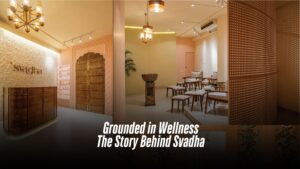
Grounded in Wellness: The Story Behind Svadha
Over the past decade, Bangladesh’s spa and salon culture has gone through a quiet but striking revolution. The once-flashy, first-service catered parlours have given way to curated wellness havens that prioritize experience over gimmicks. From Faux-Thai facades, a new design language is emerging. At the forefront of this transformation is Svadha, the country’s first salon to fully integrate Ayurveda into its core philosophy. But it’s not just their services that set them apart, it’s the atmosphere. Their aesthetic blends the royalty of Mughal architecture with the earthy soul of Marrakesh, creating a space that feels both grounded and luxurious. Svadha is a family-led vision brought to life by Rumjhum Fattah, her brother, Md Golam Rezwan, and sister-in-law, Behtarin Chowdhury Ridma. While the trio has long been a part of Bangladesh’s RMG sector, Svadha marks their first foray into the world of beauty and wellness, and they’re doing it on their terms. The name Svadha, derived from Sanskrit, beautifully translates to “self-care” and “self-love”—an ethos that defines everything the brand stands for. “At Svadha, we’re not here to sell beauty or grooming services,” says Rumjhum. “We’re here to create a space where people can slow down, tune in, and prioritize their well-being.” Svadha is located in the heart of Gulshan Avenue and comprises a total area of around 3300 square feet. The interior, designed by the creative minds at Studio R.A.R., is a visual and sensory ode to stillness, grounding, and mindful indulgence. “Svadha is a true embodiment of peace and tranquillity,” shares co-founder Behtarin Chowdhury Ridma. “From the lounge to the treatment rooms, we wanted every inch to feel like a retreat, where the stress of daily life simply melts away. To achieve that, we explored a palette of earthy tones and tactile, natural materials.” She pointed out that most salons in the city are built around speed and efficiency, often at the expense of comfort. “Everything is so fast-paced—walk in, get the service, walk out. There’s hardly ever a moment to truly unwind,” she reflected. At Svadha, the philosophy is deliberately different. The space is intentionally kept open and airy, avoiding unnecessary partitions or a heavy-handed layout. “We wanted to let the space breathe, just like our clients,” she added. There are no false ceilings or forced divisions; instead, the design embraces fluidity, allowing natural light and movement to flow freely. Catering to working women, Svadha brands itself as a wellness retreat. “Our clients come not just to look good, but to feel good. After long hours at work, they deserve to be unrushed, cared for, and truly pampered.” Drawing inspiration from Moroccan and Indian architectural traditions, the space features intricately carved wooden mirror frames, classic oil lamps, and a striking antique doorway that sets the tone from the moment you enter. A gentle water fountain hums in the background, further enhancing the atmosphere of calm. “We wanted to infuse the space with elements of nature and its calming rhythms,” shared Rumjhum. “The water fountain, placed thoughtfully within the layout, is a quiet homage to that intention, a gentle nod to movement and serenity. Throughout the space, you will find indoor plants too” Lighting, too, was carefully curated to complement this ambiance. There’s a deliberate avoidance of harsh, bright lights. Most areas are bathed in soft, ambient illumination, dimmed and mellow to encourage relaxation. However, in zones like the makeup and hair stations, where precision is key, the lighting is thoughtfully intensified to ensure clarity without disrupting the overall calm. One of the standout features of the salon is the textured wall next to the reception where the metal brand name is hung. There is also a graffiti wall, commissioned by a Fine Art student of Dhaka University where Mughal-themed flowers are painted. Every piece of furniture in the salon has been custom-crafted in-house. Each zone has been thoughtfully planned to serve its specific purpose, whether it’s a quiet waiting lounge, a private treatment room, or a styling station. Every detail, down to the custom-built furniture, typography on the walls, and curated lighting reflects Svadha’s vision of a wellness destination that feels both intimate and elegant. Written by Kaniz F Supriya
Read More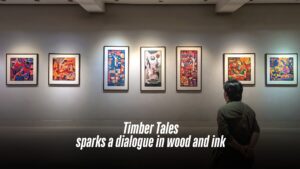
Timber Tales sparks a dialogue in wood and ink
The ongoing exhibition titled Timber Tales at La Galerie, Alliance Française de Dhaka invites audiences to experience the collaborative journey of three emerging artists who explore memory, process, and material through the art of woodcut printmaking. Within the exhibition, a faint, earthy scent of wood and ink hangs in the air. Walking into the gallery, some might find themselves pausing longer than expected, tracing the grain of the wood as if searching for their own stories between the lines. The exhibition features three artists—Rakib Alam Shanto, Shakil Mridha, and Abu Al Naeem—who express individuality through their woodcut prints. This contemplative exhibition is running from June 17 to June 25, 2025. Curated by the artists themselves, the exhibition reimagines the possibilities of woodcuts as a medium. Here, the tactile intimacy of carved timber meets the visual language of reflection, nostalgia, and search. As you wander through the space, individual voices emerge. Shakil Mridha’s work, with its minimalistic yet profound geometric forms, feels like a contemporary ode to Bangladeshi folk art, skillfully abstracting familiar motifs. Rakib Alam Shanto’s large-scale black-and-white pieces command attention, a powerful revival of a tradition, showcasing his remarkable focus. Abu Al Naeem’s pieces, often abstract, subtly reveal hidden figures, reflecting his continuous exploration of materials and techniques. Each artist, in their unique way, elevates woodcut beyond mere reproduction, transforming it into a medium of profound personal expression. And through that expression, each of their work reflects the heart of the creative process, where stories are carved into existence. At the heart of Timber Tales is a tribute to beginnings, to the mentor who shaped them, and to the space where it all began. Their acknowledgement of Professor Md. Anisuzzaman, whose generous guidance helped steer their vision, reveals the deeply collaborative ethos of the show. “This is where it all began—for the three of us,” reads a line from the exhibition note, underscoring the intimate bond between craft, community, and coming-of-age. In an era of digital immediacy, there’s something revolutionary about the deliberate slowness of woodcuts. And the three artists have breathed new life into the ancient art of woodcut. More than just a technique, it’s a dialogue between human touch and natural materials. Each frame holds a deeper narrative of tireless dedication—the careful selection of wood, the precise cuts, the methodical inking, and the final, expectant press. Open to all and continuing until 25 June 2025, Timber Tales will leave visitors with more than just images on paper. In a city rushing to reinvent itself, the exhibition feels like a pause, a reminder of our roots with a sense of belonging—to the artists, to the materials, and to the timeless, meditative act of making. Written by Samira Ahsan
Read More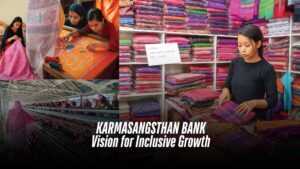
KARMASANGSTHAN BANK: Vision for Inclusive Growth
Karmasangsthan Bank is a unique state-owned social bank in Bangladesh, established in 1998 to turn unemployed youth into entrepreneurs. Its mission is to extend financial services to underserved communities and foster sustainable businesses. Literally translated as the “Employment Bank,” it empowers aspiring entrepreneurs to transform their ideas into sustainable ventures. Born from a national vision for inclusive economic development, the bank has dedicated itself to bridging the financial gap for underserved segments of society, particularly in rural areas. This focus on inclusive growth sets it apart from conventional commercial banks and makes it an essential instrument for national development. Under a government mandate and with initial capital of Tk 300 crore, Karmasangsthan Bank was created to tackle unemployment by funding small enterprises. Over time, government backing has expanded its loan pool to around Tk 4,500 crore, amplifying its reach. Its core purpose remains nurturing grassroots entrepreneurship and uplifting marginalised groups. Karmasangsthan Bank tailors its products to the needs of unemployed youth and small-scale entrepreneurs. Its flagship offerings include: Low-interest and interest-free loans for start-up ventures, microcredit schemes designed for first-time borrowers and special financing packages for persons with disabilities. The bank’s board unites professionals from financial and administrative backgrounds, ensuring strategic oversight and mission alignment. In November 2024, Dr AFM Matiur Rahman took the helm as the 14th chairman, while Arun Kumar Chowdhury guides daily operations as Managing Director. Their stewardship has driven both stability and innovation. With over 285 branches and 1,800 employees spanning every district and most upazilas, Karmasangsthan Bank brings its services to urban centres and remote villages alike. This footprint underscores its commitment to rural financial inclusion and fuels broader socio-economic development across Bangladesh. Beyond financing, Karmasangsthan Bank serves as a catalyst for community uplift. Its operations blend government policy, entrepreneurial mentoring, and localised development initiatives—proving that a bank can be a powerful tool for social transformation. To reach the unbanked, the bank is rolling out mobile banking apps, digital payment gateways, and online portals. These technologies bridge geographic divides, making services more accessible to rural and marginalised populations. Through initiatives like this, Karmasangsthan Bank continues to fulfil its mission of fostering a balanced economic structure by converting the population into productive manpower and reducing unemployment. Currently, Bangladeshi citizens aged 18 to 50 are eligible for loans up to Tk 5 lakh without collateral and up to Tk 75 lakh with collateral. Thanks to its outstanding performance across key indicators, Karmasangsthan Bank ranked first among state-owned specialised banks for the last two consecutive fiscal years. The government approved the construction of a 25-storey multi-purpose building atop a four-storey basement at a cost of Tk 260 crore. This project will be built on 37 decimals of land formerly belonging to the Times-Bangla Trust in Motijheel, Dhaka, now registered under the bank’s name. Since Karmasangsthan Bank operates under a similar model as Grameen Bank, the government should consider granting it full tax exemption. This measure would enable the bank to lower its interest rates further, providing greater support to unemployed and poor borrowers. Additionally, the nation would benefit from more affordable products, fostering a competitive market environment. Bank’s Performance Karmasangsthan Bank has lent Tk 18,000 crore to over 1.2 million youth, indirectly benefiting some 4.2 million people. Its recovery rate is about 96%. Currently, approximately 2,25,000 entrepreneurs—30% of whom are new each year and 40% of whom are women—tap into its schemes, with a total of about Tk 4,300 crore in outstanding loans. In the last fiscal year (July 2024–June 2025), Tk 2,838 crore was disbursed in self-employment loans to 1,25,000 entrepreneurs. Tracking job creation and enterprise growth provides clear evidence of its social footprint. The breakdown includes: Cattle fattening: Tk 1,595 crore (56.2%) to 76,744 individuals. Dairy farms: Tk 525.36 crore (18.5%) to 24,712 individuals. Fisheries: Tk 126.75 crore (4.5%) to 5,832 individuals. Poultry farms: Tk 15.43 crore (0.6%) to 745 individuals. Agro-based industries and nurseries: Tk 11.28 crore (0.4%) to 530 individuals. Commercial sector: Tk 160.35 crore (5.65%) to 7,309 individuals. Service sector: Tk 76 crore (2.65%) to 3,669 individuals. Small and cottage industries: Tk 53.84 crore (2%) to 2,531 individuals. Other sectors: Tk 275 crore (9.5%) to 2,100 individuals. During the same period, the bank earned Tk 408.37 crore in revenue against operational expenses of Tk 270.33 crore. Its pre-tax profit stood at Tk 138.04 crore, and it paid Tk 19 crore in advance corporate income tax. Customer Success Stories Rezaul Haque, a 45-year-old resident of Sundarpur in Paba Upazila (Rajshahi), transformed his life through commercial fish farming. With an initial loan of Tk 50,000 from the Rajshahi branch of Karmasangsthan Bank, Rezaul received subsequent training from the Department of Fisheries and the Department of Youth Development. Starting modestly, his venture expanded over 95 bighas of water bodies. Today, his investment has soared past Tk 1 crore, and he earns an annual income of about Tk 10 lakh. His journey not only provided him with financial stability but also inspired many local youths to explore similar opportunities, contributing to the region’s growing protein demand. Broadening Horizons in Aquaculture Another remarkable example is Borhan Uddin from Bagsara village. After securing a loan from the bank, Borhan invested Tk 75 lakh in a fish-farming business. With clear prospects for future expansion, his investment is expected to hit Tk 1 crore in the near future. His success story is a testament to how specialised loan products, combined with financial guidance, can spur rapid growth and foster entrepreneurship at the grassroots level. Retail and Small Business Beyond aquaculture, Karmasangsthan Bank has also empowered entrepreneurs in the retail and small-business sectors. For instance, Shahajahan Ali, owner of a local enterprise in Nawhata Municipality Market, has been utilising the bank’s credit support for over a decade to sustain and grow his business. Similarly, Mokbul Hossain, who runs a shoe store in the same market, successfully expanded his operations with consistent financial backing. Beef Fattening and Dairy To promote food security and create
Read More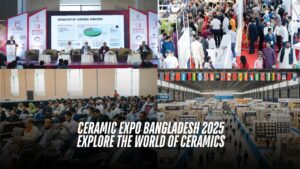
CERAMIC EXPO BANGLADESH 2025 EXPLORE THE WORLD OF CERAMICS
Ceramic Expo Bangladesh 2025 is fast approaching, promising to be the largest and most prestigious exhibition in the country. The event will bring together a wide range of manufacturers, innovators, professionals, and enthusiasts from both the local and global ceramic industries. The Bangladesh Ceramic Manufacturers and Exporters Association (BCMEA) will organize the event at the International Convention City Bashundhara (ICCB). This four-day event is more than just an expo – it’s a celebration of innovation, networking, and excellence in ceramics. Key Highlights of Ceramic Expo Bangladesh 2025 B2B & B2C Networking Opportunities Business-to-business (B2B) and business-to-consumer (B2C) sessions will allow exhibitors to showcase new products, technologies, and innovations to their target audiences. These sessions will help businesses explore opportunities for strategic collaboration and expansion. Awards & Recognitions An exciting feature of the event is honouring exhibitors with the Best Pavilion and Stall Design Awards. Exhibitors will design their pavilions and stalls based on their brand identity or how they wish to portray it to their target audience. Winners will be selected by a distinguished jury. A Lifetime Achievement Award has been introduced to honour an individual who has made a significant contribution to the development and growth of Bangladesh’s ceramic industry. Knowledge-Driven Seminars & Conferences The 2025 edition of the expo will host five insightful seminars and panel discussions. These sessions will feature prominent industry experts, architects, engineers, and thought leaders. Topics will focus on the future of ceramics, technological advancements, sustainability, and design innovations. Job Fair For job seekers, students, and professionals, Ceramic Expo Bangladesh 2025 offers a golden opportunity to connect with leading ceramic companies. Visitors will be able to submit their résumés to explore job opportunities with prominent ceramic manufacturers in Bangladesh. Visitor Engagement & Raffle Draw BCMEA will distribute exciting gifts and organise a raffle draw to appreciate and encourage maximum visitor participation. These activities aim to celebrate the continued support for the industry’s growth. Ceramic Expo Bangladesh 2025 proudly invites all to explore, exhibit, network, and learn through the event. It is a gateway to the future of ceramics and a grand opportunity for the ceramic industry to grow further. Written by Preety Dey
Read More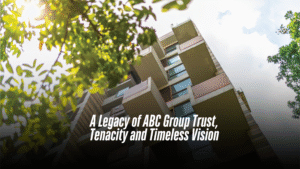
A Legacy of ABC Group Trust, Tenacity and Timeless Vision
In a business landscape where many joint ventures of the past century faltered under fractured trust and unchecked ambition, ABC Group shines as a beacon of integrity, resilience, and generational continuity. For over five decades, the organisation has not only transformed skylines but also redefined the very essence of partnership—proving that enduring success is built not solely on ambition, but on unwavering principles, a shared vision, and an unshakable commitment to people both within and beyond the company. “Partnerships rarely fail because of market forces,” reflects Subhash Chandra Ghosh, Chairman of ABC Group. “They collapse when trust erodes—when dishonesty, greed, or envy take root. Our survival has been anchored in three simple values: transparency in every transaction, fairness in every decision, and respect in every relationship.” This philosophy has guided ABC Group through the passing of its five founding partners, enabling a seamless transition of leadership to the next generation while preserving the spirit of its origins. Today, the group stands as a diversified conglomerate with four core divisions: ABC Limited (Construction), ABC Real Estate Limited (Property Development), ABC BPL (Ready-Mix Concrete Manufacturing & Supply), and the newly launched ABC FL (Facility Management Services). Each division plays a pivotal role in Bangladesh’s infrastructural and economic growth. Beyond construction and real estate, the group’s influence extends into the financial sector. The directors of ABC have been prominent founding shareholders of Mutual Trust Bank Limited (MTBL), one of Bangladesh’s most successful and trusted private banks. Rashed A. Chowdhury, the son of ABC’s founding chairman, Saifuddin Ahmed Chowdhury, now serves as Chairman of MTBL, further cementing the ABC Family’s legacy in nation-building across industries. The Genesis: Building Dreams from the Ground Up The story of ABC Group is intertwined with the birth of a nation. In 1972, in the stirring aftermath of Bangladesh’s independence, a bold vision took shape. Amirul Islam, his brother Nazrul Islam, and Saifuddin Ahmed Chowdhury—along with two associates—laid the cornerstone of Associated Builders Corporation (ABC) Limited. Soon thereafter, civil engineer Subhash Chandra Ghosh and architect Mostaqur Rahman joined the venture, forming a partnership that would one day redefine the country’s urban fabric. In those early days, ABC was not an empire—it was a dream defined by determination. With no heavy machinery, limited skilled labour, and scarce capital, the founders relied on resilience, strategic alliances, and sheer perseverance. Subhash Chandra Ghosh, then a young engineer, had begun his career at Yakub Limited earning a modest salary of 350 taka. When the company’s West Pakistani owner fled post-independence, Subhash and a colleague assumed leadership, keeping the operations afloat. It was during those turbulent times that fate brought him together with Amirul Islam—a meeting that would sow the seeds of an enduring legacy. Mr. Ghosh recalls with pride that his stake in the company was secured not through capital but through the strength of a handshake, a testament to an era when a man’s word was his bond. Forging a Future: The Rise of an Empire ABC’s first major breakthrough came with a two-crore-taka contract for the Bangladesh Machine Tools Factory, marking the beginning of its ascent. Landmark projects soon followed—Ashuganj Fertilizer Factory, Khulna Thermal Power Plant, and the Gorai Bridge—all setting new benchmarks in engineering excellence. Over the decades, ABC Group’s portfolio expanded to include national icons such as the Grameenphone Headquarters, North South University, BRAC University’s New Campus, and the Third Terminal of Hazrat Shahjalal International Airport. Currently, ABC Limited is building the prestigious Aga Khan Academy campus at Basundhara. By the late 1980s, ABC’s vision expanded beyond construction into real estate. In 1988, ABC Real Estate Limited (ABC REL) was born—a bold move at a time when the concept of apartment living was still in its infancy in Dhaka. From Concrete Foundations to Living Communities Challenges abounded: land scarcity, public skepticism toward apartment living, and the absence of clear registration laws. Yet, through meticulous planning, superior design, and uncompromising transparency, ABC Real Estate earned trust—one project at a time. The company has always approached the market with caution to avoid overambitious trading, a common pitfall in the real estate industry. Today, it has delivered more than 1,880 apartments across 70 projects in prime locations such as Uttara, Banani, Dhanmondi, Gulshan, Baridhara, and Chittagong. A crowning achievement is The Oasis at Ispahani Colony, an international-standard gated community in Moghbazar that spans 14.5 bighas. Completing 457 units within 70 months—despite various crises induced by the pandemic—is a true testament to ABC Real Estate’s planning and resilience. A New Vision: Affordable Excellence Beyond Dhaka Under the leadership of Srabanti Datta and Shougata Ghosh, ABC Real Estate is shifting its focus toward large-scale residential projects in mid-cost areas of Dhaka and its suburban localities. Their vision is clear: to provide quality housing with modern amenities accessible to the upper-middle class at reasonable prices. “Dhaka’s land prices have made premium housing unaffordable for many,” explains Srabanti Datta. “By developing well-planned communities in emerging zones, we can offer spacious living, green spaces, and modern facilities—without the exorbitant costs of the city center. With The Oasis, we are now confident that ABC has the best set of pragmatic ideas, skilled people, and strategic planning tools to successfully deliver massive projects beyond mere flashy brochures.” Upcoming projects like The Orchard exemplify this strategy, combining affordability with international standards. Additionally, the group is exploring expansion to Narayanganj, ensuring sustainable urban growth beyond the capital’s high value yet densely populated areas. Diversification & Innovation: The ABC Ecosystem Beyond construction and real estate, ABC Group has strategically diversified into ready-mix concrete (ABC BPL) and facility management (ABC FL), ensuring control over quality and service delivery across the board. ABC BPL is one of the country’s leading suppliers of ready-mix concrete, known for its precision, durability, and efficiency in high-rise constructions. ABC FL—the newly launched division—provides high-quality facility management services in Bangladesh, offering maintenance, security, and operational excellence for both residential and commercial properties. The Heart Behind the Helm: A Symphony
Read More
You Actually Want to Hang Out in! Brutown’s Got a Funky New Friend: Say Hello to Nervosa.
For those who enjoy café culture, a delightful spot has opened its doors to Dhaka’s vibrant crowd. Nervosa is a cafe located on Siddheswari Road, Dhaka, at the edge of a bustling neighbourhood—just above Brutown, which has long been a favorite in the heart of Bailey Road. Why Nervosa The name, “Nervosa,” is a deliberate nod to the beloved sitcom Frasier, where a fictional coffee shop of the same name served as a backdrop for the characters’ daily lives. Sabeel Rahman, CEO and Proprietor of BruTown and Nervosa, explains his choice with a playful intrigue: “The question of ‘Why Nervosa?’ is what makes it captivating. It draws attention, it’s a memorable name.” Consider Nervosa as the upscale, fancy, artistic neighbor of the popular cafe, BruTown, finding its niche in the community. Behind the Scenes Rehnuma Tasnim Sheefa, the principal architect of Parti.studio elaborates on the design philosophy: “Every design develops from a concept or a vision and if for a restaurant or a cafe, the branding has its influence as well. For Nervosa, that concept was built on strong character and a vibrant color palette, designed to draw a younger crowd into the cafe, as envisioned by the owner. When working in a public realm like cafes, as an architect I also had to focus on the psychological impact a person would have with the colors and the characters.” The color palette evolved gradually. Pale Orange took precedence, aligning with the theme initially, with striking illustrations bringing life to the walls. To make the illustrations stand out, a monochrome backdrop was introduced for the floors, ceilings, and other walls, allowing the boldly patterned and colored furniture to shine truly. The exposed brick on some of the walls adds a touch of urban grit, while the wooden flooring brings warmth and texture; keeping them aligned with the basic pale orange color. The cafe culture in Dhaka thrives on connection. Comfortable seating arrangements encourage heartfelt conversations, from an upcycled plush couch perfect for intimate gatherings to communal tables fostering spontaneous interactions. Nervosa goes a step further with cozy bookshelves stocked with comics and novels, perfect for anyone who wants to settle in with a good read. Instagrammable Spots Several strategically placed elements aim to create visually captivating ‘Instagrammable’ moments. The journey begins at the entry staircase, where a whimsical illustration introduces the cafe’s personality. Upon entering, a prominent neon light sign immediately catches the eye. Inside, a one-of-a-kind waffle mirror greets you at the entrance for your mirror selfies with your friends. Track lights are incorporated here to highlight specific areas, making them ideal for photos. “You will also find the neon lights in different spots around the cafe”, shares Architect Sheefa. The use of neon lights is an interior design trend in restaurants targeting younger crowds, particularly Gen Z. They create a visually appealing and Instagram-worthy atmosphere, making restaurants more attractive to social media-conscious customers, to create a unique and memorable visual experience. illustrations that speak to you To add character to the interiors, the beams and walls are filled with vibrant illustrations. In the beam above the counter, the illustrated characters resemble the target audience of the cafe, and how they interact and behave. Describing the artworks, Mashqurur Sabri, the artist, shares, “Nervosa walls are a burst of young energy and Dhaka madness — messy, loud, and full of heart. The hand-drawn, sketchy art style mixes raw lines with pops of bold, chaotic color — think warm reds, electric yellows, moody teals — capturing the city’s wild rhythm. From buzzing rickshaws to rooftop chill scenes, it’s the city on caffeine — vibrant, warm, and wide awake.” “When I think of Nervosa as perceived by the public, I wish it to be known as the most happening place in Siddeshwari,” says the owner, Sabeel Rahman. The vibrant interior, the playful name, and the strategic use of social media-friendly elements all point to a well-thought-out strategy. Nervosa isn’t just serving coffee; it’s serving an experience. And if the initial buzz is anything to go by, it’s an experience that Dhaka’s café-goers are eager to embrace. Written by Samira Ahsan
Read More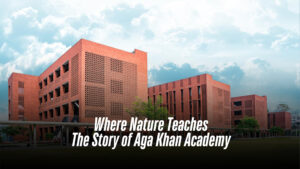
Where Nature Teaches: The Story of Aga Khan Academy
In Dhaka’s Bashundhara Residential Area, the Aga Khan Academy immediately catches your eye. Its warm brick walls, softened by greenery and a sparkling water channel, glow in the morning light. The building feels like a historical monument—orderly courtyards, intricate brickwork—yet the lively chatter of students reminds you this is a school—a place where learning blends seamlessly with nature’s rhythms. Bangladesh’s heritage that make it truly remarkable. Here, architecture becomes a canvas, interiors breathe with narrative, and every art installation stands as a tribute to the nation’s soul. Spanning in 17 acres, the award-winning Aga Khan Academy in Dhaka was developed through a collaboration between SHATOTTO Architecture for Green Living and Feilden Clegg Bradley Studios. The design draws inspiration from the region’s ancient Buddhist Mahaviharas, incorporating their architecture and philosophy into the campus. A clay model was used to visualise the design, helping stakeholders understand the campus’s spatial organisation before construction. Covering 74,150 square metres, this is Shatotto’s largest school project to date. The campus provides a green sanctuary within Dhaka’s urban environment. This academy represents a significant investment by the Aga Khan Development Network in Bangladesh’s future. As the fourth institution in a planned network of 18 Aga Khan Academies across Africa, South and Central Asia, and the Middle East, the Dhaka campus connects students to a wider academic and cultural community. Other campuses are located in Mombasa, Hyderabad, and Maputo, forming a global network focused on pluralism, leadership, and excellence. To support education from nursery to diploma level, Aga Khan Education Services required a permanent campus. This presented a challenge in a dense city like Dhaka. The project is designed to be scalable and sustainable, planned in seven construction phases. Since its first phase launched in September 2022, the academy has offered an integrated environment that connects nature with education, providing a calm setting within Bashundhara’s urban area. The Dhaka campus currently enrolls 750 students, with plans for expansion to 1,200. The masterplan includes residential facilities designed to accommodate students and staff from across Bangladesh and other countries. This lays the foundation for a diverse and inclusive learning environment upon full implementation. The vision for this project was led by Architect Rafiq Azam of Shatotto Architecture for Green Living, who incorporated Bangladesh’s heritage into the design. He conceptualized it as an “archaeological site, like our ancient monasteries.” Co-lead Architect Peter Clegg of Feilden Clegg Bradley Studios contributed global standards and technical precision. A central amphitheatre serves as a space for performances and gatherings. The adjacent Maidan, a large open playground, accommodates student activities, serving recreational and social functions. Brick buildings surround these shared areas on a planted base, offering unobstructed views of the Maidan from all directions. The Maidan functions as the campus’s central point, reflecting the spirit of ancient Buddhist Mahaviharas. These elements collectively support an environment where the physical space contributes to the educational process. “The school itself teaches,” says Rafiq Azam, lead architect of the Aga Khan Academy. “Students learn from books inside the classroom, but when they step outside, they begin to notice surroundings on their own — how water flows, how flowers bloom, how the sun moves across the sky, and how the breeze blows from a certain direction.” He adds, “This kind of learning happens naturally, guided by the environment rather than just by the teacher. The process encourages students to learn independently, beyond what is taught in the classroom.” Rafiq Azam emphasised the local context influencing the design, noting the significance of greenery, water, and rain in Bangladesh’s fertile landscape. This sensitivity is integrated into the campus layout, where natural elements are part of daily student life. The academy’s design heavily features brick, chosen for both its practical and aesthetic qualities, consistent with Bangladesh’s architectural history. Each brick is carefully positioned. According to Feilden Clegg Bradley Studios, brick was selected to revive local craftsmanship and to contrast with the render and concrete common in surrounding new buildings. The construction method involves deeply embedded mortar between brick pairs, a technique seen in historical sites, ensuring longevity and a timeless appearance. This strategic use of locally sourced brick, combined with Bangladeshi brick patterning, creates a cohesive campus. It establishes a hierarchy of spaces through its brickwork. Facade perforations allow daylight into interior corridors, using traditional techniques. Recessed windows, screens, and protruding brick columns provide shading for classrooms and create covered balconies and walkways. Classrooms are oriented to minimise solar gain in summer, with external walkways and adjacent buildings providing passive solar shading from the morning sun throughout the year. This ensures adequate daylight and outdoor views. Architects designed these spaces for passive heating and shading year-round to minimise energy consumption. This climate responsiveness was achieved through extensive sun pattern analysis and wind flow direction studies, optimising light and ventilation. The academy’s character reflects many original Buddhist universities in Bangladesh. It is defined by the massing and materiality of brick buildings located on a sculpted and planted landscape base surrounding the central Maidan. Alongside the main field, the complex includes smaller connected areas featuring concrete canopies for shelter, along with brick benches and planters. These peripheral spaces serve as transitions between the central Maidan and more intimate interior areas. Spaces are tailored for different age groups; for example, the senior courtyard offers shaded zones under planted trees for focused group activities. The assembly court is simple, with four ‘Dhaak trees,’ which inspired Dhaka’s name. The primary central courtyard accommodates larger gatherings and includes an amphitheatre built around a sand pit. This pit is designed to collect rainwater during heavy rainfall, holding up to 170 mm of water for approximately 10 to 30 minutes. The campus masterplan organises spaces into four zones—Intellectual, Moral, Physical, and Spiritual—supporting a holistic educational philosophy. Each block is designed for a specific function. The Academic Block, a central hub, contains administrative workstations, learning centers, group study areas, and a lecture hall, along with a terrace. Its white-walled classrooms vary in
Read More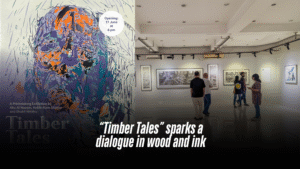
“Timber Tales” sparks a dialogue in wood and ink
The ongoing exhibition titled Timber Tales at La Galerie, Alliance Française de Dhaka, invites audiences to experience the collaborative journey of three emerging artists who explore memory, process, and material through the art of woodcut printmaking. Within the exhibition, a faint, earthy scent of wood and ink hangs in the air. Walking into the gallery, some might find themselves pausing longer than expected, tracing the grain of the wood, as if searching for their own stories between the lines. The exhibition features three artists—Rakib Alam Shanto, Shakil Mridha, and Abu Al Naeem—who express individuality through their woodcut prints. This contemplative exhibition is running from June 17 to June 25, 2025. Curated by the artists themselves, the exhibition reimagines the possibilities of woodcut as a medium. Here, the tactile intimacy of carved timber meets the visual language of reflection, nostalgia, and search. As you wander through the space, individual voices emerge. Shakil Mridha’s work, with its minimalistic yet profound geometric forms, feels like a contemporary ode to Bangladeshi folk art, skillfully abstracting familiar motifs. Rakib Alam Shanto’s large-scale black and white pieces command attention, a powerful revival of a classic tradition, showcasing his remarkable focus. And Abu Al Naeem’s pieces, often abstract, subtly reveal hidden figures, reflecting his continuous exploration of materials and techniques. Each artist, in their unique way, elevates woodcut beyond mere reproduction, transforming it into a medium of profound personal expression. And through that expression, each of their work reflects the heart of the creative process, where stories are carved into existence. At the heart of Timber Tales is a tribute to beginnings, to the mentor who shaped them, and to the space where it all began. Their acknowledgement of Professor Md. Anisuzzaman, whose generous guidance helped steer their vision, reveals the deeply collaborative ethos of the show. “This is where it all began—for the three of us,” reads a line from the exhibition note, underscoring the intimate bond between craft, community, and coming-of-age. In an era of digital immediacy, there’s something revolutionary about the deliberate slowness of woodcut. And the three artists have breathed new life into the ancient art of woodcut. More than just a technique, it’s a dialogue between human touch and natural materials. Each frame holds a deeper narrative of tireless dedication—the careful selection of wood, the precise cuts, the methodical inking, and the final, expectant press. Open to all and continuing until 25 June 2025, Timber Tales will leave visitors with more than just images on paper. In a city rushing to reinvent itself, the exhibition feels like a pause, a reminder of our roots with a sense of belonging—to the artists, to the materials, and to the timeless, meditative act of making. Written By Samira Ahsan
Read More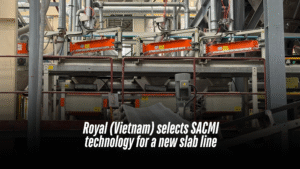
Royal (Vietnam) selects SACMI technology for a new slab line
The heart of the order is the new Continua+ 2180, equipped with cutting-edge digital decoration solutions Following installation of the new SACMI Continua+ 2180, Royal (Vietnam) becomes the first Asia-Pacific group to equip itself with SACMI technology for on-surface and through-body slab decoration. Moreover, the line is digitally coordinated with Deep Digital solutions, supplied here in an all-round configuration: two DHD digital wet decorators and a DDG digital grit-glue decorator. The new line will allow Royal to expand its range by creating new products with unmatched three-dimensional ‘material’ effects, all the strength and durability of ceramic, and a look that mirrors the aesthetics of natural materials. This important investment decision was not motivated by the innovative forming and decorating technology alone: equally crucial was SACMI’s ability to supply the complete plant, from body preparation (with two spray dryers and relative spray-dried powder conveying/storage systems) to firing in a high-efficiency roller kiln. Already strongly positioned on international markets, Royal has now – with SACMI – taken quality in these high-added-value segments to the next level. For example: the manufacture of ceramic countertops and furnishing accessories, with all the advantages Continua+ has to offer in terms of versatility, productivity and fully flexible control of size and thickness, in coordination with all the digital devices on the line.
Read More
Akij Tableware Art of Plating: Season 2 Crowns the “Plating Maestro”
The curtain has drawn on the remarkable journey of Akij Tableware Art of Plating: Season 2, the pioneering reality show that reimagined tableware as a medium for creative expression and showcased the artistry of modern plating. Following weeks of intense competition, visually striking presentations, and exceptional culinary performances, the grand finale—held on May 16, 2025—served as a fitting conclusion to a season defined by innovation and excellence. Md. Golam Rabby emerged victorious as the champion, taking home the Plating Maestro title along with BDT 10,00,000 along with a professional plating course, national media exposure, and an exclusive Akij Tableware dinner set. The competition was fierce, with equally impressive performances by the runners-up: Iffat Jerin Sarker, awarded Plating Icon (1st Runner-up), received BDT 5,00,000; Dr. Rawzatur Rumman, crowned Plating Maverick (2nd Runner-up), won BDT 3,00,000; Homayun Kabir and Nawsheen Mubasshira Rodela, honored as Plating Masterminds (4th and 5th place respectively), each received BDT 1,00,000. Hosted across Banglavision, RTV, Deepto TV, and streaming on Chorki, Akij Tableware Art of Plating: Season 2 captivated audiences nationwide with its unique blend of tradition and innovation. Contestants turned beloved dishes into visual and gastronomic masterpieces, judged on aesthetics, technique, and culinary understanding. Akij Tableware Art of Plating: Season 2 redefined how we experience food—elevating it from everyday necessity to a dynamic, visual art form. The show celebrated creativity, precision, and innovation, turning each plate into a canvas where flavor met form. Throughout the season, contestants pushed boundaries, transforming ingredients into stunning, story-driven presentations that delighted both the eyes and the palate. More than a competition, this season launched a new movement in culinary expression, inspiring audiences to rethink how food is seen, served, and appreciated. And the journey isn’t over—a new season is coming soon, promising fresh talent, bold ideas, and next-level plating artistry. To stay updated on what’s next, follow www.aop.com.bd and join the evolution of food into a true visual experience.
Read More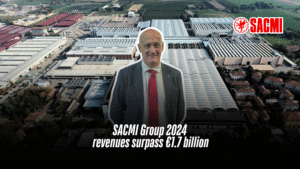
SACMI Group 2024: revenues surpass €1.7 billion
The yearly financial statement – approved yesterday, 16th May, during the Parent Company Shareholders’ Meeting – highlighted a net equity of more than one billion euros, growing margins and financial solidity. 2024 also saw the drafting of the first Group Sustainability Plan. Paolo Mongardi, President of SACMI, states: “Sustainability is the fuel of future competitiveness. We continue to invest in people and remain focused on the values that have guided SACMI’s enduring worldwide success” Imola, 17th May 2025 – SACMI closes 2024 with sales revenues of 1.728 billion euros. Despite the complex international economic and geopolitical backdrop, the company’s economic and financial fundamentals proved to be sound. For the first time, net equity exceeded one billion euros (1.055 billion, +172 million compared to 2023) while EBITDA settled at over 323 million euros and EBIT at 236 million. Net profit exceeded 200 million. These were the highlights of the Consolidated Financial Statement, presented yesterday evening, 16th May, at the Parent Company’s (SACMI Imola) Shareholders’ Meeting. “2024 was a solid year that went beyond expectations”, pointed out the President, Paolo Mongardi. “SACMI’s forward-thinking strategy rests on solid foundations and fully embraces the global drivers of digitalization and sustainability”. The year saw a continued focus on the core businesses, confirming the sterling reputation of – and customers’ confidence in – SACMI products across all sectors. In parallel with the to-be-expected slowdown in the ceramic sector – the result of international tensions and the sluggish global construction market – the Rigid Packaging, Advanced Technologies, Packaging & Chocolate sectors all performed excellently, driven by highly dynamic markets receptive to innovation. Investment remained consistently high in 2024 at 71 million euros, in line with the previous year, with a strong focus on innovation (276 new patent applications in 2024 alone, over 6,200 in the Group’s history) and training (over 94,000 hours). In parallel, SACMI confirms its role as a key player in the manufacturing industry’s ecological transition: during the year it presented innovative firing processes (e.g. electric), new process control solutions (thanks also to the acquisition of a majority share in Italvision in 2024), plus new eco-compatible standards, processes and materials in the packaging sector. “Sustainability is the key to future competitiveness”, explains President Paolo Mongardi. “We continue to invest in people by focusing on our values, which have consistently guided SACMI to worldwide success.” The green commitment is also evident at Governance level: the obligations of the new European CSRD (Corporate Sustainability Reporting Directive) were brought forward to 2024 and the first Group Sustainability Plan – an ambitious project that details actions and goals along the entire value chain, from suppliers to local communities – was drawn up. In the ESG sphere, SACMI has strengthened monitoring of indirect emissions linked to the use of its products and plants: this is part of an approach that centers on eco-design and the entire product life cycle to ensure processes are truly circular and impacts are minimized. The share of self-produced renewable energy is also growing (2.6 million kWh), the goal being to progressively decarbonize production facilities. On the employment front, the Group had a total of 4,756 employees at the end of 2024, with over 50% of new hires aged under 30. Close collaboration with universities and research facilities also continued. Ties with local communities – a part of SACMI’s DNA since its founding – became even stronger in 2024, with 90% of procurement networks consisting of local suppliers. Over the three-year period, the company also donated 2.4 million euros to healthcare, educational, safety, inclusion, sports and cultural projects. The year 2024 was a special one for SACMI, with the company reaching the milestone of its 105th anniversary. “We enter 2025 aware of not just the challenges but also the opportunities”, concludes the President, Paolo Mongardi, “with all the confidence that only a long history of innovation, solidity and responsibility can provide”.
Read More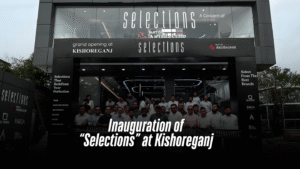
Inauguration of “Selections” at Kishoreganj
AkijBashir Group has recently expanded its footprint with the launch of a new showroom of its brand emporium, Selections, in Kishoreganj. Guided by the motto – “Select from the Best”, Selections was first introduced in October 2022, with the vision of offering customers a one-stop destination for all products under the AkijBashir Group umbrella. Prior to this, six flagship showrooms were inaugurated in key locations across the country—Banani in Dhaka, Agrabad Access Road in Chittagong, Gazi Burhan Uddin Road and Pathantula in Sylhet, Shimultola in Savar, and Keya Hall Road in Tangail. Since its inception, Selections has steadily earned the trust and attention of a wide customer base. To carry forward this momentum, the latest showroom has been launched in Dubail More, near Gaital Bus Stand, Sadar Kishoreganj. The store showcases a wide-ranging collection of ceramic tiles, boards, doors, sanitaryware, bathware, and tableware —bringing all of AkijBashir Group’s renowned brands under one roof. The inauguration ceremony was graced by the presence of Mohammod Khourshed Alam, Chief Operating Officer of AkijBashir Group, who officially inaugurated the showroom by cutting the ribbon. Distinguished guests from the group were also in attendance, including Mohammed Ashraful Haque, General Manager of Sales at Akij Ceramics; Md. Shahriar Zaman, Head of Marketing; Bishwajit Paul, Head of Sales at Rosa; and Md. Hamidur Rahman, proprietor of HS Tiles and Sanitary Gallery. During the event, Mr. Mohammod Khourshed Alam shared, “Our vision with ‘Selections’ has always been to bring the finest AkijBashir Group products under one roof, helping customers elevate their interiors. The Kishoreganj showroom is another step in that direction, offering a wide selection of premium tiles, sanitaryware, faucets, boards, and doors—all curated for discerning buyers”
Read More
Global Spotlight: CERAMICS CHINA 2025 Debuts First 720+ Exhibitors List!
Marking its 39th edition, CERAMICS CHINA—the world’s largest annual event for ceramic equipment and materials—will grandly open in Guangzhou on June 18th-21st Hundreds of exhibitors from over 20 countries and regions will be spread across SEVEN exhibition halls in Area A of the Canton Fair Complex, strategically organized by product categories and business types. Hall 1.1 and Hall 2.1 feature decorative materials, raw and auxiliary materials, refractories, and wear-resistant materials; Hall 3.1 is a concentrated display of foreign pavilions, international enterprises, and well-known brands; Hall 4.1 and Hall 5.1 mainly focus on digital and intelligent technologies, automation equipment, abrasive, tools, and spare parts; Hall 6.1 gathers the most representative equipment enterprises for ceramic tableware and sanitaryware; Hall 8.1 will highlight tile design, innovative processes, and advanced materials. By late April, Halls 1.1-6.1 are fully sold out, and Hall 8.1 is 90% booked with limited space remaining. SECURE YOUR BOOTH NOW! CERAMICS CHINA is not only the exhibition of the largest scale of its kind in the world, but also the most comprehensive in terms of exhibit variety. It offers an all-encompassing range of equipment, materials, accessories, and services—covering the entire production process from raw material processing to finished product packaging and warehousing. One can find advanced equipment, cutting-edge technologies, and innovative solutions tailored to their production needs at CERAMICS CHINA whether it’s for building ceramics, ceramic sanitaryware, ceramic tableware, art ceramics, garden ceramics, or even electrical ceramics, high-tech ceramics, glass, or stone product. As of May 5th, the total number of registered exhibitors has exceeded 720. To facilitate visitors in accessing exhibitor information and planning itineraries in advance, the organizer has decided to release the first batch of exhibitor list to global ceramics industry professionals ahead of schedule. Click to download CERAMICS CHINA 2025 Exhibitor List CERAMICS CHINA attracts industry professionals from across China and around the world annually with its massive scale, numerous exhibitors, diverse exhibits, and exciting events. The previous edition (2024) accommodated 81,858 visits of visitors and buyers from 72 countries and regions. It is projected that this year’s exhibition will draw attendees from over 80 countries and regions, with total participation expected to reach 100,000 visits. June 18-21, Join us in Guangzhou. Don’t miss out!
Read More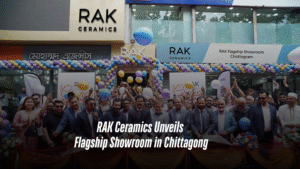
RAK Ceramics Unveils Flagship Showroom in Chittagong
RAK Ceramics, the world’s number one multinational tiles brand, has inaugurated a flagship showroom in Kazir Dewri, the heart of Chittagong. With a unique combination of world-class premium tiles, sanitary ware and modern bath solutions, RAK Ceramics is ready to transform customers’ dream homes or modern workplaces. RAK Ceramics’ new showroom is designed to offer a unique experience of sustainable quality, a touch of luxury, and cutting-edge design. Location: H. Tower, 889, Noor Ahmed Road, Kazir Dewri, Chittagong.
Read More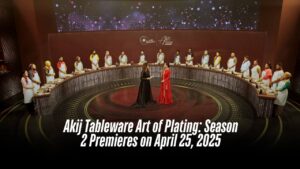
Akij Tableware Art of Plating: Season 2 Premieres on April 25, 2025
Get ready for Akij Tableware Art of Plating: Season 2, premiering April 25, 2025, and turning food into art! Airing weekends on Bangla Vision at 8:15 PM, RTV at 7:10 PM, Deepto Television at 9:30 PM, and streaming on Chorki with new episodes every Friday and Saturday, this vibrant reality show celebrates Bangladesh’s culinary soul. Rooted in Bengali traditions of family and hospitality, contestants transform dishes like fish curries and creamy dal into visual poetry, blending heritage with modern flair. Following its 2022 debut, Season 2 brings high-energy challenges and showcases local talent, from aspiring chefs to home cooks, competing for the “Plating Maestro” title. The grand prize includes BDT 10,00,000, a professional culinary course, national media exposure, and an exclusive Akij Tableware dinner set. With a BDT 20,00,000 prize pool, runners-up and top participants earn cash, certificates, and recognition. Guided by renowned chef Daniel C. Gomez, contestants craft edible masterpieces, judged on aesthetics, technique, and culinary insight after auditions at Hatirjheel Amphitheater. Tune in to Art of Plating: Season 2 to witness a movement redefining dining as a feast for the eyes and soul, where every plate tells a story!
Read More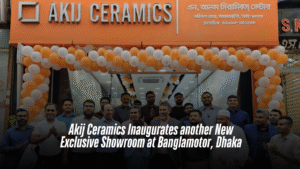
Akij Ceramics Inaugurates another New Exclusive Showroom at Banglamotor, Dhaka
Akij Ceramics, the leading brand in Bangladesh’s ceramic tile industry, has reinforced its market presence with the grand opening of another exclusive showroom at Banglamotor, Dhaka—a prime hub for the country’s tile market. A six-time consecutive winner of the Best Brand Award and Super Brand Award, Akij Ceramics continues to set industry benchmarks through innovation, superior quality, and an unwavering commitment to its “Promise of Perfection.” Staying true to its customer-centric approach, the brand has inaugurated its newest business associate showroom, “N. Alam Ceramic Centre,” located at 2/1 Poribagh Road, Banglamotor, Dhaka. The inauguration ceremony was held on April 17, 2025 (Thursday), with Mohammad Khourshed Alam, Chief Operating Officer of Akij Bashir Group, presiding as the chief guest. Distinguished attendees included Mohammed Ashraful Haque, General Manager (Sales) of Akij Ceramics; Md. Shahriar Zaman, Head of Marketing, AkijBashir Group; Bishwajit Paul, Head of Sales (ROSA); and Mohammad Noor A Alam Bhuyan, proprietor of N. Alam Ceramic Centre. Designed to offer an unparalleled customer experience, the showroom features cutting-edge product displays showcasing Akij Ceramics’ latest tile designs and size variations. Enhanced with modern furniture and innovative display tools, the spacious outlet ensures a premium in-store experience. With over 130 state-of-the-art showrooms across Bangladesh—both company-owned and business-associated—Akij Ceramics stands as the largest tile manufacturing and distribution brand in the country. The inauguration of the Banglamotor showroom marks another milestone in the brand’s journey to deliver flawless service and excellence to its valued customers.
Read More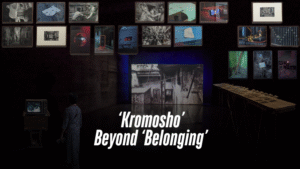
‘Kromosho’: Beyond ‘Belonging’
In the middle of the 2000s, a young Munem Wasif started sifting through Old Dhaka’s veins with his aged friend Zenit—a mechanical artifact from the Soviet era. His 2012 photography masterwork “Belonging,” which would revolutionize visual storytelling in Bangladesh’s art scene, was the culmination of a journey that began with this. Similar to the constantly flowing dark waters of Buriganga, which has seen Dhaka undergo changes, Wasif’s own artistic endeavors have veered through several stages throughout time. His work has continuously pushed audiences to look past the obvious, from “Seeds Shall Set Us Free” to “Collapse.” But despite all of these adventures, one thing stayed the same: his strong, unwavering bond with Old Dhaka. Munem Wasif is doing a solo show in Dhaka after nearly 16 years. Titled “Kromosho,” the show is currently ongoing at the capital’s Bengal Shilpalay. Tanzim Wahab served as the exhibition’s curatorial advisor, Iftekhar Hassan as a project assistant, and Dehsar Works as the architectural designer. It is open to everyone and will end on May 31, 2025. “I felt like something was lacking as soon as ‘Belonging’ was released. I felt that I just got the surface of the people and their celebrations; I couldn’t reach the core of their daily existence, the ‘life’ of Puran Dhaka. That’s when I thought of creating “Kheya”l. This exhibition is like a testament to my last two decades of transformation,” remarked Wasif when asked about “Kromosho”. The opening at Bengal Shilpalay was buzzing with energy as art lovers gathered to witness what promises to be one of the most memorable exhibitions in recent times. The exhibition unfolds like a carefully composed symphony in three movements. Starting from Wasif’s ethereal black-and-white photographs from the ‘Belonging’ era, now in dialogue with new color works from ‘Stereo.’ This juxtaposition creates a fascinating tension between past and present, memory and reality. At ‘Kheyal,’ the filmic meditation about what pulses through Old Dhaka’s veins. At ‘Shamanno’ and ‘Paper Negative,’ the installations blend documentation with imagination, challenging our perceptions of what is real and what is remembered. From a critical viewpoint, Old Dhaka represents a ticking time bomb—overcrowded and decaying, it’s an ugly relic of our greed and collective neglect. But Wasif’s work reveals depths hidden in plain sight: the “life” amongst all these. Beyond the obvious chaos lies a world of hidden poetry. This is what ‘Kromosho’ captures so brilliantly—not just images of a place, but its very essence. The exhibition becomes a mirror, asking questions about what we preserve and what we discard in our relentless march toward modernity. In an age of rapid urbanization and cultural amnesia, Wasif’s work serves as both archive and elegy, reminding us of some stories that cannot be captured through cameras or words. To experience its truest essence, you have to be there in flesh and psyche. As visitors move through the gallery, they’re invited not just to see, but perhaps to introspect. In this sense, ‘Kromosho’ transcends being merely an art exhibition; it becomes a conversation, a homecoming, and, most importantly, a call to witness.
Read More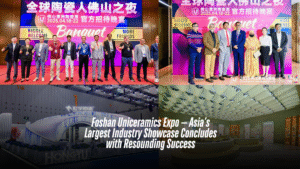
Foshan Uniceramics Expo — Asia’s Largest Industry Showcase Concludes with Resounding Success
2025 Foshan Uniceramics Expo Concludes Successfully, Global Ceramic Industry Gathers for the Event. From April 18 to 22, the 2025 Foshan Uniceramics Expo was successfully held at the Foshan Tanzhou International Convention and Exhibition Center. As the biggest ceramics expo in Asia and a benchmark for the industry, this year’s event brought together over 600 brands from the ceramic, sanitary ware, and equipment & materials sectors, covering the entire industrial chain and showcasing the world’s most cutting-edge new products, designs, technologies, equipment, and materials. For this year’s exhibition, the international participation reaches new heights. 2025 Foshan Uniceramics Expo attracted overseas brands from Italy, Turkey, Japan, Germany, Australia, and other countries, with Indonesian ceramic brands making their debut as a group. The equipment and materials section highlighted its international appeal, featuring continued participation from leading companies in Italy, Germany, Turkey, and other nations, along with new exhibitors from additional countries. Moreover, professional buyers from 85 countries and regions attended, including distributors, traders, engineering firms, and ceramic manufacturers, further solidifying the exhibition’s global influence. Foshan Uniceramics Expo remains committed to its mission of “Bridging world ceramics to China, and China’s ceramics to the world.” Moving forward, it will continue to foster deeper exchanges and cooperation in the global ceramics industry, injecting new vitality into its international development. Stay tuned for the next edition!
Read More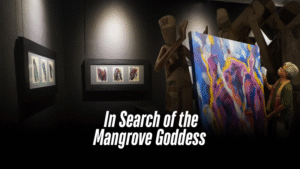
In Search of the Mangrove Goddess
Exploring the Sundarbans’ cryptic mangroves may be a weird, larger-than-life experience. When danger occurs in this wide wilderness, instinct frequently prompts one to seek spiritual protection. In such cases, the Sundarbans’ guardian spirit—Bon Bibi or Bono Bibi—is invoked. Bon Bibi is revered by the local forest dwellers as the divine guardian of the region’s treacherous environment. From April 4 to April 20, the Kalakendra gallery at the capital’s Lalmatia featured “In Quest of Bono-Bibi,” a mixed-media solo exhibition by artist Saidul Haque Juise. Juise, known for his precise craftsmanship, bright masks, and three-dimensional compositions, returned with a solo display following a long absence. Bon Bibi’s mythology is unique in that it combines both the Islamic and Hindu traditions, and it is commonly held that invoking her name in times of crisis promises divine assistance. The stories related to Bon Bibi are woven in a rich tapestry of mythology, which prodded Juise’s psyche when he was a child. Later in life, deeply touched by the Sundarbans’ environmental deterioration, he created this body of work as a lament and devotion to nature. This anthology, with its recurring themes of environmental concern and political overtones, combines lyrical extracts from folklore or shloks related to Bon Bibi with his own storytelling. The birth of these artworks dates back to the COVID pandemic. A time when despair loomed large. It was during this emotional upheaval that the artist Juise channeled his sorrow, frustration, and fear into a series of expressive sketches. Using vibrant shades of black, green, red, and blue— which are reminiscent of traditional Bangladeshi folk pottery— Juise stained his pages with raw emotion. Later, by combining various materials, such as twisted metal wires, paint, ink, handmade paper, newspaper pieces, etc., Juise enhanced the series even further. He was able to convey Bon Bibi’s holy force and the forest’s ethereal essence through these components. His line drawings smoothly blend with his pen and ink pieces to create complex collages that have a vibrant yet delicate vibe. In the meanwhile, the collection gains a tactile, even unearthly quality from his wire sculptures. The series gives viewers a deep feeling of Bon Bibi’s pervasive atmosphere. Along with his technical finesse, Juise added a unique Bengali flavor to the pieces. He skillfully combined the forms of people, animals, and insects to create flowing silhouettes that convey both motion and motionlessness. These shapes convey a duality: sadness that is subdued yet evident and fury that is controlled but strong. In doing so, Juise creates a collection of work that is both visually pleasing and profoundly significant by balancing artistic form with emotional weight. “In Quest of Bono-Bibi” stands much like an artistic diary that procures the artist’s personal reflections, cultural memory, and the urgent call for ecological reverence. It bridges folklore and modernity, spirituality and artistry—ultimately offering a visual testament of healing and harmony between humans and the natural world.
Read More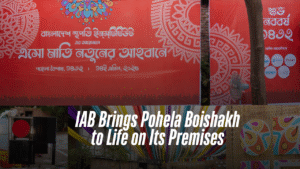
Institute of Architects Bangladesh Brings Pohela Boishakh to Life on Its Premises
The Institute of Architects Bangladesh (IAB) welcomed the Bengali New Year in vibrant style, hosting its first-ever Pohela Boishakh celebration on its premises. Titled “Esho Mati Notuner Ahobane”, the event was a colourful and cultural affair that reached beyond the architectural fraternity. Architects’ spouses, children, and extended family were warmly welcomed. The idea was simple: to celebrate the new year and the people who stand behind the scenes of every great architect. Festivities began at 3 PM, as the rhythmic beat of traditional dhol set the tone. Architect Asif M Ahsanul Haq, Convener of the Bengali New Year Celebration Committee, opened the event, inviting everyone into the heart of the celebration. With warm smiles and colorful attire, attendees embraced the spirit of community and enjoyed the laughter and tradition with their extended family. The IAB grounds were transformed into a festive fair, with interactive cultural corners drawing crowds throughout the day. Children gathered around clay artists and potters, their hands deep in clay, learning to mold traditional shapes. Nearby, shitol pati (cooling mat) weavers demonstrated their age-old techniques, encouraging young participants to try their hand at weaving. A painting zone was also set up, where children were free to create without the pressure of competition. Their artwork was later displayed, showcasing unfiltered creativity and color. Laughter echoed from the crowd gathered around the Putul Nach (puppet dance) and magic show, where entertainment delighted audiences of all ages and reminded everyone of the charm of folk performances. At the heart of the event was a bustling Meena Bazaar, alive with the flavors of tradition. Stalls served familiar favorites—muri, murki, naru, moya, samosa, beguni, lemonade, and kacha aam er shorbot—while architects and their families showcased their creative talents through stalls featuring homemade food, traditional sarees, books, paintings, and handmade crafts. It was a beautiful blend of personal passion and cultural pride. Major industry sponsors, including Berger Paints Bangladesh, Italiano Marble and Granite, Indigo Marble and Granite, Tilottoma Group, and Space Couture, added their own festive touch. Their vibrant booths offered free face art, portrait sketches, and a variety of Bengali snacks and refreshments, contributing to the lively spirit of the day. As the sun began to set, the stage came alive with folk songs and traditional dances performed by members of the architectural community. The soulful performance by Sadhu Songo, a renowned Lalon music troupe, captivated the audience with its spiritual melodies. The evening came to a heartfelt close with a collective rendition of “Esho He Boishakh,” followed by heartfelt closing remarks from Professor Dr. Abu Sayeed M Ahmed, President, and Professor Dr. Masudur Rashid, General Secretary of the Institute of Architects Bangladesh. The night concluded with a warm, memorable dinner under the open sky—an evening to remember. This landmark celebration was not just about welcoming a new year, it was about embracing shared roots, honouring cultural expression, and celebrating the bonds that make up the architectural community.
Read More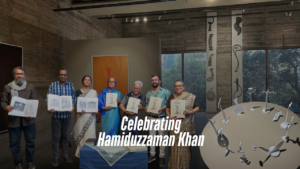
Celebrating Hamiduzzaman Khan
From 31 January to 15 March, the first-floor gallery of the capital’s Bengal Shilpalay transformed into a mesmerizing display of incredible sculptures and paintings. Titled “Hamiduzzaman Khan,” the spectacular exhibition organized by Bengal Arts Programme honored the life and works of Hamiduzzaman Khan, one of Bangladesh’s most distinguished sculptors. The inauguration took place on Jan 31, graced by the presence of artist and art writer Mustafa Zaman; the director general of Bengal Foundation, Luva Nahid Choudhury; prominent Bangladeshi-Spanish artist Monirul Islam; and architect Mustapha Khalid Palash. Neatly curated by the esteemed Mustafa Zaman, the exhibition was a visual diary of Hamiduzzaman’s lifelong dedication to modern experimental art, which provided visitors with a profound insight into his artistic journey. Some pieces were delicate and intricate, while others were monumental and commanding. His use of geometric abstraction and semi-abstract forms is a testament to his imagination and craftsmanship. The artist has spent decades exploring new artistic dimensions. His ability to transform objects into unique sculptural forms has captivated art lovers even beyond borders for decades. The exhibition at Bengal Shilpalay featured quite a big collection of his artworks, showcasing his talent across multiple mediums including metal and stone sculptures, watercolor paintings, and acrylic paintings inspired by his sculptures. It also showcased some of his sketches, exhibition catalogues, and books on his art. The curator, Mustafa Zaman, praised the artist’s innovative approach to form and structure. He remarked, “Hamiduzzaman sir has consistently delved into the essence of objects, transforming and redefining their shapes in extraordinary ways. His creations showcase decades of dedication and artistic exploration, reflecting a deep commitment to pushing boundaries and reimagining possibilities.” Zaman highlighted the artist’s ability to blend tradition with experimentation, resulting in works that are both timeless and groundbreaking. Hamiduzzaman’s art, he noted, stands as a testament to his relentless pursuit of reinterpreting the familiar into something profoundly unique and thought-provoking. Prominent architect Mustapha Khalid Palash, a guest at the inauguration, shared his admiration, saying, “His simple yet deeply impactful works remain a source of inspiration. This exhibition beautifully celebrates his artistic legacy, offering younger generations a chance to reflect on and reconnect with their cultural roots. It’s a tribute to his enduring influence and a reminder of the power of art to bridge the past and present.” Born in Kishoreganj in 1946, Hamiduzzaman Khan studied at Dhaka Art College (now the Faculty of Fine Arts, Dhaka University) and was mentored by legendary artists like Zainul Abedin, Abdur Razzaque, and Mustafa Monwar. He transitioned from painting to sculpture, pioneering sculpture parks in Bangladesh and leaving behind an impressive legacy. Some of his most popular sculptures include “Shangshaptak” at Jahangirnagar University, “Flying Bird” at the World Bank Dhaka office, “Jagrotobangla” in Brahmanbaria, “Freedom” at Krishibid Institute, and “Peace Bird” at TSC. Expressing his gratitude, Hamiduzzaman Khan spoke about his journey as an artist. “Creating modern experimental artworks in various mediums has been my passion for many years. It hasn’t always been easy, but I am grateful for the support of my peers and art lovers.” The great artistic mind further added, “I am almost 80 years old, but I want to continue making art as long as my mind and body permit!’
Read More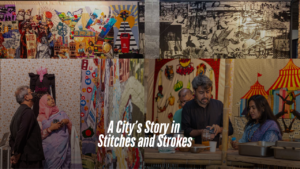
A City’s Story in Stitches and Strokes
Dhaka’s rapid urbanization is impossible to ignore. This city of relentless energy and transformation is a place where tradition and modernity collide amidst its bustling streets and ever-changing skyline. As the economic heart of Bangladesh, it draws thousands seeking better opportunities. But this comes at a cost: overcrowding, strained resources, and a growing disconnect between the old and the new. Against this backdrop, ShohorNama Dhaka Episode II sought to explore the city’s complexities through art. Launched in early 2024, the project brought together visual artists, architects, artisans, and students from the University of Dhaka’s Faculty of Fine Art to create a tapestry of urban narratives. And the exhibition of this project took place from February 15 to 25 at the level 4 under construction space of the capital’s Bengal Shilpalay. The exhibition was inaugurated by H.E. Marie Masdupuy, Ambassador of France to Bangladesh, on February 15, 2025. Titled after the project name, the multidisciplinary exhibition wove together the threads of urban life, resilience, and creativity. Presented by the Bengal Arts Programme in collaboration with the Britto Arts Trust, ShohorNama II was a visual love letter to Dhaka, its people, and their stories. From large appliqué tents to wood-cut prints, installations, and performance art, it was a celebration of Dhaka’s artistic topography. At its core, ShohorNama was about storytelling. One of the standout features is the Pakghor Project, a community kitchen born out of necessity during the devastating floods of 2024 in the Khulna region. Pakghor provided warm meals to 500 villagers for a week. But it became more than just a kitchen—it became a space for shared stories, resilience, and hope. The Dorjikhana Project takes a different approach, focusing on textiles and their cultural significance. Through appliqué and embroidery, artists explore the connection between traditional practices and the modern garment industry. The project also draws inspiration from Bangladesh’s fading circus traditions. Resulting in a stunning collection of textile art that speaks to both the past and the present. Another striking element of ShohorNama is its use of tents. Historically, tents have symbolized temporary shelter for nomadic communities, and in this exhibition, they represent the fluidity of migration—whether due to natural disasters, economic hardship, or political unrest. The Big Tent installation captured this impermanence, reflecting the challenges faced by marginalized communities. The exhibition also highlighted the collaborative spirit of the project. Workshops with the University of Dhaka’s Department of Printmaking and Department of Craft allowed students to contribute to large-scale works, such as woodcut prints and appliqué pieces. These workshops not only honed technical skills but also fostered a sense of shared purpose, blending individual creativity into a cohesive vision. The exhibition was a feast for the senses! As Dhaka continues to evolve, exhibitions like “ShohorNama Dhaka Episode II” remind us of the importance of preserving our stories and traditions. Through art, we can find common ground, build resilience, and imagine a better future.
Read More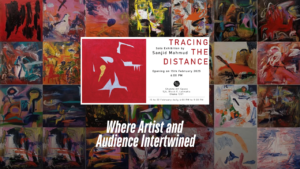
Where Artist and Audience Intertwined
Amidst the quietness of Lalmatia’s Block F lies Shunno Art Space—like multidisciplinary artists, it’s also multidisciplinary in character. Limited in floor area but with an illimitable heart, the space adorns exhibitions, has a printing workshop set up, and has a café—intertwined. From February 15 to 22, this cozy space hosted artist Sanjid Mahmud’s solo exhibition “Tracing The Distance.” The week-long exhibition witnessed a vibrant crowd, and the inauguration was graced by eminent artistic figures Hamiduzzaman Khan and Mustafa Zaman. “Exhibition visitors observe art passively, only admiring the finished works. They only view; they don’t paint. But here, they were active participants. They picked up brushes and poured their emotions into the canvasses. Even those who don’t know how to draw found themselves painting. Their raw, unfiltered expressions became the foundation. Then, I stepped in, adding my artistic intervention, blending their spontaneity with my vision.” These words from the artist Sanjid himself perfectly procure the zeitgeist of “Tracing the Distance.” Sanjid Mahmud’s “Tracing the Distance” was an artistic co-production between the artist and the exhibition visitors that prioritized real-time cooperation and process over finality. Art, being a collaborative enterprise, carries remnants of prior forms by combining individual expression with common experiences. However, Sanjid Mahmud’s initiative changed the attention away from linguistic borrowing and toward overlapping artistic expressions in the moment, resulting in a dynamic interplay between creator and participant. Visitors at Shunno Art Space were greeted with empty canvases and encouraged to add spontaneously. The act of production was valued over passive viewing, encouraging people to leave their mark on the canvasses however they liked, be it sketchy motions or painterly strokes, regardless of their creative ability. This fun and engaging method relieved the pressure of normative practices, allowing for raw, unfiltered expression. Sanjid Mahmud then stepped in, responding to these inputs without striving for a certain style result. The end result was a body of work that defied decisive conclusion, undermining modernist conceptions of linear progression and chronological time. The title of the exhibition, “Tracing the Distance,” emphasized its purposeful break with the logic of modernity, which minimizes artists’ territorial consciousness and frequently limits them to historical circumstances. Through the process of collaborating with his audiences, Sanjid Mahmud challenged the conventional understanding of art as a “significant form” or a refined praxis. In order to reveal the fluid, communal character of creativity, he instead opened the gallery’s “white cube.” By means of this collaborative approach, the artist stimulated a reconsideration of the connections among art, artists, and the art community. Thus, Shunno Art Space transformed into a place of reflection where both appreciation and creation are rethought. By emphasizing the act of doing rather than observing, “Tracing the Distance” questioned established hierarchies and honored the beauty of group, unplanned expression while providing a novel viewpoint on the ever-changing conversation between shared and individual artistic languages. Written By Shahbaz Nahian
Read More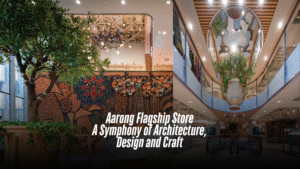
Aarong Flagship Store A Symphony of Architecture, Design and Craft
Aarong, the flagship brand of BRAC, has long been a beacon of Bangladeshi craft and heritage. Since its founding in 1978, it has evolved from a humble platform supporting rural artisans into one of the most iconic lifestyle retailers in the country. At every stage of its journey, Aarong has remained dedicated to preserving traditional crafts while embracing innovation in design and retail. This commitment culminates in its latest and most ambitious endeavor: the Aarong Flagship Store in Dhanmondi. This isn’t just a new store; it’s a monumental celebration of Bangladeshi craftsmanship, culture, and creativity. With its grand opening, the Aarong Flagship Store has become the world’s largest craft store. Yet beyond the scale, it is the thoughtfulness of the design, the intricacy of the artistry, and the profound connection to Bangladesh’s heritage that make it truly remarkable. Here, architecture becomes a canvas, interiors breathe with narrative, and every art installation stands as a tribute to the nation’s soul. Weaving a Legacy in Concrete At the heart of Dhanmondi, where tradition meets the rhythm of urban life, stands a building that does more than offer products—it tells a story. The Aarong Flagship Outlet, designed by the visionary team at Synthesis Architects, is not merely a retail space—it is a woven fabric of heritage, memory, and movement. The design draws its soul from an age-old practice: weaving. For generations, Bangladeshi artisans have mastered the loom, interlacing threads into forms that embody both beauty and utility. This fundamental craft became the architectural metaphor—fluid, connected, and timeless. A singular, sweeping ribbon—symbolic of woven fabric—emerges from the ground, bends, flows, and re-emerges, wrapping the building in a gesture that is both gentle and bold. This ribbon, meticulously cast in handcrafted concrete, intertwines tradition with contemporary expression. It shields and shelters, filters light and air, and gracefully performs the roles of both skin and soul. Designing for Aarong, a brand synonymous with preserving and promoting Bangladeshi craftsmanship, was an exercise in alignment. It was about giving architectural form to a cultural mission. The interior was choreographed as an experience. Color, texture, and flow were orchestrated to tell stories of rural hands, tribal patterns, and generational skill. The internal movement—voids, escalators, panoramic lifts—echoes the interlacing of threads on a loom. The building doesn’t simply house craft; it embodies it. There were challenges—limited plot size, urban code restrictions, and the complex layering of customer experience. But like the imperfections in a handwoven textile, these constraints added to the character. The architects embraced a rare construction process involving custom shuttering techniques that fused handcrafted care with structural innovation. It was, in many ways, architecture as craft—thoughtful, tactile, and deeply human. The Aarong Flagship Outlet is more than a commercial destination—it is a living artifact. A building where the spirit of Bangladesh rises through poured concrete, where ribbons of history and modernity interlace, and where the vision of Synthesis Architects comes alive in every curve, corner, and corridor. Narratives in Space: Designing Aarong’s Interior Stepping inside Aarong’s Dhanmondi flagship store is like entering a carefully curated journey through the textures, colors, and stories of Bangladesh. The interior design—an inspired collaboration between DWm4 Intrends Ltd, KNMR Ltd – Quirk & Associates JV, and Aarong’s in-house team—transforms the space into something far more than a retail outlet. It becomes a living, breathing storybook. From the outset, Aarong’s internal creative team played a vital role in shaping the vision. With deep roots in the brand’s philosophy and a nuanced understanding of its audience, they ensured the design remained authentically rooted in Bangladeshi heritage while pushing the boundaries of modern retail aesthetics. Guided by a philosophy rooted in transparency, movement, and nature, the space invites exploration. A rich interplay of materials, tones, and layers creates a rhythmic flow throughout the store. The tactile warmth of crafted surfaces, the strategic use of natural light, and the organic integration of greenery collectively form an ambiance that is both calming and dynamic. Each area reveals a distinct narrative, woven through thoughtful transitions that guide visitors from one crafted world to another. Every detail reflects a broader intention: to connect the threads of past and present, tradition and innovation, artisans and their audience. The space becomes part of the product’s story, amplifying its meaning and value. Executed with precision and artistry by the expert team at Charuta Limited, the interior fit-out brings this collective vision to life. At the heart of this journey was the dedicated team of architects and designers from Aarong, whose cultural insight and creative vision shaped an environment that celebrates both legacy and innovation . Art Installations: Where Stories and Spaces Intertwine Beyond architecture and interiors, the Aarong Flagship Store stands out for its large-scale art installations—transforming it from a retail space into a cultural landmark. Each piece, created by a blend of independent artists and Aarong’s in-house team, captures a different facet of Bangladeshi life and heritage. The Great Arena: A Monumental Nakshi Kantha Designed by Samiul Alam Himel in collaboration with Aarong’s in-house team, this towering four-story installation reimagines the storytelling tradition of Nakshi Kantha in architectural form. Traditionally stitched by rural women to document everyday life, these narrative quilts are here translated into flowing sculptural lines and vivid, layered colors. Titled “MohaArongo: The Great Arena,” the piece stretches 44 feet high and 10 feet wide, handcrafted over six months by 250 artisans from rural Bangladesh. The work is not only monumental in scale but also in meaning. Created from repurposed fabrics, salvaged beads, and discarded ornaments, it embodies a philosophy of renewal and resilience. The piece weaves a narrative journey through rural life, folklore, urban aspirations, and cosmic imagination—stitched in intricate Nakshi Kantha techniques drawn from Aarong’s archives and reinterpreted across various fabrics. Orange threads guide the eye through this swirling story, culminating in motifs like peacocks, trees of life, and village fairs, each carrying hidden stories within their forms. Rising through the central atrium, the installation invites viewers to look upward and
Read More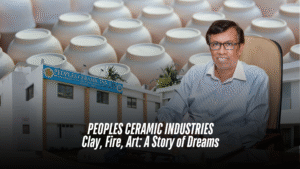
PEOPLES CERAMIC INDUSTRIES Clay, Fire, Art: A Story of Dreams
As the morning sun gently illuminates glass windows and casts playful shadows on the floor, a new day’s story unfolds. Beyond the city’s hustle and bustle, skilled hands at Peoples Ceramic Industries Limited (PCI) work tirelessly to craft each perfect piece—an extraordinary fusion of clay, fire, and creativity. Today, Bangladesh’s ceramic industry has evolved far beyond home décor into a globally recognised brand. At the forefront of this transformation is PCI. Established in 1962—originally known and registered as Pakistan Ceramic Industries Ltd.—the company has grown over 63 years into one of the nation’s oldest and most respected ceramic manufacturers. Its reputation for high-quality porcelain tableware, sustainable technology, and a robust international presence speaks for itself. In this edition of Ceramic Bangladesh, we sat down with Lutfur Rahman, the Managing Director of Peoples Ceramic Industries Ltd. A visionary in his own right, Lutfur has both preserved and expanded his father’s legacy, positioning PCI as a key player in Bangladesh’s industrial evolution. A Legacy Built on Vision and Integrity Lutfur Rahman began the interview by proudly showing a photograph of his father, Ansar Uddin Ahmed—the mastermind behind Peoples Ceramic. A civil engineer who graduated from Ahsanullah Engineering College (now BUET) in 1947, Ansar Uddin was driven by an enduring desire to serve his country—not through bureaucracy but by creating something truly meaningful. After a brief stint in the government sector, he pursued his entrepreneurial dreams. In the early 1950s, he founded United Engineers, securing a first-class license from the government. His firm was responsible for several prominent constructions that still stand today, including the Ceramic Institute in Tejgaon, Dhaka Polytechnic Institute, and Chittagong Medical College and Hospital. It was during his frequent visits to the Ceramic Institute that the idea for a ceramic factory was born. Reflecting on his father’s journey, Lutfur shared, “The relationship between children and their parents has always been special. I grew up watching my father work relentlessly, with my mother by his side supporting every step. His singular desire was to create a new industry and leave behind porcelain tableware as a legacy to improve the quality of life for our people. To realize this dream, he embarked on a long, challenging journey filled with obstacles. He always said, ‘To achieve something, one has to give up something, and there is no shortcut to building a solid foundation.’” The Birth of Peoples Ceramic In 1962, Peoples Ceramic Industries Ltd. was established with a clear and powerful vision—to provide affordable porcelain tableware for ordinary people. At a time when ceramic products were considered a luxury, Mr. Ahmed aimed to bring dignity and elegance to everyday dining. The company chose to manufacture European-style tableware, targeting both local tastes and future export opportunities. By 1982, PCI had successfully entered the international market, with its porcelain products welcomed in Holland and the United Kingdom. Located in the Tongi Industrial Area—a prominent industrial zone in Gazipur, just 20 kilometers from Dhaka—PCI started with basic housewares, tea cups, and saucers designed primarily for restaurant use. Over time, the product line expanded to include institutional ranges catering to hotels, restaurants, and the broader hospitality sector. Reflecting on the company’s humble beginnings, Lutfur recalled, “Peoples Ceramic was established in 1962, with the technical support of Sone Ceramic, Japan. At that time, Japanese engineers stayed in Dhaka to supervise the installation and production process. In the early days, our factory ran on furnace oil, and our products gained popularity right from the start.” Mr. Ansar Uddin Ahmed, who served as managing director of both Peoples Ceramic Industries and Standard Ceramic Industries Ltd., passed away on August 17, 2005. He also served as the first President of the BCMEA from 1992 to 2002, playing a vital role in revolutionising the export of local ceramics. “Tajma Ceramics, established in 1959, was the pioneer in manufacturing earthenware. However, PCI was the first to introduce porcelain production in Bangladesh,” Lutfur explained. According to him, PCI was formally inaugurated by then Industries Minister Dewan Basit and the Japanese Ambassador, with commercial production beginning on June 23, 1966. Overcoming Challenges and Embracing Innovation Marketing large-scale production in the early years posed a significant challenge. To overcome this, Mr. Ahmed ventured into the Pakistani market, successfully competing against two established factories. PCI’s hard-grade porcelain quickly won acceptance, carving out its niche within the subcontinental market. The company has consistently invested in state-of-the-art technology, global raw material sourcing, and upgraded machinery to guarantee quality and cost-effectiveness. This forward-thinking approach has enabled PCI to stay ahead of industry trends for decades. In 2009, the company introduced decal printing—initially using basic logos—and by 2012 had established a fully automated decal printing facility, expanding its design capabilities and reinforcing its brand identity. Aesthetic Diversity: Designs That Tell a Story Today, PCI offers a diverse range of tableware, neatly categorized into housewares, hotelware, and giftware. The company produces approximately 13 million pieces of porcelain tableware annually and employs nearly 712 people. These milestones stand as a tribute to its commitment to quality and innovation. The Road Ahead: Legacy and Vision Under Lutfur Rahman’s leadership, PCI continues to honor his father’s legacy with dedication and innovation. The company has adopted sustainable production practices and is actively exploring new export markets. As Lutfur puts it, “We still hold on to the principles my father set—quality, integrity, and making ceramics accessible for all. Our goal is not only to serve our customers but also to contribute to the country’s economic and industrial growth.” Looking to the future, PCI is exploring renewable energy integration, digital production processes, and expanding its footprint into emerging markets in Asia and Africa. As Bangladesh’s ceramic industry gains global prestige, Peoples Ceramic Industries Ltd. remains at its heart—a symbol of dreams forged in clay and fire, shaped by vision, and driven by a commitment to excellence. Maximizing Waste Utilization in Ceramic Production PCI is also a leader in sustainable practices. “We actively reclaim ceramic scraps at various stages of production—including the green (unfired), bisque
Read More
Celebrating 5 Years of Success of the Sponsors and Patrons Recognition
Shaping Bangladesh was one of the most prestigious events of Ceramic Bangladesh Magazine, organized by BCMEA (Bangladesh Ceramic Manufacturers and Exporters Association). The event gathered many renowned and well-known architects, engineers, industry leaders, and industry personnel from different sectors under one roof. It was a different way of introducing the new ways of rebuilding and reshaping Bangladesh with many unique and extraordinary ideas and thinking of brilliant minds and visionary individuals of the country. Without the support of the sponsors, the event would never have happened in reality. It was the encouragement, support, and dedication of the valuable sponsors who have come forward to make this event successful and create a new buzz in the town. On that note, special thanks to all the sponsors and partners of the event for making a special and notable contribution to the event and playing their part crucially. Valued Sponsors of Shaping Bangladesh Special recognition and deepest gratitude to the valued sponsors and partners for providing their invaluable support. Their generous contribution has played a significant role in making this event possible and helping BCMEA bring all the valuable communities together to promote a meaningful experience. The valued sponsors of Shaping Bangladesh were: • Platinum Sponsor: Akij Ceramics Limited • Powered by Sponsors: Meghna Ceramic Industries Limited. and X Ceramics Limited • Associated Sponsors: Sheltech Ceramics Limited, DBL Ceramics Limited, Mir Ceramic Limited Event Partners: • Gift Partner: RAK Ceramics (BD,) Ltd. • Media Partner: The Business Standard • Hospitality Partner: Dhaka Regency and Chuti Resort • Wardrobe Partner: Fiero • Other Supporting Partners: 01. BHL Ceramic Co. Ltd., 02. Mirpur Ceramic Works Ltd., 03. Ali Ceramic Ind. Ltd., 04. Adroit Swimming Ltd., 05. Nupami BD Ltd., 06. Amber Board Mills Ltd., 07. Lonon BD BCMEA and Ceramic Bangladesh Magazine are extremely grateful and honored by their presence and collaboration for the event, and they also look forward to continuing these valuable relationships in the future by working together. Top 5 Contributors in 5 years journey of Ceramic Bangladesh Magazine Shaping Bangladesh was not only an event to gather the brilliant minds, but it was also a remarkable celebration for the 5-year successful journey of Ceramic Bangladesh Magazine. BCMEA and Ceramic Bangladesh Magazine expressed their heartfelt gratitude to the constant supporters of the publication. Here are the top 5 contributors of the Ceramic Bangladesh Magazine in last 5 years who have helped to sustain the publication and allowed the magazine to grow, evolve, and continue delivering quality content to the readers, and showcase unique and extraordinary stories through the lenses of writers and photographers. Moreover, the continuous and unwavering belief in the publication was the cornerstone of this event’s success. The partnership has made the event more meaningful. BCMEA and Ceramic Bangladesh Magazine are truly honored to have all the sponsors, partners, and contributors by their side and look forward to continuing this journey together by building more impactful and significant years ahead.
Read More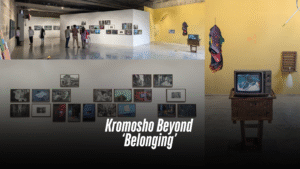
Kromosho Beyond ‘Belonging’
In the mid-2000s, a young- Munem Wasif began exploring the hidden corridors of Old Dhaka alongside his trusty, timeworn companion, Zenit—a mechanical relic from the Soviet era. This journey eventually culminated in his 2012 photographic masterpiece Belonging, a work that revolutionized visual storytelling in Bangladesh’s art scene. Much like the dark, ever-flowing waters of the Buriganga that have witnessed Dhaka’s transformation, Wasif’s artistic journey has traversed many phases—each urging audiences to look beyond the surface. From `Seeds Shall Set Us Free’ to `Collapse’, his work continuously invites deeper reflection, all while retaining an unbreakable bond with Old Dhaka. After nearly 16 years, Munem Wasif returns to Dhaka with a solo exhibition titled `Kromosho’, now on display at Bengal Shilpalay in the capital. The show, which runs until May 31, 2025, features contributions from curatorial advisor Tanzim Wahab, project assistant Iftekhar Hassan, and architectural designer Dehsar Works, and is open to everyone. Reflecting on his previous work, Wasif explained, “I felt something was lacking when Belonging was released. It merely touched upon the surface of the people and their celebrations—I couldn’t capture the core of their daily lives, the very ‘life’ of Puran Dhaka. That realization gave birth to Kheya’l. This exhibition is a testament to my transformation over the past two decades.” The opening at Bengal Shilpalay buzzed with energy as art enthusiasts gathered to witness what promises to be one of the most memorable exhibitions in recent memory. Kromosho unfolds in three movements: it begins with Wasif’s ethereal black-and-white photographs from the Belonging era, which converse with his fresh, vibrant color works from Stereo. This juxtaposition creates a dynamic tension between past and present, memory and reality. In Kheyal, a cinematic meditation captures the pulsing rhythm of Old Dhaka, while the installations Shamanno and Paper Negative blend documentation with imagination, challenging our perceptions of what is real versus what is remembered. Critically, Old Dhaka may seem like a ticking time bomb—overcrowded, decaying, and a bitter relic of collective neglect. Yet, Wasif’s work reveals the hidden vitality amid this chaos, unearthing a poetry rarely seen by the casual observer. Kromosho does more than display images of a place; it captures its very essence. The exhibition serves as a mirror, prompting us to consider what we preserve and what we forsake in our relentless march toward modernity. In an age of rapid urbanization and cultural amnesia, Wasif’s work stands as both an archive and an elegy—an enduring reminder that some stories transcend what can be captured by cameras or words. To fully appreciate its depth, one must experience it both in person and with an open, reflective heart. As visitors wander through the gallery, they are invited not only to observe but also to introspect. In this way, Kromosho transcends the role of a mere art exhibition—it becomes a conversation, a homecoming, and ultimately, a call to bear witness. Written by Shahbaz Nahian
Read More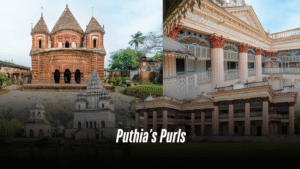
Puthia’s Purls
Nestled in northern Bangladesh in the heart of Rajshahi, the Puthia Rajbari (Palace) Complex stands as a vivid reminder of the region’s storied past. This captivating ensemble of temples and palaces—set against a backdrop of tranquil water bodies and lush greenery—offers visitors a rare glimpse into the majesty of Bengal’s bygone eras Puthia’s rise to prominence dates back to the late 16th century, evolving by the 18th century into a bastion of wealth and influence. Originally part of the Laskarpur Pargana and named after Laskar Khan Nilamber—the brother of the first zamindar, who earned the title of Raja from Mughal Emperor Jahangir—the estate underwent a significant division in 1744. This partition split the zamindari into four co-shares, with the Panch Ani (five annas) and Char Ani (four annas) shares emerging as particularly influential. The Panch Ani estate, skillfully managed by Maharani Sarat Sundari and Maharani Hemanta Kumari, became celebrated for its efficient administration and enthusiastic patronage of the arts. In 1895, Maharani Hemanta Kumari Devi commissioned the construction of the two-storied Puthia Rajbari—an architectural marvel dedicated to her mother-in-law, Maharani Sarat Sundari Devi. A fine example of Indo-Saracenic Revival architecture, the palace harmoniously blends European neoclassical ideals with indigenous Bengali design. Strategically located along the Rajshahi–Natore highway (approximately 30 km east of Rajshahi town and 1 km to its south), the palace is surrounded by protective ditches and sprawls over 4.31 acres. It is organized into four distinct courts: the Kachhari (office) courtyard, the Mandir Angan or Gobindabari (temple court), the Andar Mahal (private quarters), and the residence of Maharani Hemanta Kumari Devi. Today, the palace also functions as a museum, offering insights into the rich tapestry of Puthia’s history. Under British colonial rule, the Puthia family continued to play a pivotal role in Bengal’s governance. Eager to integrate local elites into their administrative framework, the colonial authorities relied on influential zamindars such as the Puthia royals. This collaboration enhanced their economic wealth and social standing while cementing Puthia’s reputation as an architectural and cultural beacon during the 19th century—a remarkable melding of Mughal elegance with European influences that produced a unique heritage. The palace rooms are arranged around several courts, all of which are single-storeyed except for the Kachari Angan. This section features Palladian porticos with four semi-Corinthian columns on both the western and eastern ends—one leading to the Kachari Angan and the other to the Temple (Gobindabari) courts. The porticos and central section include arcaded loggias on the first floor, while a wooden staircase on the east side ascends to three varied rooms (two of which once served as treasuries) on one side and four rooms with verandahs on the other. The northern block is double-storeyed, with a wide hall measuring 21.95 m x 7.16 m, a verandah with side balconies, and six additional rooms upstairs. In the Andar Mahal, the western section comprises two rooms and several bathrooms, while the eastern section houses a one-storeyed residence of Rani Hemanta Kumari. This residence includes a porch, a central reception hall with nine rooms, extended arch-adorned verandahs, and a roof supported by iron and wooden beams. Overall, the palace primarily served as the administrative and residential hub of the Puthia estate. The complex is also home to several iconic temples that epitomize its architectural grandeur: Bhubaneshwar Shiva Temple (1823): Constructed by Rani Bhubonmoyee Devi, this temple is the largest Shiva temple in Bangladesh. Built in the Pancha Ratna (five-spired) style, it enchants visitors with intricate stone carvings and houses a massive black basalt Shiva Linga—the largest of its kind in the country. Govinda Temple: Erected in the mid-19th century by the queen of Puthia and dedicated to Lord Krishna, this temple is famed for its exquisite terracotta ornamentation. Its five imposing spires, detailed with depictions of divine figures, epic battles, and mythological narratives, showcase the fervor and artistic talent of the region. Jagannath Temple: In a striking departure from conventional designs, this two-storied octagonal temple—dedicated to Lord Jagannath—features four pillars crowned with domes. Its unconventional shape highlights the infusion of European neoclassical elements into traditional local design. Chauchala Chhota Govinda Mandir: Dating to the late 18th or early 19th century, this temple adheres to the Char Chala style, characterized by its distinct four-cornered roof. Its terracotta façade vividly narrates rich tales from Hindu mythology, including cosmic battles between gods and demons. Bara Anhik Mandir: Representing an intriguing fusion of styles, this temple combines a central two-chala structure with two flanking four-chala wings—a rare architectural combination scarcely seen elsewhere in Bangladesh. Choto Shiv Mandir: Tucked behind the Rajbari, this humble yet finely crafted temple exemplifies the refined skills of Bengal’s artisans and provides a serene retreat for those seeking a private space for reflection. As Bengal’s social and political landscapes evolved under British influence, complexes like Puthia became more than centers of worship—they grew into symbols of local identity. The sacred grounds of the Puthia Temple Complex evoke an era when devotion, artistic brilliance, and effective governance merged to create a legacy that continues to inspire awe. Even amid challenges such as the Bangladesh Liberation War and other periods of political upheaval, dedicated preservation efforts by local authorities and heritage organizations have maintained the complex’s original splendor. In safeguarding its stone and clay, they preserve not merely a collection of monuments but a living cultural heritage that speaks volumes about the spirit of Bengal. Exploring Puthia’s legacy invites further discovery—from delving into the nuanced artistic details of terracotta carvings to understanding how colonial and indigenous influences converged to shape regional identity. This complex remains a beacon for anyone passionate about history, art, and the enduring human endeavor to immortalize culture through architecture. Written by Shahbaz Nahian
Read More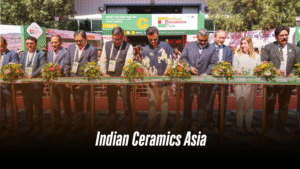
Indian Ceramics Asia
Announces New Dates for 2026 Edition: To Be Held from January 28–30, 2026 in Gandhinagar, Gujarat, India Indian Ceramics Asia, India’s only B2B trade fair for the ceramics and brick industry, has announced the dates for its landmark 20th edition. The upcoming show will take place from January 28–30, 2026, in Gandhinagar, Gujarat. Organised by Messe Muenchen India and Unifair Exhibition Services, the 2026 edition is strategically scheduled earlier in the year to better align with the industry’s annual planning and investment cycles. The new dates are expected to deliver enhanced value for exhibitors and visitors alike—unlocking fresh business opportunities, accelerating decision-making, and setting the tone for innovation-led growth across the industry. The announcement follows the successful completion of the 19th edition, held from March 5–7, 2025, at the same venue. This edition attracted over 250 brands and more than 8,000 trade professionals from 32 countries, marking a vibrant convergence of ideas, technology, and global best practices. The 2025 edition stood out for its focus on energy innovation, logistics optimization, and global competitiveness. Exhibitors like SACMI, KEDA, Sibelco, Systems Ceramics, and Modena showcased advanced machinery and raw materials aimed at making ceramic manufacturing more cost-effective and sustainable. The Live Demo Zone and Ceramics Career Connect initiatives offered real-time learning and talent engagement, further enriching the visitor experience. International pavilions from Italy and Germany brought in automation-centric solutions and sustainable practices, strengthening cross-border collaboration. As the industry continues to navigate challenges around energy, supply chains, and global demand, Indian Ceramics Asia remains the sector’s most trusted platform for innovation, networking, and growth. Join us from January 28–30, 2026, in Gandhinagar—and be part of the ceramics industry’s defining event in South Asia. For more details, visit www.indian-ceramics.com
Read More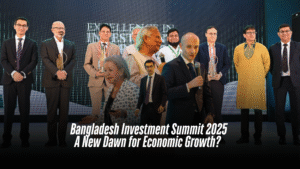
Bangladesh Investment Summit 2025 A New Dawn for Economic Growth?
Bangladesh now stands at a critical crossroads. As the country prepares to transition from a least-developed nation (LDC) to a middle-income economy in 2026, it grapples with significant hurdles. Despite years of economic resilience, enduring issues—such as import dependency, skill shortages, stagnant private investment, and declining foreign direct investment (FDI)—continue to slow progress. In this challenging environment, the Bangladesh Investment Summit 2025 emerged as a pivotal event, unveiling initial investment proposals worth Tk 31 billion (3100 crore) and igniting cautious optimism among policymakers and investors. Convergence of Promise and Challenges Organized by the Bangladesh Investment Development Authority (BIDA), the four-day Dhaka summit, held from April 7 to April 10, 2025, brought together over 550 investors and business representatives from more than 50 countries. Inaugurated by Chief Advisor Dr. Muhammad Yunus, the summit sought to reimagine Bangladesh’s global investment identity even as it faced structural challenges. Ultimately, the success of these initiatives will hinge on whether early commitments evolve into sustained and tangible investments. For years, Bangladesh’s investment landscape has remained largely stagnant. Overall investments have hovered between 24–28 percent of GDP, with private investment stuck at 22–24 percent and FDI persistently below 1.0 percent. Recent declines in private investment in FY2023 and FY2024, along with a continuous drop in FDI since FY2018, have been attributed to bureaucratic hurdles, policy unpredictability, and macroeconomic instability—particularly in managing exchange rates. Yet, amid these challenges, the summit has sparked a renewed sense of hope. Global Multinationals Betting on Bangladesh Three major international companies announced expansion plans during the summit: Inditex (Spain): The retail giant behind Zara reaffirmed Bangladesh’s role as a key sourcing hub and hinted at increased procurement. Lafarge Holcim: The cement leader discussed plans to broaden operations and explore carbon capture initiatives. Handa Industries (China): The company committed $150 million to develop textile, dyeing, and garment units in designated economic zones. In addition, Dubai-based DP World expressed interest in investing in Chattogram’s new Mooring Container Terminal. Celebrating Local Champions Local enterprises also received significant recognition at the event. Four Bangladeshi firms were honored for their contributions: bKash (Excellence in Investment): The trailb lazing mobile financial services provider backed by IFC, Ant Group, and SoftBank. Fabric Lagbe (Innovation Award): A digital marketplace that empowers traditional weavers. Walton (ESG Award): A leading local electronics manufacturer exporting to over 40 countries. Square Pharmaceuticals (Investment Excellence): A company that has grown from modest beginnings in Pabna to a globally recognized pharmaceutical powerhouse. These success stories underscore that, despite systemic challenges, Bangladeshi enterprises can thrive on the international stage. Global Investors Show Confidence There is growing international faith in Bangladesh’s revised approach to investment. Foreign investors have commended the interim government for taking proactive measures to attract FDI—a marked departure from previous administrations. A delegation of 60 investors from the U.S., South Korea, China, Japan, India, Australia, and the Netherlands toured key hubs such as the Korean Export Processing Zone (KEPZ) in Chattogram and the Japani Export Processing Zone (JEPZ) in Narayanganj, exploring opportunities in textiles, IT, and manufacturing. KEPZ: A Model Investment Hub Operated by South Korea’s Youngone Corporation, KEPZ has become a shining example of Bangladesh’s readiness for FDI. Investors were impressed by its well-established infrastructure, efficient licensing procedures, and worker-friendly amenities—including a hospital, a textile institute, a 40MW solar project, and an effluent treatment plant. With $700 million already invested, KEPZ now hosts 48 factories and employs 30,000 workers, 75 percent of whom are women. Forging Sustainable Partnerships The summit also facilitated key agreements. Notably, BIDA, the Commerce Ministry, ILO, and UNDP issued a joint declaration to promote sustainable and inclusive growth through targeted trade reforms. Additionally, UK Trade Envoy Baroness Rosie Winterton highlighted long-term opportunities in healthcare and education, paving the way for enduring global partnerships. Navigating the Road Ahead: Can Bangladesh Overcome Its Investment Slump? Despite the summit’s positive momentum, Bangladesh’s investment climate continues to face obstacles: High bank interest rates that deter private borrowing. Policy inconsistencies under the interim government create uncertainty. Weak FDI performance compared to regional competitors like Vietnam and India. Analysts stress that without significant structural reforms—streamlining bureaucracy, ensuring policy stability, and stabilizing the macroeconomy—Bangladesh may struggle to sustain the anticipated investment surge. Execution is Key The Bangladesh Investment Summit 2025 has successfully rebranded the country as an emerging investment destination. With multinationals such as Inditex, Lafarge Holcim, and Handa Industries pledging expansion and local leaders like bKash and Walton proving their global competitiveness, there is considerable cause for optimism. However, the real challenge now lies in execution. Only if Bangladesh addresses its business environment hurdles, refines regulatory frameworks, and maintains macroeconomic stability can this new momentum herald a transformative economic chapter. For now, the world watches closely—will Bangladesh seize this moment, or will these early promises fade away? Only time will tell. Written by Sajibur Rahman
Read More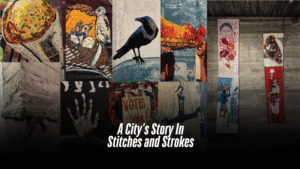
A City’s Story In Stitches and Strokes
Dhaka’s rapid urbanization is impossible to ignore. This city of relentless energy and transformation is a place where tradition and modernity collide amidst its bustling streets and ever-changing skyline. As the economic heart of Bangladesh, it draws thousands seeking better opportunities. But this comes at a cost: overcrowding, strained resources, and a growing disconnect between the old and the new. Against this backdrop, ShohorNama Dhaka Episode II sought to explore the city’s complexities through art. Launched in early 2024, the project brought together visual artists, architects, artisans, and students from the University of Dhaka’s Faculty of Fine Art to create a tapestry of urban narratives. And the exhibition of this project took place from February 15 to 25 at the level 4 under construction space of the capital’s Bengal Shilpalay. The exhibition was inaugurated by H.E. Marie Masdupuy, Ambassador of France to Bangladesh, on February 15, 2025. Titled after the project name, the multidisciplinary exhibition wove together the threads of urban life, resilience, and creativity. Presented by the Bengal Arts Programme in collaboration with the Britto Arts Trust, ShohorNama II was a visual love letter to Dhaka, its people, and their stories. From large appliqué tents to wood-cut prints, installations, and performance art, it was a celebration of Dhaka’s artistic topography. At its core, ShohorNama was about storytelling. One of the standout features is the Pakghor Project, a community kitchen born out of necessity during the devastating floods of 2024 in the Khulna region. Pakghor provided warm meals to 500 villagers for a week. But it became more than just a kitchen—it became a space for shared stories, resilience, and hope. The Dorjikhana Project takes a different approach, focusing on textiles and their cultural significance. Through appliqué and embroidery, artists explore the connection between traditional practices and the modern garment industry. The project also draws inspiration from Bangladesh’s fading circus traditions. Resulting in a stunning collection of textile art that speaks to both the past and the present. Another striking element of ShohorNama is its use of tents. Historically, tents have symbolized temporary shelter for nomadic communities, and in this exhibition, they represent the fluidity of migration—whether due to natural disasters, economic hardship, or political unrest. The Big Tent installation captured this impermanence, reflecting the challenges faced by marginalized communities. The exhibition also highlighted the collaborative spirit of the project. Workshops with the University of Dhaka’s Department of Printmaking and Department of Craft allowed students to contribute to large-scale works, such as woodcut prints and appliqué pieces. These workshops not only honed technical skills but also fostered a sense of shared purpose, blending individual creativity into a cohesive vision. The exhibition was a feast for the senses! As Dhaka continues to evolve, exhibitions like “ShohorNama Dhaka Episode II” remind us of the importance of preserving our stories and traditions. Through art, we can find common ground, build resilience, and imagine a better future. Written by: Shahbaz Nahian Photo: Bengal Art Foundation | Courtesy
Read More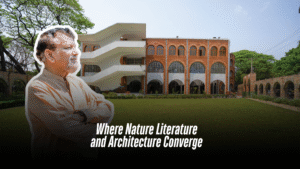
Where Nature Literature and Architecture Converge
Every person envisions a path uniquely their own. For Mesbah-ul-Kabir, the visionary force behind Kabir and Associates, that path was rooted in literature—especially Bangla literature, which continues to capture his heart. Picture a building as if it were a poem: its floors serve as verses, its design the underlying rhythm, and within the interplay of these elements unfolds the poetic vision of its creator. Though destiny steered him away from writing verses, it set him on the course of designing ones conceived in concrete, glass, and steel. When asked about his design philosophy, Mesbah replied, “I don’t follow a singular style. Instead, I draw inspiration from nature—the master designer. Nature effortlessly embraces the path of least resistance, creating a harmonious, albeit imperfect, balance. Unlike manmade objects that often adhere to strict forms, every new project demands its own innovative treatment. I learn and evolve with each undertaking.” This commitment to constant reinvention has defined his career and led him to craft iconic structures like the Sena Kalyan Bhaban—which redefined Dhaka’s skyline—and Mirpur’s National Stadium, among many others. In Bangladesh, Mesbah-ul-Kabir’s name is synonymous with architectural excellence. Yet, he always reminds fellow architects that the learning process never truly ends. He laments that only a handful of his peers still embrace the hands-on method of constructing scale models with simple, analog tools—a practice increasingly eclipsed by computerization. “I purposely avoid relying on computer software,” he explains firmly. “By drawing perspective sketches and building scale models by hand, I retain total control over my creative process.” He recalls how, during his studies at BUET, a chance encounter with the legendary Dr. Fazlur Rahman Khan left a lasting impression: “When I envision a building, I feel its weight as if it were part of me.” Such experiences underscore the importance of imagination—a quality he fears is slowly being overshadowed by digital methods. Reflecting on his earlier days, Mesbah recounts a time when understanding a client’s desires led to rough sketches, known as ‘functions,’ followed by detailed perspective drawings imbued with vanishing points, horizons, and everyday elements like trees or vehicles. These handcrafted visualizations offered a glimpse of a project’s future long before modern tools like AutoCAD existed. Even the laborious process of constructing scale models gave him a satisfaction akin to a poet reveling in a freshly composed verse. Today, a visit to the Kabir & Associates office in Dhanmondi reveals a gallery of these cherished drawings and models—a living history of a lifetime dedicated to craftsmanship. Despite the encroachment of digital design, Mesbah holds a hopeful vision that emerging architects will rediscover the profound joy of traditional creation. For him, architecture is boundless. “Some choose this profession out of necessity; I embraced it with passion,” he reflects. His academic journey spanned literature, history, physics, mathematics, philosophy, and even music during his time at BUET’s Department of Architecture. Even within the scientific rigors of his field, literature remained a wellspring of inspiration—a force that uplifted him from isolation and exposed him to a vast ocean of creativity. While celebrated for his monumental public works and commercial edifices, some of Mesbah-ul-Kabir’s most treasured designs are the modest homes of the 1970s and 1980s in neighborhoods like Gulshan, Banani, and Baridhara. These projects, though simple, exuded warmth and personality—whether through rooftop gardens, multi-story green spaces, or even rooftop swimming pools—offering a style of luxury living that contrasts sharply with today’s prevalent, box-like apartment blocks. He fondly recalls a whimsical project for the former vice president of Summit Group—a full-glass house in Savar Cantonment. Enchanted by a monsoon season enlivened with blooming red lotuses, the client once declared, “I want to present this glass house to my wife.” When pressed about privacy, particularly in intimate areas and restrooms, he quipped about using curtains, noting humorously that the secluded setting made privacy a minor concern. Notably, Mesbah introduced the curtain wall system on the Sena Kalyan Bhaban for the first time in Bangladesh—a testament to his innovative spirit, which is also reflected in designs for national stadiums and even the previous Gulshan Club. Mosques occupy an especially sacred space in Mesbah’s repertoire. Having designed and refined over a hundred mosques, he approaches these projects not as commercial ventures but as acts of ‘khidmah’ (service)—an opportunity to contribute selflessly to the community. “Designing mosques is both a duty and a passion, a way to express gratitude for the gifts of life and our own abilities,” he explains. His first mosque, the Azad Mosque—more widely known as Gulshan Central Mosque—was a landmark project that spanned nearly 18 bigha and featured striking geometric designs with circles and triangles. Drawing on decades of experience, Mesbah elaborates on the cultural significance of religious structures. While domes, arches, and minarets have transcended their practical origins—minarets, once essential for calling worshippers to prayer, now serve largely symbolic roles—they remain vital in linking a building’s design to its cultural and spiritual roots. Architecture, in his view, acts as the binding force that enshrines ideological meanings across diverse cultures, even as building materials and techniques evolve. The evolution of mosque design is an ever-unfolding process. Take the Baitul Aman Mosque on Dhanmondi Road 7, which began as a humble prayer space enclosed by bamboo fencing. Over time, enhancements like the addition of balconies, multiple floors, and modernized interiors—with steel window frames, marble finishes, and wooden elements—have transformed it into a communal haven that harmonizes with its upscale neighborhood and the nearby natural charm of Dhanmondi lake. For Mesbah, each mosque should feel inseparable from its surroundings, a tribute to both its community and its environment. Today, Bangladesh’s architectural scene is thriving—high-rise, elegant, and meticulously streamlined structures now dot the landscape. Young architects enjoy the profession far more than in earlier times, even as government projects, though commendable, sometimes lack the incentives necessary to retain top talent. Yet, despite these challenges, he remains confident that given the right opportunities and motivations, these architects will
Read More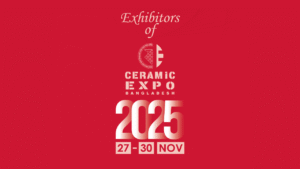
Exhibitors of Ceramic Expo Bangladesh 2025
The 4th edition of Ceramic Expo 2025 is going to be held from November 27 to November 30, 2025, at the International Convention City Bashundhara (ICCB) in Dhaka. The event is one of the most prestigious and premier B2B events focused on the ceramic finished products of the local manufacturers and foreign companies with new machinery, raw materials and innovation. There will be 40+ local manufacturers of ceramic products, such as tiles, tableware, sanitaryware, ceramic bricks, pottery etc. and 75+ foreign exhibitors from more than 25+ countries along with 300+ brands and 500+ delegates. The local and foreign exhibitors both will enhance the quality and standard of the Ceramic Expo 2025 by showcasing their latest products and innovation. The expo is not only promoting the growth and development of the business but also expanding the opportunities to going global for the business expansion. Written by Preety Dey
Read More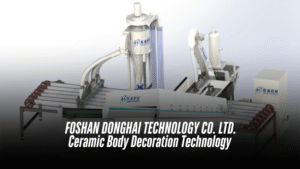
FOSHAN DONGHAI TECHNOLOGY CO. LTD. Ceramic Body Decoration Technology | Digital Powder-Jet System
Digital Powder-Jet System | Precise Alignment, Full-Body Texture Donghai Technology’s Digital Powder-Jet System is an advanced feeding technology that utilizes intelligent control systems and multi-channel coordination to impart vibrant patterns and textures. Each channel carries different colored powder, precisely applying the desired designs through digital nozzles. This advanced technology not only enhances production efficiency but also customizes to meet the diverse clients’ need, showcasing a full-body effect from the surface to the bottom. Digital Powder-Jet System’s Advantages: (1) Superior compatibility, seamless Integration with all types of press, (2) Feeding Channel from 6-12 (optional). (3) High-speed feeding, up to 10m/min, achieving both production and efficiency. (4) High precision and accuracy, with positioning accuracy controlled within 2-3mm. Ceramic Surface Decoration Technics | Dry Applicator Dry Applicator | Digital Grit, Premium Finish Donghai Technology’s Dry Applicator is a specialized equipment used for the surface decoration of ceramic tiles. It mainly through the technology of glue and dry grit. By evenly spreading various dry granular materials on the surface of the tiles, it significantly enhances the decorative effect of the tiles. Its advanced technics technology, bringing brand-new possibilities to the surface decoration of ceramic tiles. Dry Applicator’s Advantages: (1) Perfect combination with ink-jet technology, tile surface with rich effect of concave & convex. (2) Italian imported belt, precise control of grit, feeding uniformity. (3) With heating device, remove the humidity of grit during recycling. (4) With automatic recycling system, grit can be reused. (5) Provide professional process technical support, design effect can be realizable.
Read More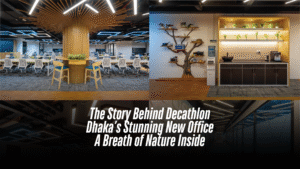
The Story Behind Decathlon Dhaka’s Stunning New Office
In the center of Dhaka’s relentless urban sprawl, Decathlon’s new liaison office has carved out an unexpected oasis. Designed by Studio one zero, the two-floor, 20,000-square-foot workspace is a lively yet calming blend of nature, sport, and smart design — a triumph achieved under the intense pressure of a compressed timeline. One floor of the office is devoted to a sprawling seminar and multi-purpose event space, while the other flourishes as a vibrant open-plan workspace. Together, they embody Decathlon’s global brand ethos: movement, accessibility, and connection to the environment. From the first step inside, the design immediately surprises. Natural light pours in from every angle, with open workstations, informal seating zones, and collaborative spaces stretching toward the glass walls. But what truly distinguishes the space is its deliberate, sensitive incorporation of natural elements into an otherwise urban setting — a concept that chief architect Jafor Hoq and Partner Architect Humaira Binte Hannan at Studio One Zero were determined to bring alive. Challenge Against Time “The biggest challenge for us,” says Jafor Hoq, “was the design decision against time. From the initial concept to execution, we had a very short period. And it wasn’t just about filling a space — Decathlon wanted something meaningful, experiential, and true to their brand spirit.” Working under intense deadlines and changes meant that decisions on materials, layouts, and designs had to be made rapidly but thoughtfully. “We had no time for second-guessing. Every material, every design move had to be purposeful and achievable within the timeframe,” Hoq recalls. Instead of battling the constraint, Studio one zero leaned into it, focusing on a few strong ideas and executing them meticulously. Bringing Nature Indoors — A Different Way While biophilic design is no longer a novelty, Studio one zero’s approach for Decathlon’s office is refreshingly nuanced. Instead of merely placing potted plants in corners, nature was embedded into the structure itself. The most striking feature — the tree-inspired columns — originated from a need to solve a technical problem with artistic flair. Existing structural columns, often seen as obstacles in open-plan offices, were transformed into vertical wooden sculptures. “These columns are not just cladded structures,” Hoq explains. “We intentionally gave them the form of large tree trunks, expanding outward at the top, creating a canopy-like feeling. Under these ‘trees,’ we placed high seating zones, making them natural gathering points where people can sit, stand, and connect. It’s about reinterpreting indoor nature — not just bringing in greenery but evoking the experience of being under a tree.” Materiality: Warmth in an Industrial Frame The material palette reflects a thoughtful balance between modernity and warmth. Light oak wood cladding runs through the flooring of common pathways and wraps around key architectural elements, providing a sense of warmth and continuity. “The idea was to humanize the space,” says Hoq. “We were working with an exposed ceiling — which gives that industrial look — but we didn’t want it to feel cold or impersonal. Using wood, texture and incorporating green , was the answer.” Meanwhile, the furniture choices favored light-colored wood and clean lines to complement the architecture without overwhelming it. Lush green walls filled with planters further softened the industrial base, offering breathing spaces that look and feel alive. Even the lighting played into the natural narrative. Angular, dynamic geometric light fixtures, seemingly random yet deliberate, mimic dappled sunlight filtering through tree canopies, casting a playful rhythm of light and shadow across the workspace. Functionality at the Core Of course, Decathlon’s office needed to be more than beautiful; it needed to work. Beyond the seminar space and open workstations, Studio One Zero integrated a variety of amenities including a gym, prayer rooms, a sick room, and a restaurant-style café. The café, with its relaxed seating and natural materials, encourages casual interaction — a deliberate attempt to break down formalities and foster an easy, collaborative culture. Flooring materials shift subtly from wood to textured carpet tiles to indicate different zones without physical barriers, preserving the openness. Every design choice speaks to movement, flexibility, openness and wellness — values at the heart of both Decathlon and Studio one zero’s architectural philosophy. A Space That Moves People In the end, Decathlon’s Dhaka office is more than a workplace. It’s a living, breathing environment, where the boundaries between indoor and outdoor, formal and informal, structured and free-flowing, are beautifully blurred. Studio One Zero’s bold vision — executed under a limited timeframe — has resulted in a space that isn’t just seen; it’s felt. A place where employees can experience the spirit of sport, the calm of nature, and the excitement of innovation, every single day. “We didn’t just design an office,” Jafor Hoq smiles. “We designed an experience.” Written By Fatima Nujhat Quaderi Photo: Truphoto Studio
Read More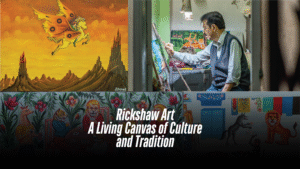
Rickshaw Art A Living Canvas of Culture and Tradition
Dhaka’s wheel The rickshaw is the quintessential three-wheeler of Dhaka. If one were to encapsulate the spirit of the city with a single vehicle, it would undoubtedly be the rickshaw. Even in an era dominated by modern transport and ride-hailing services, the rickshaw remains a beloved tradition. Riding in a rickshaw, one can experience a serene immersion in nature—a reflective calm—despite the bustling chaos of Dhaka outside. More than a means of transport, rickshaws are mobile masterpieces. Handcrafted by skilled artisans, they feature oil paintings adorned with vibrant floral patterns, birds, animals, movie stars, and scenes from folk tales, effectively transforming the streets into a roving gallery. On December 6, 2023, UNESCO recognized Bangladesh’s rickshaw art as part of the Intangible Cultural Heritage of Humanity—a distinction that has gripped global attention and sparked renewed domestic interest. Galleries across the country are now hosting exhibitions to celebrate this unique cultural tradition. History throughout The three-wheeled rickshaw has been a part of Bangladeshi life since the 1940s. By the late ‘40s, decorative elements such as movie star portraits and intricate floral designs began to appear, heralding the birth of what is now known as rickshaw art. Originating in Rajshahi and Dhaka, this art form evolved with each district contributing its own unique stylistic influences. Artist Syed Ahmad Hossain has been a devoted practitioner of rickshaw art since 1969. A self-taught talent, his works have not only graced exhibitions around the world but also served as a visual chronicle of his era. During the Liberation War, for instance, he vividly captured scenes of conflict on rickshaws, transforming them into moving narratives of historical events. In 1975, political unrest led to fears of a ban on rickshaw painting, prompting many artists—including Syed—to shift their focus to signboard painting. Concurrently, rising religious sensitivities rendered the portrayal of human faces and film scenes controversial, ushering in a new era where artists gravitated toward universally acceptable subjects such as trees, animals, and nature. Gradually, human faces were replaced with symbolic imagery that communicated profound stories without uttering a single word. Syed recalls a time when cheap, mass-produced prints of rickshaw art flooded the market, selling for merely 60–70 taka. Although these replicas lacked the detail and artistry of the originals, their affordability made them popular. This oversaturation, however, contributed to a devaluation of authentic rickshaw art. During Pohela Boishakh, rickshaw art transforms from vehicle decoration into a marketable commodity. Artisans create posters, canvas prints, postcards, and figurines that feature iconic rickshaw designs; these items are cherished as souvenirs, home décor, or thoughtful gifts. Such initiatives underscore the collective effort required to preserve and celebrate this cultural tradition. Wheels got heavier! Today, the art of hand-painted rickshaws teeters on the brink of extinction. The rise of motorized rickshaws—lacking the space for detailed artwork—and the advent of digital printing have contributed to its decline. With only a few traditional rickshaw artists remaining, there is growing concern that this vibrant form of pop art may be lost. Innovative artists are finding new expressions for rickshaw art beyond the vehicles themselves. Syed, for example, has successfully translated this living art onto handcrafted items like hurricane lamps, trunks, and portraits. Meanwhile, contemporary artists like Hanif Pappu express worry over the waning interest among the younger generation, who are often discouraged from pursuing this craft due to its limited financial rewards. Photo: UNESCO, DBF, Courtesy Written by Fariha Hossain
Read More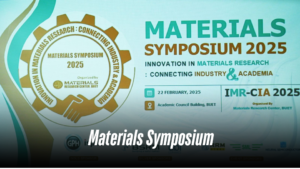
Materials Symposium: Pioneering the Future of Materials Science Through Innovation and Collaboration
With the aim of connecting academia and industry, the Bangladesh University of Engineering and Technology (BUET) hosted the Innovation in Materials Research – Connecting Industry and Academia (IMR-CIA 2025) symposium on February 22, 2025. The one-day event, held at BUET’s Academic Council Auditorium, brought together leading scientists, engineers, and industry pioneers to explore advancements in materials science and their real-world applications. Chaired by Dr. Fahmida Gulshan, Professor, Department of Materials and Metallurgical Engineering, BUET and co-chaired by Dr. Muhammad Hasanuzzaman, Associate Professor, Department of Nanomaterials and Ceramic Engineering, BUET, the symposium was organized by a distinguished committee of Materials Research Centre, BUET, composed of experts in the field of materials science. The chief patron of the organization is Prof. Dr. A.B.M. Badruzzaman, Vice-Chancellor, BUET. The symposium was presided over by Dr. Fahmida Gulshan. It commenced with a welcome speech by Dr. Muhammad Hasanuzzaman. Prof. Dr. A.B.M. Badruzzaman, gave his speech as the chief guest. A plenary speech was then delivered by Prof. Dr. A.S.M.A. Haseeb, Head, NCE, BUET, Bangladesh. The event featured experts from both academia and industry, who shared insights on the latest breakthroughs in materials science, manufacturing innovations, and strategies to foster collaboration between research institutions and corporate enterprises. The symposium focused on four major themes, each representing a crucial area in modern materials research: Steel: With sustainability in focus, discussions delved into emerging high-strength steels for automotive and construction applications, innovations in steel recycling and green steel production, and advanced corrosion-resistant coatings. Ceramics, Glass, and Cement: Industry leaders highlighted advancements in energy-efficient manufacturing, AI-automated process optimizations, product diversification and waste utilization strategies for economic and environmental benefits. Semiconductors: With the global chip shortage still a concern, speakers discussed the challenges in semiconductor scaling, the role of advanced materials in next-generation electronics, and sustainable manufacturing practices. Additive Manufacturing: Experts showcased breakthroughs in 3D printing for industrial applications, material characterization, and AI-enhanced manufacturing processes, emphasizing its potential to revolutionize supply chains. Renowned experts from leading organizations and academic institutions delivered keynote speeches on groundbreaking advancements in materials science and manufacturing. They were – from Intel Corporation. USA – Dr. Zakir Ahmed, Research Scientist, Intel Labs; Dr. Md Waliullah Khan Nomani, PTD Module and Integration Yield Engineer, PTD; Dr. Shaestagir Chowdhury, Principal Engineer; Dr. Syed Samsul Amin, Principal Engineer & Packaging Architect. Other honorable speakers included Dr. Kafil M. Razeeb, Principal Scientist and Team Leader, Tyndall National Institute – Cork University, Ireland; Prof. Dr. Syed Ansar Md. Tofail, Head, Physics, University of Limerick, Ireland; Mr. Mohammad Zahirul Hoque, Director, Q.C. Metallurgical Laboratory, Inc, IOWA, USA; Dr. Ehtsham-Ul Haque, Assistant Professor, Dept. of Physics, University of Limerick, Ireland; Dr. Nazmul Alam, Principal Research Scientist (Retd.), CSIRO, Adjunct Professor, RMIT University, Australia; Dr. Md Zakaria Quadir, Associate Professor, School of Civil and Mechanical Engineering (CME), Curtin University, Australia; Dr. Qumrul Ahsan, Vice-Chancellor, University of Asia Pacific, Bangladesh; Dr. Sheikh Manjura Hoque, Head, Materials Science Division, Atomic Energy Commission, Bangladesh. The symposium also hosted specialized panel discussions featuring leading academics and industry professionals in the steel, ceramics, semiconductor, additive manufacturing fields. Steel Industry Panelists included Dr. Sazzad Ahmed, Associate Professor, MME, CUET, Bangladesh and Mr. Md. Saiful Islam, Deputy General Manager, Research and Development, GPH Ispat Limited, Bangladesh. From Semiconductor Industry Panel, Dr. Mainul Hossian, Associate Professor, EEE, DU, Bangladesh and Dr. Kafil M. Razeeb, Principal Scientist and Team Leader, Tyndall National Institute-Cork University, Ireland gave their speech. Additive Manufacturing Panelists included Dr. M. Tarik Arafat, Head, BME, BUET, Bangladesh, Dr. Md. Jalal Uddin, P. Eng., Director, BITAC, Bangladesh, Dr. Md Zakaria Quadir, Associate Professor, School of Civil and Mechanical Engineering (CME), Curtin University, Australia. The Ceramics Industry Panelist was senior journalist Mr. Anwar Haq, Head of Brand, Communication & Corporate, Pa-Wang Ceramic Industry Ltd., Bangladesh. And, the Entrepreneurship Panel was comprised of Engr. Md. Fahim Rahman, Head of Operations, METTALLIED, Bangladesh. The symposium also served as a platform for young researchers, with a competitive poster competition drawing entries from students across multiple disciplines. The top ten posters received recognition awards, while the top three submissions were awarded BDT 25,000, BDT 15,000, and BDT 10,000, respectively. This initiative provided an incredible opportunity for young researchers to showcase their work and gain insights from seasoned professionals into the evolving landscape of materials science. A recurring theme of the symposium was the urgent need to strengthen partnerships between industry and academia. Speakers emphasized that collaborative research, workforce development, and industry-driven projects are crucial to accelerate technological progress. Case studies from companies like Intel Corporation and GPH Ispat Ltd. demonstrated how industry collaborations have turned theoretical research into practical applications. With its blend of insightful discussions, expert panels, and student engagement, IMR-CIA 2025 successfully established a precedent for future collaborations between academia and industry. At its core, this was more than just a symposium—it was a call to action for the next generation of innovators. Speakers emphasized the need for young minds to embrace cutting-edge technology, think beyond conventional boundaries, and actively contribute to scientific advancements. By fostering collaboration between industry and academia, the event aimed to create an ecosystem where students, researchers, and professionals can work together to drive transformative change in materials science and engineering. As Bangladesh moves toward an innovation-driven economy, the knowledge shared at this symposium is expected to play a crucial role in achieving sustainable advancements in materials science and manufacturing. Written By Anonno Aziz Nibir
Read More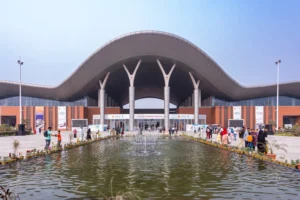
The state-of-the-art pavilions draw huge crowds at DITF-2025
With a view to attracting local and foreign visitors, the exhibitors of the month-long 29th Dhaka International Trade Fair (DITF)-2025 brought innovative architectural view at their pavilions and stalls made of various materials such as steel, board, wood, bamboo, electric cables, lights, colour and ceramic items. Chief Adviser to the Interim Government Prof Dr Muhammad Yunus inaugurated the fair at the Bangladesh-China Friendship Exhibition Centre in Purbachal, Narayanganj on 1 January, 2025. Commerce Adviser Sk Bashir Uddin and Export Promotion Bureau (EPB) Vice-Chairman Md Anwar Hossain also attended the opening ceremony. This year, 343 domestic and foreign companies took part in the fair, including 11 companies from India, Pakistan, Turkey, Singapore, Indonesia, Hong Kong and Malaysia in addition to Bangladesh. Last year, 304 companies participated in the fair, including 9 foreign companies from 5 countries. The companies set up premium pavilions, mini pavilions, and reserved pavilions at the fair venue to display various products including textiles, furniture, electrical and electronics, jute and jute products, leather products, machineries, cosmetics, home furnishings, toys, stationery, crockery, plastics, melamine, herbal and toiletries, imitation jewellery, processed food, fast food, and handicrafts. Of them, many exhibitors also offered discounts ranging from 5 to 50 per cent as well there to attract more buyers. The Ministry of Commerce and EPB have organised DITF since 1995 to promote export growth and market diversification. This is the third edition at its new venue in Purbachal, following the relocation from Sher-e-Bangla Nagar in 2022. Pavilions and stalls were awarded due to innovative architectural view The best pavilions, stalls and organizations participating in various categories were recognized by presenting crests at the closing ceremony of the fair. The first prize was awarded to 22 best companies in different categories (Kiam Metal Industries Limited, Akij Plastics Limited, RFL Plastics Limited, Prisons Department, Pran Agro Limited, M/s. Helal & Brothers, Sena Kalyan Sangstha, JDPC, BGMEA, BKMEA, Hatil Complex Ltd., Jamuna Electronics & Automobiles Ltd., Navana Furniture Limited, Vision Electronics, SME Foundation, BSCIC, Orijinal Istanbul Kristal, Turkey, Pentel (Singapore) PTE Ltd., Singapore, Kewpie Malaysia SDN, BHD, Malaysia, Sonali Bank PLC, Islami Bank Bangladesh PLC and People’s Leather Industries. The second prize was awarded to 16 companies in different categories (Savoy Ice Cream Factory Ltd., Square Food & Beverage Ltd., KY Two Tone Ltd., Alloy Aluminum Furniture Limited, Exclusive Home Tex Industries Limited, Bangladesh Machine Tools Factory Limited, Bangladesh Tea Board, Nadia Furniture Limited, Minister Hi-Tech Park Limited, Brothers Furniture, Hatim Steel Structure Limited, JMG International, Hadeks Hali DeriTekstil Dis Tic A.S., Turkey, PT Nissin Foods, Indonesia, Rabab Trading International, Hong Kong and Dutch Bangla Bank PLC. The third prize was awarded to 13 companies in different categories (Delhi Aluminium Factory, Abul Khair Milk Products Limited, SKB Stainless Steel Mills Limited, Abdul Monem Limited, BRB Cable Industries Limited, Leathergoods and Footwear Manufacturers and Exporters Association of Bangladesh, Rangpur Metal Industries-Regal Furniture, Walton Hi-Tech Industries PLC, Joyita Foundation, Messrs. Nurul Textile, M/S Tarique Carpet Industries, Indian Carpet Industries, and Indian Oriental Carpet, India). Touhiduzzaman, Deputy General Manager [Public Relations] PRAN-RFL Group said, “We have a lot of products like food stuffs, plastics items, furniture, and electronics. We display the products for customers at the exhibition every year. We receive the best pavilion awarded each year due to innovative architectural view.’ He pointed out that they always try to build their pavilion at the fair venue with excellent architectural views in new shapes to draw large crowds. “As there is a limited space and it is a temporary place, so we build our stalls considering it. After getting tender from the EPB, we talk to different firms of interior designers and architects. Basically they set up the pavilion as per our direction,” he added. Touhiduzzaman stated that the stalls are set up by different construction materials like wood board, steels, tiles, bricks and others. He remarked that their main goal is to attract more customers. We decorate our stalls focusing our products. We will try to make the best pavilions in coming days as well,” he also commented. Mahin Sarker, Pavilion In-Charge of Square Food & Beverage, noted that their stall has been a hotspot for visitors due to excellent architectural views. Our pavilion got the second best pavilion award this year. “We offered up to a 50% discount on our food and beverage items, so a lot of people purchased our products. Additionally, as our company set up an attractive pavilion so visitors drew largely here,” he added. Another a-three day fair only for exportable items in October/ November Talking to the Ceramic Bangladesh, CEO and Vice-Chairman of the EPB Md. Anwar Hossain said they tried to bring excellent architectural view in the DITF-2025. At the first time, we introduced innovative features and enhance the fair’s experience for visitors, particularly after the historic student-led revolution on 5 August, 2024. “We introduced new attractions like the 36-July Chattar and Mugdha-Sayyed Corner to showcase the revolution’s impact. Additionally, visitors enter the fair with e-tickets, eliminating the hassle of manual ticket collection.” Hossain emphasised the fair’s role in supporting local businesses and diversifying products to boost foreign currency earnings. “We invited many ceramic companies but they did not give positive response in the fair. We hope that in the next year fair, we can attract many ceramic companies in the expo as it is the potential and exportable products. “We try to organize another a-three day expo at the first time at Purbachal venue in October or November where only exportable products will be displayed. It will help to attract more foreigners. We have no actual data on foreign visitors that how many foreign visitors visited the DITF-2025 and export orders too but many foreign visitors came here,” he highlighted.
Read More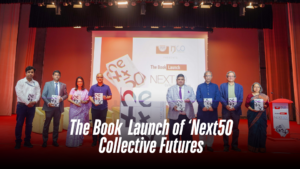
The Book Launch of ‘Next50: Collective Futures
A significant milestone in shaping Bangladesh’s future was marked today with the official launch of Next50: Collective Futures at BRAC University’s Multipurpose Hall. This landmark publication—the largest edited volume on Bangladesh’s built environment—brings together 81 authors, including many from the Bangladeshi diaspora, to explore the nation’s next five decades of progress, innovation, and connectivity. Spanning 49 chapters across nine major themes, the book examines urban and rural transformation, infrastructure, climate resilience, housing, governance, and technological innovation. Written in accessible language for policymakers, practitioners, and the general public, it bridges cutting-edge research with real-world impact, making complex ideas actionable for those shaping the nation’s future. The event was attended by some of Bangladesh’s most prominent architects, planners, and urbanists from both academia and professional practice. Distinguished guests included Dr. Syed Ferhat Anwar, Vice-Chancellor of BRAC University, and Mohammad Azaz, Administrator of Dhaka North City Corporation, who underscored the urgency of visionary thinking in driving sustainable and inclusive development. The program featured a compelling book introduction by Professor Fuad H. Mallick, Editor-in-Chief of Next50 and Dean of the School of Architecture and Design at BRAC University, followed by an insightful review from Dr. Mohammed Zakiul Islam, Professor at BUET, who highlighted the book’s interdisciplinary approach and its relevance to Bangladesh’s rapidly evolving urban landscape. Adding to the discussions, key stakeholders, including representatives from Shah Cement, reflected on the private sector’s role in shaping the built environment. The event concluded with remarks from the book’s executive editors, Dr. Tanzil Shafique and Dr. Saimum Kabir, who emphasized the collaborative effort behind the publication and its potential to influence future policies and practices. Shah Cement also expressed interest in future collaborations. Beyond the discussions, the launch served as a key networking platform for scholars, policymakers, and industry leaders, fostering dialogue and collaboration on the country’s long-term development. Attendees engaged in meaningful conversations over Iftar and dinner, reinforcing the event’s role in strengthening professional and intellectual ties. Organized by Open Studio and Context BD, with support from Shah Cement, the event also reached a wider audience through a live stream, ensuring broader engagement with the book’s mission.
Read More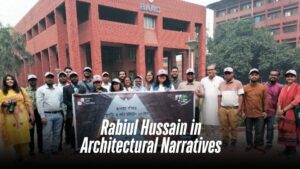
Rabiul Hussain in Architectural Narratives
On February 28, 2025 Bangladesh Institute of Architects (IAB) and the Bangladesh Liberation War Museum organized a day-long program to tribute architect Rabiul Hussain through visiting 3 of his projects- Bangladesh Agricultural Research Council (BARC), Jalladkhana Killing Ground and Jahangirnagar University. and taking a vow to protect the diversified works of the architect. Architect Rabiul Hussain (January 31, 1943 – November 26, 2019) was a prominent Bangladeshi architect, poet, art critic, short story writer, essayist, and cultural activist. A person of multifaceted talent, honored by the Government of Bangladesh with the Ekushey Padak for his contributions to language and literature in 2018, received the Bangla Academy Literary Award for his contributions to poetry in 2009, and the Bangladesh Institute of Architects (IAB) awarded him the Gold Medal for his outstanding contribution to architecture in 2016. He served four times as the President of the Bangladesh Institute of Architects, Vice-Chairman of the Architects Regional Council of Asia (ARCASIA), Vice-President of the Commonwealth Association of Architects, and President of the South Asian Association for Regional Cooperation of Architects. In addition, he was a trustee of the Liberation War Museum, an executive member of the 1971 Ghatok Dalal Nirmul Committee (Committee for Elimination of Martyrs’ Assassination), and made significant contributions to the preservation of the memories of the Independent War of Bangladesh. Although he was born in the village of Ratidanga in Shailkupa Upazila, Jhenaidah District, he completed his secondary and higher secondary education in Kushtia District. Later, in 1968, he earned his Bachelor degree in architecture from the then East Pakistan University of Engineering (now Bangladesh University of Engineering and Technology). After obtaining the graduation, he began his professional career as an architect working with architect Mazharul Islam and later joined Shahidullah Associates. Alongside his architectural practice, he also maintained a strong passion for writing. Throughout his career, he served as a life member of the Bangla Academy, and was involved in various organizations, including the Central Kachi-Kachhar Mela (a children’s and youth organization), the National Poetry Council, the Bangabandhu Sheikh Mujibur Rahman Memorial Museum, the International Film Critic Association of Bangladesh, and the Bangladesh Institute of Architects. Notable buildings designed by him include the Jalladkhana(Execution House), the Bangladesh Agricultural Research Council building, the entrance gate of Dhaka University, the Liberation and Independence Arch, the Jahangirnagar University gate, the Bhashani Hall, the Bangabandhu Hall, the Sheikh Hasina Hall, the Khaleda Zia Hall, the Wazed Mia Science Complex, the auditorium and academic building complex of Chittagong University, and alongside architect Mazharul Islam, the Bangladesh Agricultural Research Institute in Gazipur, Haji Mohammad Danesh Science and Technology University in Dinajpur, and polytechnic institutes in Chittagong and Khulna, among others. Bangladesh Agricultural Research Council (BARC) The Bangladesh Agricultural Research Council (BARC) was established in 1973 with the aim of conducting agricultural research and coordinating various related institutions in Bangladesh. Almost a decade after its founding, in 1982, architect Rabiul Hussain designed its current building. The design process, which began in 1978, spanned nearly four years. In a remarkable way, he crafted a unique architectural design using red brick masonry that harmonized with Bangladesh’s climate, nature, and way of life. This building is a symbol of post-independence architecture, reflecting a search for an architectural style; that is free from the burden of colonization in a newly liberated land. Each detail of the building echoes the same vision. The regional architectural influence of Maestro Mazharul Islam, the pioneer of Bangladesh’s regional architecture, is evident in the design, which he was fortunate to experience starting from his third year of architectural education. The building, located on a site shaped like the letter ‘L’ in the English alphabet, is easily noticeable among surrounding roads and structures. It stands at the junction of Airport Road and Khamar Bari Road, near Farmgate and Bijoy Sarani. The design symbolizes various aspects of aesthetic gravity, marking an early effort in the evolution of post-independence Bangladeshi architecture and the search for a Bengali “identity” in the country’s-built environment. The location of the building, near the capital’s main international airport at Tejgaon, limited the building’s height to four floors. The rectangular building, measuring 223 feet in length and 63 feet in width, has a total built-up area of 32,700 square feet. It is aligned along the east-west axis and is equipped with optimal provisions for cross-ventilation and prevailing south winds. The three-story building is vertically divided into three functional zones. The first floor is allocated for administrative offices; the second floor houses the executive branch. The third floor features a 7,500-square-foot conference room with seating for 280 people at its center, along with a 1,350-square-foot library and a meeting room. The first and second floors are organized along a double-loaded corridor, with two staircases at the eastern and western ends of the building. In harmony with local traditions, the roof was projected to protect the building from torrential rain and scorching sun. The BARC building essentially consists of two parts: one is the brick-clad inner shell that spans the main area, while the additional levels moderate the harsh tropical sun and protect the building during the monsoon season. Architect Mazharul Islam’s office- Vastukalabid was a key influence in experimenting with such a critical combination of climate consideration and modernist aesthetics along with that of brick mason for architect Rabiul Hussain and many young architects in the early 1970s. To give an example, his designs, including the National Institute of Public Administration (1964), encouraged a generation of architects to explore “critical regionalism” through a lens that considered climatic aspects in the visual language of architecture. Since stone is rare and fired bricks can be produced in abundance from local clay, architects saw bricks as an unprecedented symbolic representation of the delta and its culture. Representing the soil of the riverine country, bricks were the purest or most organic building material believed by the Bangladeshi architects. The “poetry” of bricks is hard to miss in the concept and construction of the BARC headquarters building. Also, the influence of
Read More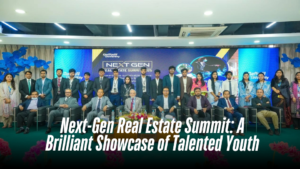
Next-Gen Real Estate Summit: A Brilliant Showcase of Talented Youth
To discuss the development and future prospects of the real estate sector, the Department of Real Estate, Daffodil International University organized the “Next Gen Real Estate Summit 2025”. This grand summit took place on February 23 and 24 at the Ashulia campus of Daffodil International University, where key figures from various government and private organizations were present. Representatives from BUET, RAJUK, House Building Finance Corporation, REHAB, the National Housing Authority (NHA), and various other industrial institutions participated in the event. The two-day summit featured formal sessions, cultural programs, and a Mezban feast. The formal session was held at the International Conference Hall of Daffodil International University, where expert speakers discussed the future development of the real estate industry and the importance of sustainable housing. The panel discussion was attended by Professor S. M. Mahbub Ul Haq Majumder, Pro Vice-Chancellor, Daffodil International University; Professor Mustafa Kamal, Dean of Academic Affairs; Professor Mohammad Masum Iqbal, Dean of the Faculty of Business & Entrepreneurship; M. Mahbubur Rahman, CEO of Rupayan City Uttara; Md. Mobarak Hossain, Director, REHAB; Kamrul Hasan, Deputy Town Planner, RAJUK; and Md. Golam Mostafa, Deputy General Manager and Chief Engineer, House Building Finance Corporation. The welcome speech at the conference was delivered by Dr. Amir Ahmed, Head of the Real Estate Department at Daffodil International University. A lively cultural event took place at the Student Lounge and the Independence Conference Center, while the Mezban feast was held at Golap Gram. One of the main attractions of the summit was the Poster Presentation Competition. The theme of the competition focused on innovative ideas in the real estate and housing sector, which are expected to play a crucial role in improving future living standards. A total of 10 teams from Dhaka University, CUET, Khulna University, Jahangirnagar University, KUET, and Daffodil International University participated in this competitive event. Each team consisted of two members from the Urban Planning, Architecture, Civil Engineering, and Real Estate departments of their respective universities. Participants presented their research-based ideas, designs, and plans for the future development of the real estate sector. At the end of the competition, the judges selected the top three teams as winners. The judging panel consisted of Nizam Ahmed, Major General (Retd.), Engineer Mujahid Monir, Major (Retd.), and Anwar Haque, Senior Journalist and Brand Communication & Corporate Head of Pa-Wang Ceramics. The first-place winners were jointly Mirajul Islam Alif and Tasnuha Pasha Tonu from Daffodil International University, and Abrar Muhtasim Pathan and Souda Samiha from Khulna University. The second-place winners were Fauzan Anowar and Fathan Anowar from Daffodil International University. The third-place winners were Minhazur Rahman Shafin and Hamim Mubtasim from Dhaka University. At the award ceremony, the distinguished guests highly praised the participants’ innovative ideas and creativity, wishing them success in their future research and development efforts in the housing sector. Dr. Amir Ahmed, Head of the Real Estate Department at Daffodil International University, stated that competitions like this inspire students to engage in new ideas and research. He added that the application of technology and innovative concepts in the real estate industry will play a vital role in the future development of housing systems. The “Next Gen Real Estate Summit 2025” was not just a conference; it served as an open platform for discussions on the role of technology in future urban planning and the real estate sector. Experts believe that student participation, research, and innovative presentations will open new horizons for the development of the real estate industry. Written by Anonno Aziz Nibir
Read More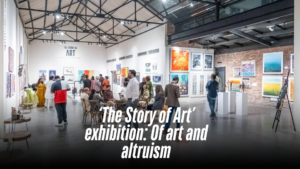
‘The Story of Art’ exhibition: Of art and altruism
Organized by Dhaka Storytellers from February 8 to February 13, the lush gallery space Aloki Greenhouse in the capital’s Gulshan hosted an exhibition titled The Story of Art. The exhibition boasted a stunning collection of 80 to 90 artworks, captivating audiences for a week. Curated by Syeda Adiba Hussain, co-founder of Dhaka Storytellers, The Story of Art was more than just a display of artistic excellence. This was Dhaka Storytellers’ second art event, following the charity exhibition Art for Charity in August 2024. In the same vein, The Story of Art supported a larger cause, with a portion of the proceeds donated to five schools and one college in Sylhet, demonstrating the power of art to create tangible change beyond gallery walls. Beyond the beauty of its displays, the exhibition underscored the immense power of art to inspire and drive change. By merging artistic excellence with humanitarian efforts, it aimed to uplift communities, empower individuals, and support crucial social causes. Having been in the making for almost a year, the exhibition was carefully planned to bring together some of Bangladesh’s most celebrated artists. The lineup included some of the country’s most notable names, such as Rafiqun Nabi, Monirul Islam, Hamiduzzaman Khan, and Kanak Chanpa Chakma. Furthermore, the exhibition commendably featured artworks by several emerging artists, creating a dynamic collection that bridged generations of artistic expression. From simply beautiful paintings to thought-provoking sculptures, The Story of Art was also an opportunity for both seasoned and budding collectors to acquire unique pieces while contributing to a noble cause. The grand opening on Friday, February 7, set the tone for the week-long exhibition. The launch was attended by an invitation-only audience, including the participating artists, their families, media professionals, and notable guests. As the exhibition drew to a close, it left behind more than just a collection of breathtaking visuals; it also left an indelible impression on those who visited. The fusion of artistic expression with social commitment deeply moved attendees, inspiring them to consider the vast potential of art beyond aesthetics. The exhibition carried a narrative that extended far beyond the gallery walls, reinforcing the idea that art is not merely to be observed but to be experienced, felt, and acted upon. The event was about more than just admiring artworks—it was about creating a shared vision where artists, curators, and spectators all committed to a cause bigger than themselves. It demonstrated that art has the ability to transcend traditional boundaries, reaching into the hearts of individuals and communities, sparking conversations, and inspiring action. Ultimately, The Story of Art was a celebration of creativity’s ability to inspire, connect, and transform lives. The week-long show was a powerful testament to the transformative synergy between art and altruism. It showcased how art exhibitions, when intertwined with a greater purpose, can spark meaningful change. Written By Shahbaz Nahian
Read More
Akij Tableware Announces Bangladesh’s First Food Plating Reality Show, “Art of Plating: Season 2” Offering 20,00,000 BDT in Prizes
Following the overwhelming success and audience acclaim of its first season, Akij Tableware is proud to announce the return of Bangladesh’s first-ever food plating reality show, “Akij Tableware Art of Plating,” with the launch of its second season. The show aims to discover the nation’s most talented food plating artist, with the winner taking home a grand prize of 10,00,000 BDT. In addition to the grand prize, the competition offers substantial rewards for the runners-up. The first runner-up will receive 5,00,000 BDT, while the second runner-up will be awarded 3,00,000 BDT. Furthermore, the top 30 contestants will be honored with a variety of prizes, including crests, certificates, culinary courses, and exclusive dinner sets from Akij Tableware, culminating in a total prize pool of 20,00,000 BDT. Commenting on the initiative, Chief Operating Officer of AkijBashir Group Md. Khorshed Alam shared, “After receiving an enthusiastic response in season one, we have expanded this season to encompass a broader audience, uniting plating artists from all corners of Bangladesh. Our goal is to present the unique culture and storytelling embedded in food plating art to the world and enrich this creative field.” The highly anticipated reality show will be broadcast on NTV, Channel i, and Deepto Television, with availability on popular OTT platform Chorki. Participants are required to submit photos of their best food plating through the official website. From there, experienced and renowned chefs will select the top 30 contestants based on their creativity and skills, providing them with the opportunity to showcase their talents on national television. At a press conference held on Tuesday, February 4, 2025 at a renowned hotel in the country, the chief judge of the show Chef Daniel C. Gomez, Head of Marketing of AkijBashir Group Md. Shahriar Zaman, and Chief Operating Officer of the company Md. Khorshed Alam, and officials of Akij Tableware were present. They shared insights into the upcoming season, underscoring its mission to celebrate food plating as an art form and provide a platform for local talent to shine on a national stage.
Read More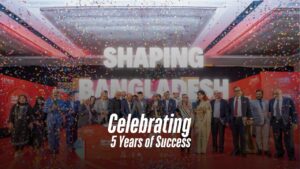
Celebrating 5 Years of Success
The soft glow of chandeliers illuminated the polished ceramic tiles as industry leaders, architects, and innovators gathered at the Sheraton Hotel in Dhaka. The air was filled with excitement as enthusiasts and professionals came together to celebrate the 5th anniversary of Ceramic Bangladesh Magazine. The event, styled “Shaping Bangladesh: Designing Tomorrow, Building Today,” was more than just a conference — it was a call to action for Bangladesh’s construction, real estate, and ceramic industries to embrace sustainability, innovation, and resilience. This milestone event marked a significant achievement for the publication, which has become a cornerstone of the ceramic industry in Bangladesh. Held on 30 January 2025, the event brought together experts to discuss the evolving landscape of architecture, engineering, and sustainable building materials. From leading ceramic manufacturers to top architects, the gathering aimed to chart a vision for a greener, more efficient Bangladesh. Preparing for the Future and Post-LDC Impact One of the central themes was Bangladesh’s upcoming graduation from its least-developed country (LDC) status in 2026. Chief guest SK Bashiruddin, Commerce Adviser to the interim government, emphasised the need for businesses to prepare for the challenges ahead. “In the coming years, Bangladesh will face numerous challenges following the LDC graduation. Innovation is crucial for progress. Corruption and bureaucratic complexities have hindered business growth over the past 15 years, but our focus should be on sustainability to foster industrial growth,” he said. He called for collaboration among stakeholders to lower operational costs, innovate, and create a more business-friendly environment. He acknowledged the ceramic industry’s contributions, commending entrepreneurs for their innovative products that enhance both aesthetics and functionality in modern infrastructure. Special guest, RAJUK Chairman Major General (retd) Mohammad Siddiqur Rahman Sarker, stated that even 100-storey buildings would be permitted if built in an environmentally friendly manner. Hence, the DAP (Detailed Area Plan) is being amended. The seminar commenced with a grand welcome address by Mr. Irfan Uddin, the Editor-in-Chief of Ceramic Bangladesh Magazine, who reflected on its journey over the past five years. He expressed gratitude to the readers, contributors, and industry partners who have supported the magazine’s mission to promote and celebrate the country’s ceramic industry. Innovation & Sustainability in Construction The event featured two thought-provoking panel discussions. The first session, “Innovation for a Sustainable Future: Exploring Material Innovations & Sustainability,” moderated by Dr. Amir Ahmed, Associate Professor and Head of the Department of Real Estate at Daffodil International University, focused on cutting-edge sustainable materials and circular economy principles in the real estate and construction sector. The second session, “Building a Greener Future: The Role of Sustainability in Architecture,” led by Architect Zannat Jui, explored green building certifications, passive design strategies, and the role of technology in climate-resilient infrastructure. Several notable speakers included esteemed professors and architects, such as former BUET Prof. Dr. M Shamim Z Bosunia, Architect Prof. Abu Sayeed M Ahmed, Ar. Prof. Rafiq Azam, Ar. Jalal Ahmed, Ar. Nazli Hussain, Ar. Bayejid Mahbub Khondker, Ar. Didarul Islam Bhuiyan Dipu, Ar. Khondoker Asifuzzaman Rajan, RAJUK Chief Engineer Mohammad Nurul Islam, Engr. Shamsul Alam, Executive Director (Design) of Concord Real Estate Limited Ar. Faisal Ahmed, Managing Director of BTI Engr. Faizur Rahman Khan, Chief Operating Officer of AkijBashir Group Mohammad Khourshed Alam, Chief Operating Officer of Meghna Ceramics Industries AKM Ziaul Islam, Director of GPH Ispat Salehin Musfique Sadaf, Chief Business Officer of Metrocem Cement Ltd. Asadul Haque Sufyani, Consultant of Khadim Ceramics Babor Hossain, and Senior Vice President of BCMEA Mohammad Mamunur Rashid emphasized on the vital role Ceramic Bangladesh Magazine has played in showcasing architectural innovations. Ar. Professor Rafiq Azam, the Principal Architect of SHATOTTO Architecture for Green Living, and Ar. Professor Dr. Abu Sayeed M. Ahmed, the President of the Institute of Architects Bangladesh (IAB), delivered two distinct keynote speeches titled “The Art of Social Changes” and “Reviving the Roots: Conservation and Restoration Progress in Bangladesh,” respectively. Chief Operating Officer (COO) of AkijBashir Group Mohammad Khourshed Alam said the crisis of gas and electricity is the biggest challenge for industries in the country right now. Gas is crucial for the ceramic industry’s development. “However, we have to focus on solar energy to continue industries. Technology adaptation should be focused as well,” he added. AKM Ziaul Islam, Chief Operating Officer (COO) of Meghna Ceramic Ind. Ltd, said the ceramic industry has huge opportunities. There is a need to increase the interaction between industries and academia. Salehin Musfique Sadaf, Director of Strategy & Transformation at GPH Ispat, emphasized that Bangladesh lacks sufficient raw materials to meet its demands. He pointed out that energy sources such as gas or coal are also considered raw materials. Therefore, the country must focus on adequate coal as a locally cheaper energy source and adopting recycling methods to increase the use of recycled construction materials. He stressed the importance of research and development (R&D) in achieving these goals. Role of the Ceramic Industry BCMEA President Moynul Islam reiterated the ceramic industry’s commitment to sustainability, highlighting the need for government support and private sector collaboration to foster long-term growth and global competitiveness. Industry leaders stressed the need for increased research and development (R&D) in using recycled construction materials and ensuring sustainable building practices. As Bangladesh moves toward rapid urbanisation and economic transformation, “Shaping Bangladesh: Designing Tomorrow, Building Today” underscored the need for innovation, sustainability, and resilience. The discussions at the event served as blueprints for a more sustainable Bangladesh. Moynul Islam also said, “Bangladesh’s upcoming LDC graduation in 2026 presents many challenges for the local ceramic industry. With the loss of preferential market access, export tariffs are likely to increase, making our products less competitive in global markets. In addition, imports will also increase due to trade liberalization and FTAs in the post-LDC period. To maintain our position, we must focus on innovation, quality enhancement, and cost efficiency. Strengthening partnerships, investing in modern technologies, and adopting sustainable practices will be key to navigating this transition and positioning Bangladesh as a trusted ceramic exporter in the region.” Sustainability Efforts Mohammad Mamunur Rashid, Senior
Read More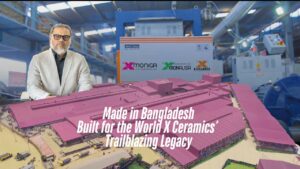
Made in Bangladesh Built for the World X Ceramics’ Trailblazing Legacy
For over a thousand years, ceramics have shaped civilizations—gracing grand palaces, elegant table settings, and timeless architectural masterpieces. Once a symbol of affluence, these exquisite creations gradually became integral to daily life. Like the rest of the world, Bangladesh embraced ceramics. For years, the country relied on imports to meet its growing demand. But that era is now history. Today, Bangladesh’s ceramic industry stands strong, catering to domestic needs and expanding its footprint in international markets. A Market Leader in Innovation The ceramic sector thrives on three key pillars—ceramic tableware, tiles, and sanitaryware. Among the pioneers driving this evolution is X Ceramics Limited, a company synonymous with innovation and excellence. A subsidiary of Index Group, X Ceramics has played a vital role in positioning Bangladesh as a key player in the global ceramics market. Founded in 2009 by visionary entrepreneur Mahin Mazher. X Ceramics began commercial operations in February 2010 as a Bangladesh-Italy joint venture. From crafting exquisite designs to setting industry benchmarks, X Ceramics continues to push the boundaries of craftsmanship, resilience, and vision. Game-Changing Innovations X Ceramics has been a trailblazer, introducing groundbreaking innovations: Homogeneous 60×60 cm Tiles: Before this, the domestic market mainly featured 30×30 cm and 40×40 cm tiles. X Ceramics pioneered the production of larger homogeneous tiles. Polished Glazed Vitrified Tiles (PGVT): The first company in Bangladesh to introduce PGVT, raising the bar for durability and aesthetics. In 20x30cm tiles x ceramics bring the concept of light, deep and hi liter tiles. Before x ceramics there are concepts of decor & border concept. In 30x45cm tiles x ceramic first introduce digital print tiles. X ceramics is the first company who introduce soluble salt tiles in Bangladesh market. Specialty Tile Ranges: Exclusive collections such as Royal Wall Series, Anti-Slip 30×30 cm, Rock-X Series, Stone Shield, Temp Control Tiles and X Germy Proof—all designed for both functional and decorative excellence. With state-of-the-art manufacturing facilities and a commitment to R&D, X Ceramics has diversified design possibilities and aligned with global architectural trends. Expanding Horizons: Entering the Sanitaryware Market With a stronghold in tiles, X Ceramics is now entering the sanitaryware segment, with commercial production expected to begin in March or April 2025. A Leader in Bangladesh’s Porcelain & Ceramic Tiles Industry X Ceramics is one of the largest porcelain and ceramic tile manufacturers in Bangladesh, focusing on eco-friendly production and customer satisfaction. With cutting-edge technology, it has redefined industry standards, setting a new benchmark for excellence. X Ceramics proudly presents Bangladesh’s first Germi-Proof Jaynamaz tiles, offering 99% protection against harmful germs with advanced antimicrobial technology. Versatility in Design & Durability: Quality That Lasts X Ceramics offers a diverse range of tiles suitable for both residential and commercial spaces. Key features include: Easy to clean Superior durability (lasting over 20 years) Toxin-free composition Weather-resistant, adaptable to extreme conditions Water, moisture, and UV-resistant Sustainability at Its Core Committed to environmentally responsible manufacturing, X Ceramics operates in an industrial zone in Gazipur’s Sreepur Upazila, located nearly 35 kilometers north of Dhaka, the capital of Bangladesh. The company strictly adheres to green practices, including: Rainwater & groundwater conservation Recycling facilities CFC-free cooling systems LED lighting & energy-efficient systems Solar power utilization Workplace Safety & Employee Well-being X Ceramics prioritizes occupational health and safety, ensuring fair wages, timely payments, and employee benefits. The company fosters a responsible work environment with transparency in production. “We are operating a round-the-clock Effluent Treatment Plant (ETP) to minimize the environmental impact and ensure the sustainability of our ceramic production process. By effectively treating wastewater, we aim to protect the local environment while upholding the highest standards of eco-friendly manufacturing,” said Mr Shahturur Rahman, Senior Vice President. “We are also planning to implement recycling initiatives for waste materials. Additionally, heat management is a key concern, and we are exploring solutions to reduce heat emissions in our operations,” he said. The Italian Touch: A Brand Synonymous with Quality X Ceramics is widely recognized as the brand ambassador of Italian ceramic tiles in Bangladesh. After just two years, the company began importing tiles from Italy’s renowned Monika brand, solidifying its position as a premium tile provider in the market. Shaping the Domestic and Export Markets According to Shahturur Rahman, the company prioritizes: Design innovation Quality enhancement Expanded production capacity Research and development Rahman noted that imports are declining due to the current political situation, making locally produced ceramics an increasingly attractive option. “We must break free from the fantasy of using foreign products. Our industry is fully capable of producing ceramics on par with international brands,” he said. The demand for premium-quality tiles has been growing by around 10 percent annually over the past decade, driven by affluent customers. With rising global demand, export opportunities for high-end tiles are expanding. Beyond Business: A Passion for Sports X Ceramics has also made a mark in the sports industry as the proud owner of Sylhet Strikers in the Bangladesh Premier League (BPL), the country’s premier T20 cricket tournament. With an unwavering commitment to excellence, X Ceramics is not just shaping the future of Bangladesh’s ceramic industry but also redefining global standards—one tile at a time. Ceramic Industry Struggles: Urgent Call for Gas and SD Relief Mr Shahturur urged the interim government to ensure a continuous gas supply and to remove the supplementary duty (SD) on local ceramic products to protect the industry. He highlighted that overall production, including that of his company, has sharply declined in recent months due to the ongoing gas crisis. “Challenges such as the gas shortage, price increases, SD, and rising operational costs have severely impacted the ceramic sector, turning it into a struggling industry,” Rahman added. Written By Sajibur Rahman
Read More
Sarah Resort The Evolving Elegance of Journey Beyond a Masterplan
While most architectural marvels begin with a scrupulously crafted masterplan, Sarah Resort took a different path, one of organic evolution. Instead of a rigid blueprint, it grew gracefully, expanding phase by phase through strategic land acquisitions. Nestled in the historic Bhawal Rajabari, Gazipur, just one and half hour drive from Dhaka, the resort is a masterpiece shaped by the creative vision of architect Naim Ahmed Kibria and architect Asia Karim Deepa from the renowned firm Indigenous. The inception of Sarah Resort wasn’t born out of commercial ambitions but rather from a personal desire – to create a retreat for friends and family. Md. Shahadat Hossan, the founder of Sarah Resort, originally owned 1.65 acres of wilderness in Gazipur (where the resort is located now). At the time, the land held nothing but an incomplete structure – mere pillars standing in solitude amidst nature. In late 2015, Md. Shahadat Hossan envisioned transforming this barren space into a gathering haven and set an ambitious goal: to host an event on 16 December, inviting loved ones to celebrate in a newly built retreat. To bring this vision to life, he turned to architect Naim Ahmed Kibria. To meet holiday desires, this initiative from Fortis Group is indeed in a class of its own. “Time was our biggest challenge,” recalls Mr Naim. “We had an incredibly tight deadline, and constructing a structure from scratch was nearly impossible. Instead, we decided to make use of the existing columns and beams.” What followed was a remarkable feat of architecture and determination. Within just one month, the team transformed the skeletal remains into a charming cottage, integrating brick gratings in the roof. The event was a success and everyone loved the cottage which merged effortlessly with the picturesque ambience. The appreciation evoked the desire in Mr Shahadat, to build a resort in the premise so that mass people can enjoy the beauty of the landscape. Md. Shahadat Hossan soon started acquiring neighbouring land, ensuring that every addition felt like a natural extension of the original landscape. The final phase of construction was completed in 2019, expanding the resort from 1.65 acres to an impressive 70 acres, with a built area of 3.21 acres. “It was an extensive project,” says Mr Naim. “We visited the site over 100 times to understand its natural flow, ensuring each expansion felt connected, organic, and immersive.” This fluid, intuitive approach resulted in a resort experience that feels more dynamic than a rigid masterplan could have allowed. We asked the architect what his favourite part from the resort was and he did not take a second to answer: it is the red cottages, arranged along a spiral pathway, forming a shape reminiscent of flower petals when viewed from above. Interestingly, the particular piece of land (where the cottages are located now) once housed an administrative estate of the Bhawal kings, surrounded by a protective moat which was dried up then. Instead of erasing history, the architects revived the moat and built the cottages around it, preserving its essence. Beyond the secluded cottages, Sarah Resort also has a 10-story tower for accommodation, offering a breathtaking panoramic view of the surrounding greenery. “Guests often tell us that waking up in the upper-floor rooms feels like floating in the clouds,” Mr Naim says. One of the most captivating aspects of Sarah Resort is its expansiveness – with nearly 95 per cent of its total area preserved as open space. Rather than altering the landscape drastically, the architects embraced the natural terrain, ensuring that every structure harmonises with its surroundings. Prioritising sustainability and authenticity, they relied predominantly on local materials, reinforcing the resort’s deep-rooted connection to its environment. The architectural philosophy of Sarah Resort bears a striking resemblance to the “Never demolish, always add, from inside out” approach pioneered by Lacaton & Vassal, the renowned French architectural duo. Anne Lacaton and Jean-Philippe Vassal won the 2021 Pritzker Architecture Prize, the most prestigious award in the field of architecture. Other than the aforementioned historic moat, another evidence to this approach is the restoration of the original clay houses found on the property. Instead of replacing them, architect Naim preserved and upgraded these traditional dwellings, equipping them with modern facilities while maintaining their rustic charm. At its core, Sarah Resort embodies an effortless fusion of nature and modern luxury. With an eco-conscious design that meets state-of-the-art facilities, it stands as a family-friendly haven, catering to visitors of all ages. From quaint cottages and restored clay houses to contemporary tower rooms and lodge accommodations, the resort offers a diverse range of stays, welcoming guests from all walks of life to experience its unique blend of heritage, innovation, and tranquility. For those in search of adventure, the resort houses an array of exhilarating activities, including zip-lining over scenic landscapes, boating across natural and artificial lakes, and exploring lush outdoor spaces. Guests looking to unwind can lounge by the swimming pool or take in the serene surroundings from various tranquil garden retreats. “The founder is a passionate sports enthusiast,” adds Mr Naim. “That’s why a significant portion of the resort’s land has been dedicated to outdoor recreation, ensuring guests can engage in a variety of activities while staying connected to nature.” Kaniz F Supriya
Read More
GPH Ispat Revolutionizing Steel Production with Green Practices
GPH Ispat Ltd takes pride in meeting all steel-related needs of its esteemed clients, combining top-notch quality products with unparalleled customer service. As articulated by GPH’s Director (Strategy & Transformation), Salehin Musfique Sadaf, in an exclusive interview to Ceramic Bangladesh, “GPH aims to fulfill all steel-related requirements of its extraordinary clients by offering best-quality products paired with exceptional service.” GPH Ispat Ltd, founded in 2006 and commenced commercial operations in 2008, embodying its guiding principles: God-fearing, Plain living, and High thinking. Conceived by visionary leaders and experienced traders, GPH was established to provide premium-quality steel products to the Bangladeshi market. Since its inception, GPH has relentlessly strived to deliver maximum value to its customers by consistently offering the best steel products available. The company made history in 2020 by introducing the Quantum Electric Arc Furnace—the world’s most advanced process for producing construction-grade steel—marking its debut in Asia. The extraordinary foresight of the founder, Mohammed Jahangir Alam, in establishing this state-of-the-art manufacturing unit, has garnered international acclaim. Industry experts from the USA, Saudi Arabia, and India have visited the facility to replicate its success in their respective countries. GPH has set an exemplary standard in prioritizing people and planet over profit by producing green steel products with minimal greenhouse gas (GHG) emissions. This trailblazing approach to sustainability has established GPH as a benchmark in the steel industry. “I was destined to return to my beloved Bangladesh—settling abroad was never part of the plan. Elevating Bangladesh on global platforms has always been my dream. Of all the sectors in our family business, I chose steel because of its transformative potential. Steel is not only versatile but also has the power to build nations and even reach into space,” shared Salehin Musfique Sadaf. Reflecting on a pivotal moment in 2017, Salehin described a conversation with his father while traveling from Dortmund to Bremen, Germany: “We discussed how developed nations have nurtured industries across generations to sustain their economies. These core industries, alongside their complementary sectors, have matured to surpass even their foundations in profitability. It became clear to me that investing in metals and materials is vital for Bangladesh’s self-reliance and economic resilience. Developing upstream and downstream industries could reduce trade deficits and save significant foreign currency.” At GPH, we produce Steel billets as semi-finished products and 3 different grades of construction grade steel rebar as finished product. Out of 420, 500 and 600 grade rebar, GPH is only able to produce 600 grade rebars in Bangladesh because of its distinct technical capability allowing stakeholders to be able to reduce their consumption while increasing performance. Due to maintaining the highest of the standards GPH was able to export around 125,000 metric tons of steel billet to China which is a net steel exporter country. Along with prime products since last 1 year we have partnered with Leviat Sdn Bhd, a global leader in construction technologies to promote optimized construction techniques and supporting products in Bangladesh. ‘Leviat’ is a part of fortune 500(S&P) company. We also sell medical and industrial grade oxygen and nitrogen to our valuable clients. The people who think about quality will always choose GPH because of its Moral integrity, its capability in utilizing valuable resources more efficiently and obviously visionary leadership behind it. The GPH products not only ensure the best physical property but also ensure the best chemical composition among any other brands. Sulphur and phosphorus being the most challenging elements in any mild steel products, with the help of best technology in steel making only GPH can maintain a proper ratio of these two elements consistently. These are not any claims, this can be easily proven by the test report gained from reputed facilities. When other brands are only being able to match the specification, GPH is passing tests with extraordinary differences compared to others which show our commitment to offer the best products in the market. With the only accredited lab facility in the steel industry, GPH supports stakeholders in realizing their aspirations with pride. The company’s devotion to economic, environmental, and social sustainability is reflected in its operations. For instance, GPH uses 115 kg of steel scrap to produce 100 kg of pure steel, ensuring unmatched quality. In comparison, other brands use only 112 kg of scrap for the same output—a testament to GPH’s pursuit of added purity and customer satisfaction. GPH is capable to produce 1.0 million tonnes of billet and different parts of prefabricated building materials each year. GPH Ispat Limited remains committed to going above and beyond, reshaping the steel industry while upholding its promise of excellence and sustainability.
Read More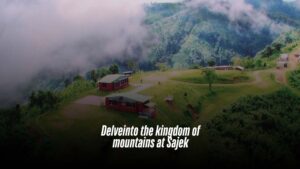
Delveinto the kingdom of mountains at Sajek
It’s unlikely not to hear of the name Sajek Valley whenever some tourist spot suggestions pop up these days among Hodophiles. Which makes it one of the most popular tourist spots located in the verdant hills of the Kasalong range of mountains amidst the serene and exotic beauty of nature. Sajek Valley is often referred to as the “Queen of Hills” and the “Roof of Rangamati,” and it has all the right reasons to be titled so. The valley is characterized by lofty mountains, thick forests, expansive grasslands, and miles of winding roads. The Mayni River and Mayni Range must be crossed in order to reach the Sajek Valley. Located in the Baghaichori Upazila of the Rangamati Hill District, the Sajek River, also called the Kasalong River, is the largest union in Bangladesh and divides Bangladesh from India. Sajek Valley, which was previously the scene of insurgencies and is now surrounded by the hills of Mizoram to the east and Tripura to the north, represents Bangladesh’s cultural diversity and encourages people of all ethnic backgrounds to develop tourism there for socio economic advancement. The tribes of the Lusai, Pangkhoa, and Tripura live in Sajek. Here the locals are mostly from Tripura and lusai tribes. The village of Kalank Para, on the last frontier of the Sajak Valley, is inhabited by the Lusai people. Few Chakma also lives nearby. The simple and basic indigenous lifestyle of local people is just fabulous for visitors to spend a good time here. Sajek is now also willing to assist individuals in their pursuit of benefits, whether it be by assisting them in their tourist endeavors or by involving them in them. This is definitely unusual when considering Bangladesh. Unmissable One of the main draws for visitors to Sajek is Konglak Hill. The Lusai community lives in Konglak, the last village in Sajek Valley. From the Konglak Hills, one can witness the origins of the Karnafuli River, the Lusai Hills of India. There is a two-hour journey through Ruilui Para that leads to the Kamalak fountain. This beautiful fountain is also known to many people as Padaam Toisha Jharna or Sikam Toisha Jharna. Whether it’s day or night, Sajek always appears more like a magnificent piece of art made by an artist. One of the wonderful aspects of Sajek is how nature unfolds here in its best forms. A sleek rainbow can often be noticed coming through the piles of clouds right after a good rain. Tourists especially suggested to not miss the dawn. The white clouds and the sunrise/sunset light create an astounding environment to please both the eyes and soul. To see the sunrise, visiting the Hollypad early in the morning is highly recommended. The afternoon’s colour of the setting sun from a high point is guaranteed to entice you. Post evening, the sky is mostly covered with a blanket of stars. Upon your return from Sajek Valley, you can also take in the sights of Dighinala Banbihar, Hazachara Jhorna, and the Dighinala hanging bridge. There are some local 4 wheels drive cars that are used for transportation called Moon Car or Chander Gari. Usually, the moon car has the capacity to carry 10 to 15 passengers. It is claimed that one must try these cars when they visit here. While traveling through the curving hill route to Sajek, a car is suggested be reserved for a hassle-free journey. This place is also considered ideal for trekking. To have a pleasing time here, staying in resorts is highly recommended, as Sajek offers a variety of high-end resorts that are totally worth a visit. They are designed in such a way that they will ensure an unforgettable trip throughout, along with enjoying the natural essence of the place. And to conclude, the most unmissable thing here is the variety of authentic tribal food, which is impossible to find elsewhere. Most of the cuisines are prepared with rare ethnic ingredients by traditional chefs. When and how to get there Sajek is beautiful in all seasons. With the changing of the seasons, it takes on a stunning new hue. So regardless of the season, one can get a new taste of Sajek. But in the rainy season, autumn, and late autumn, you will feel the white clouds more closely. However, the best part of Sajek is the surprise of the weather it has to offer every day. Hence, it’s never a dull moment here. Although Sajek is located in Rangamati district, the communication system is good through Khagrachari. There is no direct connection from Dhaka to Sajek Valley. However, you can take the train to Feni then take the taxi to Sajek Valley or by bus to Khagrachari from Dhaka and then to Sajek. Other transportation options including bus is also available for a comfortable journey overall. Alternatively, you can take the bus to Chittagong then take the taxi to Sajek Valley. It takes two to three hours to travel from Khagrachhari to Sajek Valley across the road’s high peaks and falls. Hence it can be said without a doubt to experience the place’s actual beauty firsthand rather than merely reading and viewing enough evaluations about it.
Read More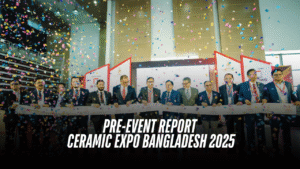
PRE-EVENT REPORT CERAMIC EXPO BANGLADESH 2025
The most awaited Ceramic Expo Bangladesh 2025, 4th edition is going to take place from 27th November to 30th November 2025 at International Convention City Bashundhara (ICCB), at the Expo Zone (Tent Hall), Kuril, Dhaka, Bangladesh. It is going to be one of the grandest celebrations in the world of ceramics unlike the previous 3 successful events on 2017, 2019, 2022 consecutively organized by Bangladesh Ceramic Manufacturers and Exporters Association (BCMEA) and supported by Export Promotion Bureau (EPB) of Bangladesh Government. The arrangements of the exhibition and seminars represent the most aspiring & the biggest events in the ceramics community platform to showcase the local manufacturers and exporters world class products globally and also helps to create long term positive impact on the expansion & growth of the ceramic industry in Bangladesh. Bangladesh is considered as the potential booming market for the ceramic industry in South Asia which makes the Ceramic Expo Bangladesh 2025 exceptionally lucrative opportunity and a leading example for the expansion of the industry. The arrangement of Ceramic Expo Bangladesh 2025 is going to be a 4-day long event with many exciting opportunities to interact with the global community & portraying local offerings in the global platform. The exhibition will enhance the chance to exhibit all the sub sectors of ceramic products such as tableware, tiles, sanitary ware, and ceramic bricks. There will also be some representation of ceramic production machinery, advanced ceramics, raw materials & latest innovation of technologies to upgrade the ceramics world. As the Associate Partner Bangladesh Ceramic Society, Real Estate and Housing Association of Bangladesh (REHAB); International Event Partner Unifair Exhibition Services, ACIMAC, Messe Munchen; Support Partner Tecna, Asean Ceramics, Keramika Indonesia, Ceramics China; Knowledge Partner Nanomaterials and Ceramic Engineering, BUET, Ceramic ISC; Strategic Partner Ant Network, Uniceramics; Official Magazine Partner Ceramic Bangladesh Magazine, Asian Ceramics and Media Partner Ceramic Focus and Ceramic India will be there. It is expected that there will be more than 120+ exhibitors, 25000+ visitors, 500+ delegates, 300+ brands will be participating in the exhibition. The event is going to be one of the largest gatherings for the ceramic professionals, architects, engineers and related industry individuals in South Asia biannually. The expo will cover a 17,000 sqm expo area with enthusiastic participation from 25+ countries such as China, Vietnam, India, Malaysia, Italy, Germany, Thailand etc. along with the local manufacturers of Bangladesh. The valued Principal Sponsor of the Ceramics Expo Bangladesh 2025 is going to be Sheltech Ceramics Ltd., Platinum Sponsor are DBL Ceramics Ltd. Akij Ceramics Ltd. and Meghna Ceramic Ind. Ltd. and the Gold Sponsors are Mir Ceramic Ltd., Abul Khair Ceramic Ind. Ltd., HLT & DLT Technology and Sacmi Imola SPA respectively. There will be arrangements of buyer-supplier meet and scope of one to one business networking. The event will be full of new surprises and exciting activities for all the participants and visitors. There will be arrangement of- Day-long meet-up with the Architects Day-long engagements opportunity with the Dealers, Interior Designers & Fitters Seminar of Five Innovative Topics related to ceramic industry One Exclusive Seminar with prominent Architects Raffle draw each day of the event Job Fair Award and recognition for the sponsors and participants Exclusive Gala Dinner Ceramic Expo Bangladesh 2025 is going to the most promising and progressive event of the ceramics world internationally. It will bring a diverse array of exhibitors, suppliers of the raw materials and machineries, related industries, ceramic industry experts, high officials, government entities to enhance the drive of innovation, collaboration and advancement together under a single platform at a time. The event will also enable the opportunities to explore insightful seminars and conferences to share industry related topics, advancement of the ceramic world and future of ceramics from the industry leaders, resource persons and industry experts. There will be multiple b2b meetings, b2c meetings and business networking opportunities to create more long term business relations through expansion of business collaboration. There will be a job fair, award giving ceremony, exciting gifts for the visitors & exhibitors & so on.
Read More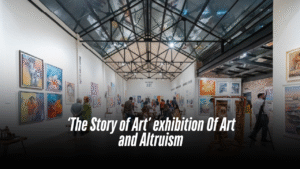
‘The Story of Art’ exhibition Of Art and Altruism
Organized by Dhaka Storytellers from February 8 to February 13, the lush gallery space Aloki Greenhouse in the capital’s Gulshan hosted an exhibition titled The Story of Art. The exhibition boasted a stunning collection of 80 to 90 artworks, captivating audiences for a week. Curated by Syeda Adiba Hussain, co-founder of Dhaka Storytellers, The Story of Art was more than just a display of artistic excellence. This was Dhaka Storytellers’ second art event, following the charity exhibition Art for Charity in August 2024. In the same vein, The Story of Art supported a larger cause, with a portion of the proceeds donated to five schools and one college in Sylhet, demonstrating the power of art to create tangible change beyond gallery walls. Beyond the beauty of its displays, the exhibition underscored the immense power of art to inspire and drive change. By merging artistic excellence with humanitarian efforts, it aimed to uplift communities, empower individuals, and support crucial social causes. Having been in the making for almost a year, the exhibition was carefully planned to bring together some of Bangladesh’s most celebrated artists. The lineup included some of the country’s most notable names, such as Rafiqun Nabi, Monirul Islam, Hamiduzzaman Khan, and Kanak Chanpa Chakma. Furthermore, the exhibition commendably featured artworks by several emerging artists, creating a dynamic collection that bridged generations of artistic expression. From simply beautiful paintings to thought-provoking sculptures, The Story of Art was also an opportunity for both seasoned and budding collectors to acquire unique pieces while contributing to a noble cause. The grand opening on Friday, February 7, set the tone for the week-long exhibition. The launch was attended by an invitation-only audience, including the participating artists, their families, media professionals, and notable guests. As the exhibition drew to a close, it left behind more than just a collection of breathtaking visuals; it also left an indelible impression on those who visited. The fusion of artistic expression with social commitment deeply moved attendees, inspiring them to consider the vast potential of art beyond aesthetics. The exhibition carried a narrative that extended far beyond the gallery walls, reinforcing the idea that art is not merely to be observed but to be experienced, felt, and acted upon. The event was about more than just admiring artworks—it was about creating a shared vision where artists, curators, and spectators all committed to a cause bigger than themselves. It demonstrated that art has the ability to transcend traditional boundaries, reaching into the hearts of individuals and communities, sparking conversations, and inspiring action. Ultimately, The Story of Art was a celebration of creativity’s ability to inspire, connect, and transform lives. The week-long show was a powerful testament to the transformative synergy between art and altruism. It showcased how art exhibitions, when intertwined with a greater purpose, can spark meaningful change. Written by Shahbaz Nahian
Read More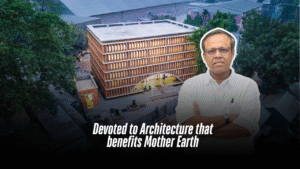
Devoted to Architecture that benefits Mother Earth
Architecture is one of the most profound forms of art that turns into reality, where humans and the environment interact. From the outset of Architect Bayejid Mahbub Khondker’s celebrated career, his design inspiration has consistently driven him to create impactful designs that seamlessly integrate with their surroundings, enhancing natural beauty without causing disruption. Bayejid graduated from the Department of Architecture at the Bangladesh University of Engineering and Technology in 1996. Following his graduation, he spent two years contributing to the private sector before transitioning to the government sector in 2000. Up until 2010, he served as assistant chief architect at the Department of Architecture under the Ministry of Housing and Public Works in Bangladesh. “Like any other art form, architecture thrives on creative freedom. The constraints of a government position limited my ability to fully nurture this creativity. Thus, I chose to take early retirement and established my own firm, Nakshabid,” he explained. In the 14 years since the inception of Nakshabid, Architect Bayejid’s career has taken interesting turns. His portfolio now comprises a diverse range of projects, from residential buildings to factories, hospitals to museums, ports to cities, and even cemeteries to mosques. He has truly designed it all. “In developed countries, architecture is practiced in a quite specialized manner. For example, there are distinct architects for aviation facilities or medical centers. Bangladesh, being a very small country, has a more generalized approach to architecture. As a result, as an architect, we get to design a wide variety of structures. This can be seen as both a blessing and a challenge,” he added. As an architect, Bayejid highly prioritizes sustainable and eco-friendly structures for both urban cities and remote areas. The architect emphasizes that global warming has heightened the importance of environmental sustainability, compelling architects to play a crucial role in reducing global carbon emissions and transforming current design paradigms. “I take pleasure in incorporating local and sustainable materials into my designs. For instance, using glass in the exterior of a building is not always essential. I prefer to avoid it unless necessary, opting instead for locally available materials that can significantly enhance the aesthetics. This approach not only supports sustainability but also values local resources. However, I am not opposed to using imported materials; I incorporate them when the situation demands,” he opined. Believing in the aforementioned notion, Bayejid approached the interior design of Hotel Nandini with a focus on minimalist elegance, utilizing locally seasoned materials like Koroi wood, Gaab, sea grass, and bamboo. A touch of imported steel, weathered locally, adds structural integrity. The exterior design effortlessly blends glass with artisanal wooden craftsmanship, giving the boutique hotel a distinctive and visually captivating appeal. A standout establishment in the surroundings. When asked about his favorite projects to date, Bayejid found it challenging to single out any, as each one holds a special place in his heart and has a unique story to tell. Nonetheless, the architect took a moment to highlight a few of his fondest projects, including the Nurpur Graveyard in Rangpur, Karupanya Factory in Rangpur, Aman Mosque in Narayanganj, and Hotel Nandini. “Nurpur Graveyard transcends the conventional boundaries of typical graveyards in our context. This Muslim cemetery includes a compound that houses a primary healthcare facility and a madrasa. The entire premise is funded by nearby local communities,” he added. The graveyard is designed to create spaces for leisure, an uncommon feature in our region. The overarching design philosophy was to create an open, inviting space that encourages local community members to visit and find solace where their loved ones rest in peace. The key concept of the project is to establish a synergy between the graveyard and community amenities. On the other hand, his iconic design, the Karupanya Factory in Rangpur, has set a new benchmark of sustainable architecture. From a distance, with the lush greenery covering all over the front of the factory, it appears like a forest. The factory is designed as an energy-efficient and climate-responsive structure that can save up to 40% on energy consumption. Energy efficiency, water efficiency, optimal use of daylight, plantation, and ecosystem preservation are its sustainable design elements. “Traditionally, industrial spaces are viewed as environments dedicated solely to relentless work. However, this factory was conceived with a different vision. The entire compound, including the workplace, is thoughtfully designed to evoke a sense of homeliness for the workers,” said Bayejid. The Karupannya factory project earned acclaim in the open category of the ‘UIA 2030 Award’ by the International Union of Architects (UIA) and UN-HABITAT. Architect Bayejid Mahbub Khondker received two gold medals in the Industrial Building category and a special award for Socially Responsible Architecture and Sustainability at the ARCASIA Awards for Architecture-2023 for the same project. We asked Architect Bayejid if he has any particular style in his work, just like many profound architects have a signature style that speaks for itself. The architect did not take seconds to answer in the negative and explained his stance. “I do not adhere to any signature style, nor do I aspire to have one in the future. Firstly, I believe that adopting a particular style limits our creativity. Secondly, the previous generation of architects had the luxury of focusing primarily on aesthetics and signature style. However, times have changed, and our natural environment is now in crisis. Our duty is to preach architecture that does not disrupt nature but rather fits in,” he concluded.
Read More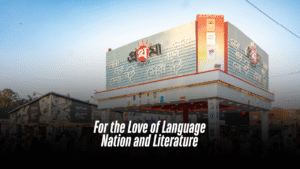
For the Love of Language Nation and Literature
With a new sun, new authorities emerge, revitalising familiar spaces. The 40th Ekushey Book Fair 2025, themed “July Mass Uprising: Building a New Bangladesh (New Bangladesh Deconstruction),” featured over 700 publishing houses at the premises of Bangla Academy and Suhrawardy Udyan. The month-long fair was inaugurated by Dr. Muhammad Yunus, the Chief Adviser of the interim government on 01 February. The Amar Ekushey Book Fair, a fundamental element of Bangladesh’s literary heritage, returned this year with a striking and visually captivating transformation. Uniquely crafted stalls add an architectural charm that sets this year’s fair apart from the previous editions. Visitors are greeted with the richness of literature and an impressive array of architecturally designed stalls, each presenting a unique identity. The influence of the new government is evident in the fair’s structured setup, where each stall showcases unique aesthetics through bold shapes, intricate exteriors, and thematic designs. When visiting this year’s Ekushey Book Fair, the crowd was astounding. People of all ages turned the fair into a true celebration. The entrance was bustling with various food vans, and women and children were all dressed up. The Book Fair has never been this festive and crowded in recent years, even on working days. Whether for recreation or out of love for books, the fair should continue in this spirit for eternity, celebrating Bangla language and literature. Readers and visitors took a moment to admire the aesthetics embraced by publishers who dedicated extra time and thought to beautifully decorate their pavilions. One of the highlights of this year’s book fair is the pavilion by Iti Prokashon, titled ‘Ziar Bari’ (Zia’s House), named after Ziaur Rahman, a prominent army chief, freedom fighter and politician who served as the sixth President of Bangladesh from 1977 to 1981. A key figure in the country’s War of Independence, Zia’s name has often been sidelined in public discourse and textbooks due to the agendas of the previous autocratic regime. In contrast, Onnodhara Prokashon transformed its pavilion into a representation of the Bangladesh Parliament House. The sight of these two distinct symbols coexisting on the same ground truly captivated visitors. Afsar Brothers gave their pavilion a harmonious blend of heritage and functionality, making it an inviting space for book lovers while paying homage to Bengal’s rich architectural traditions. The structure follows a half-timbered design with exposed wooden beams and white infill panels, resembling classic Bengali rural or zamindari house styles. Other notable mentions include Bishwa Shahitto Kendro, which transformed its pavilion into a two-story BRTC bus structure, paying homage to its Moving Library. Bhashachitro Publications adopted a minimal, monochrome palette, giving the pavilion a simple yet elegant look. Bengal Books chose a wooden pavilion, creating a soothing atmosphere for buyers with its well-decorated books and thoughtful lighting. The Puthiniloy stall featured a book-structured roof, while Gronthik designed its stall to resemble a mud house with bamboo. Shaishab Prakash’s stall is shaped like a whimsical castle, inviting readers into a world of children’s literature. These creative designs add a unique visual and conceptual dimension to the fair, making it not just a place for purchasing books but also for cultural and artistic appreciation. The best pavilion design goes to Batighar, designed by artist Shahinur Rahman. The triangular front featured a stained-glass-like panel with motifs from Nakshi Kantha and Patachitra, reflecting Bengali folk art. Inside, a red dome element, inspired by a Chhoto Sona Mosque, highlighted local heritage. The steeply pitched roof with exposed red clay tiles resembled traditional Bangladeshi huts. For its artistic excellence, Batighar won the Kayum Chowdhury Memorial Award for best pavilion in this year. Sadly, the kids’ section lacked vibrancy, with limited space for children to explore and freely roam around. However, a few stalls, including Shoishob Prokash, Mayurpankhi, and EKRI MIKRI, did a decent job of capturing the attention of young visitors. Shoishob Prokash transformed its stall into a castle-like structure, Mayurpankhi adhered to its palette with subtle adjustments, and EKRI MIKRI added a creative touch by placing a horse for children to play on, making the stall an engaging and fun experience for the little ones. This year, the fair included 66 more stalls than the previous year. 99 publishers were located at the Bangla Academy premises and 609 at the Suhrawardy Udyan area. There were 37 pavilions in total, with one at the Bangla Academy premises and 36 at Suhrawardy Udyan. The Little Magazine Corner had been set up in Suhrawardy Udyan, with 130 stalls. In the children’s corner, 74 institutions had been allocated. The fair also featured daily seminars and cultural programmes in the evening, and a special “Children’s Hour” held every Friday and Saturday from 11am to 1pm. As part of the Amar Ekushey celebrations, various children’s competitions, including art, recitation, and music, were organised. The fair had four entrance points: TSC, Doyel Chattar, MRT station, and Engineering Institute. Director General of Bangla Academy Mohammad Azam and Member Secretary of the Fair Management Committee Sarkar Amin said to Ceramic Bangladesh that the fair was entirely polythene and smoking-free, with security provided by the Police, RAB, Ansar, and various intelligence personnel. All participating institutions sold books on a 25% commission basis. The academy published 43 new books and reprinted 41 books for this fair. A total of 3,300 new titles were published in this Book Fair 2025 and Bangla Academy stall alone sold books worth Tk 61 lakh. Several awards were presented at the fair, including the Chittaranjan Saha Memorial Award for the best publisher, the Munir Chowdhury Memorial Award for artistic excellence, and the Rokanuzzaman Khan Dadabhai Memorial Award for children’s literature. These awards recognise the contributions of publishers and authors to the literary and cultural landscape of Bangladesh. Written By Fariha Hossain
Read More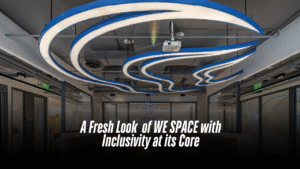
A Fresh Look of WE SPACE with Inclusivity at its Core
In the bustling Gulshan North Avenue of Dhaka, a unique office concept in Bangladesh replaces traditional departmental segregation and hierarchy with freedom of workspace and teamwork. Located in a prime location of Dhaka’s business hub, WE SPACE is Woolworth’s Group’s Bangladesh office, co mprising an area of 6,300 square feet. The entire project was completed in 90 days, which was a challenge in itself. The spaces in this project have been designed with Woolworth’s inclusive concept of “WE” and togetherness in mind. This concept is reflected in the layout, flexible workspaces for users, and an interesting colour palette that complements the brand identity. As per the question, Sudeshna Shireen Chowdhury, the founder and principal architect of Studio.O, explained, “All functions are arranged together in a loop. If you enter the office from one side, you can come back and end up in the same space.” Inspired by the concept of “We Space,” the layout has been developed with a central collaborative social hub and town hall space as the heart of the office. Upon entering, a clean, central circulation spine welcomes the user into the space. This loop leads them towards designated zones, which are specifically marked to enable easy navigation. The design ensures universal access for both circulation and entry into all spaces, promoting proper orientation and mobility. Overall, the office space has been designed to be exceptionally user-friendly, showcasing unique details and features while upholding the brand identity of Woolworth’s Group. Architect Sudeshna explains that there are no designated seats or fixed workstations. The concept is for all functions to be connected in a loop, allowing users to enter from one side and return to the same space upon exiting the loop. The design team did not introduce a traditional reception area, as the other Woolworth’s offices do not have one either. The zoning prioritises common areas, meeting rooms, and a multifunctional room near the entrance for guests. The kitchen, designed more like a coffee pantry, is also placed near the entrance for easy access by guests. Public spaces are readily accessible upon entering the office. “As you move further inside, you’ll find the workspaces located near the terrace space,” as explained by Architect Sudeshna. All the furniture for this project has been locally sourced and designed, making it exclusive to the users and the office. Hatil provides modern, space-saving compactor storage that allows for a significant amount of storage within smaller areas. Height-adjustable tables and workstations were made locally using handmade techniques. The vibrant colour palette within the workstations incorporates orange and green shades. A unique feature is the collaborative table they designed. It can function as a whole table for four people or unfold into individual workspaces. One of the most striking features of the space is the ceiling. The Woolworth’s logo is cleverly incorporated as a ceiling light fixture, adding a unique and memorable touch to the ambiance. The clients loved this detail and are considering replicating it in our other branches to create a consistent and memorable brand experience. Vinyl flooring is used throughout the space, with a colour scheme that complements the blue ceiling light to further highlight the blue colour in the ceiling and the brand association as well. No partitions were used in open spaces; the variation in the texture of the floor materials separates the zones. Biophilic principles were considered throughout the design process. Planters were strategically placed to integrate nature into the workspace. The architect adds, “We always consider biophilic principles. So, we planned where the planters would go and designed accordingly.” The meeting room features a TV panel that doubles as a whiteboard, demonstrating a smart design element. Acoustics were also a priority. To minimise echo, a false ceiling with sound-absorbing panels was installed. Carpets were also used for the same purpose. In the main workspaces with exposed ceilings where talks and town hall meetings are held, sound-absorbing carpet flooring was used. Another unique addition to the project was the soundproof office pods for four people. “These pods are fully furnished, offer 85% sound absorption, and have their own ventilation systems,” explains Architect Sudeshna. She further adds, “Every space has its own identity. There is a focus zone, a collaborative zone, and a social zone, all with different kinds of identities and characters.” Completed in January 2023, WE SPACE is a collaborative project by the eminent architecture firms Studio.O and Binyash, located in Dhaka. The team of architects brainstormed together to come up with a concept that ensures efficiency, comfort, and a positive ambiance for office users. Architect Sudeshna Shireen Chowdhury concludes, “Working with the Woolworths team was an exceptional experience. We appreciate the unparalleled support from our partners.”
Read More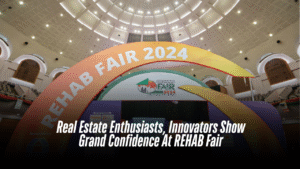
Real Estate Enthusiasts, Innovators Show Grand Confidence At REHAB Fair, Businesses Eye Mammoth Growth in the Ceramic Industry
The Real Estate and Housing Association of Bangladesh (REHAB) organised a five-day REHAB Fair-2024 at Bangabandhu International Conference Centre (BICC) in Dhaka, to bring together all stakeholders related to the real estate sector, including land developers, house builders, buyers, financial institutions, building materials companies, and ceramic companies. The fair concluded on December 27 with an overwhelming response from visitors and prospective buyers. It witnessed significant engagement with real estate enthusiasts and industry stakeholders. RAJUK Chairman Siddiqur Rahman Sarker inaugurated the fair on December 23. The event attracted about 18,000 visitors and buyers, showcasing its popularity among Dhaka residents and highlighting the strong interest in the real estate sector. REHAB leaders expressed satisfaction, stating that the event successfully met its objectives of promoting the housing sector and engaging the public. According to REHAB data, the fair saw flats, plots, and commercial spaces worth Tk 403 crore being sold and booked. Of the total amount, flats accounted for Tk 230 crore, plots Tk 96 crore, and commercial spaces Tk 77 crore. Additionally, bank loan commitments worth approximately Tk 1,090 crore were received for new projects. Sheltech’s Deputy General Manager (Sales) AKM Rafiul Islam highlighted the importance of the fair in showcasing their 50 new projects to customers. He emphasised that such fairs provide an opportunity to communicate with both new and existing clients. “Many clients come here and purchase their desired products after comparing with other companies. We received good customers at the fair,” he observed. Similarly, Mir Real Estate Ltd’s Head of Marketing and Sales, Md Abu Zahid, noted that the fair allowed them to introduce seven new projects to customers. He pointed out the challenges faced by the real estate sector due to the increased cost of doing business and the rising prices of construction materials. Mr Zahid called for government policy support to help the sector thrive. Ceramics : A New Phenomena in Real Estate The ceramic sector is a new phenomenon in real estate. The fair highlighted the growing importance of ceramics in the real estate sector. REHAB President Md Wahiduzzaman stated that the organisation has been arranging the fair for the past 26 years with the goal of bringing all stakeholders, including realtors, developers, buyers, financial institutions, building materials companies, and ceramic companies, under one platform for the industry’s development. He explained that ceramics play a crucial role in the finishing segment of construction, accounting for 60 per cent of a building’s finishing part. Because a building has two segments: 40 per cent construction and 60 per cent finishing. Ceramic is part of the finishing segment. Thus, the prices of apartments depend on the finishing aspect. The fair provided an excellent opportunity for ceramic companies to showcase their products and for buyers to choose their desired items. “I use ceramic tiles in my projects, and thanks to the tile companies, we can finish building works smoothly,” Mr Wahiduzzaman mentioned. In response to a query, he mentioned that realtors seek quality products with good finishing and well-burnt tiles. “I prefer homogeneous tiles, but I have to change them due to client demands,” he said. Buyers looking to purchase plots and apartments can choose their desired properties by visiting different companies’ stalls at the fair. They can also examine products’ quality and legal issues. REHAB assists buyers, as only REHAB members can participate in the fair. Mr Wahiduzzaman also addressed the challenges faced by the real estate sector, including high registration costs, VAT, and taxes, as well as reduced ADP project implementation in the real estate sector due to the economic slowdown. He expressed optimism about the industry’s recovery by 2025 with proper government policy support. “We are working to fulfill the dreams of the citizens,” he stated. However, in the post-Covid-19 period, the business has faced a sluggish situation. Such fairs help grow business and trade. The demand for both tiles and sanitaryware is increasing significantly in the country. “But gas is crucial to ensure quality ceramic products. I planned to manufacture ceramic items but reconsidered due to the gas supply crisis,” he explained Hints at Ceramic Industry’s Growth The Chairman of the REHAB Fair-2024 Committee, Mohammad Akter Biswas said that more than 200 related industries, including rod, cement, tiles, and electrical equipment, and approximately three crore people are directly and indirectly linked to the sector, which accounts for 12%-15% of the GDP. “Various construction materials such as tiles and financial institutions participated in the expo. Buyers have the opportunity to choose their apartments after discussing with many companies at the fair,” he added. The growth of the ceramic industry was also highlighted, as several tiles and sanitary companies have started manufacturing high-quality ceramic products that meet international standards and are exported to different countries. Earlier, imported products were commonly used, but now the ceramic industry has become significant in Bangladesh. He underscored the importance of the REHAB Fair in bringing all buyers and sellers under one umbrella, allowing them to explore various construction materials and financial solutions. The REHAB Fair-2024 was a resounding success, bringing together a diverse range of stakeholders and facilitating significant transactions and commitments. The event highlighted the growing importance of innovation and sustainability in the real estate sector, with a particular focus on the role of ceramics. As the industry continues to evolve, the REHAB Fair remains a crucial platform for promoting growth, fostering collaboration, and addressing the challenges and opportunities faced by the sector. Written by Rafikul Islam
Read More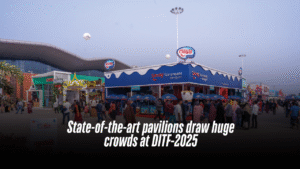
State-of-the-art pavilions draw huge crowds at DITF-2025
With a view to attracting local and foreign visitors, the exhibitors of the month-long 29th Dhaka International Trade Fair (DITF)-2025 brought innovative architectural view at their pavilions and stalls made of various materials such as steel, board, wood, bamboo, electric cables, lights, colour and ceramic items. Chief Adviser to the Interim Government Prof Dr Muhammad Yunus inaugurated the fair at the Bangladesh-China Friendship Exhibition Centre in Purbachal, Narayanganj on 1 January, 2025. Commerce Adviser Sk Bashir Uddin and Export Promotion Bureau (EPB) Vice-Chairman Md Anwar Hossain also attended the opening ceremony. This year, 343 domestic and foreign companies took part in the fair, including 11 companies from India, Pakistan, Turkey, Singapore, Indonesia, Hong Kong and Malaysia in addition to Bangladesh. Last year, 304 companies participated in the fair, including 9 foreign companies from 5 countries. The companies set up premium pavilions, mini pavilions, and reserved pavilions at the fair venue to display various products including textiles, furniture, electrical and electronics, jute and jute products, leather products, machineries, cosmetics, home furnishings, toys, stationery, crockery, plastics, melamine, herbal and toiletries, imitation jewellery, processed food, fast food, and handicrafts. Of them, many exhibitors also offered discounts ranging from 5 to 50 per cent as well there to attract more buyers. The Ministry of Commerce and EPB have organised DITF since 1995 to promote export growth and market diversification. This is the third edition at its new venue in Purbachal, following the relocation from Sher-e-Bangla Nagar in 2022. Pavilions and stalls were awarded due to innovative architectural view The best pavilions, stalls and organizations participating in various categories were recognized by presenting crests at the closing ceremony of the fair. The first prize was awarded to 22 best companies in different categories (Kiam Metal Industries Limited, Akij Plastics Limited, RFL Plastics Limited, Prisons Department, Pran Agro Limited, M/s. Helal & Brothers, Sena Kalyan Sangstha, JDPC, BGMEA, BKMEA, Hatil Complex Ltd., Jamuna Electronics & Automobiles Ltd., Navana Furniture Limited, Vision Electronics, SME Foundation, BSCIC, Orijinal Istanbul Kristal, Turkey, Pentel (Singapore) PTE Ltd., Singapore, Kewpie Malaysia SDN, BHD, Malaysia, Sonali Bank PLC, Islami Bank Bangladesh PLC and People’s Leather Industries. The second prize was awarded to 16 companies in different categories (Savoy Ice Cream Factory Ltd., Square Food & Beverage Ltd., KY Two Tone Ltd., Alloy Aluminum Furniture Limited, Exclusive Home Tex Industries Limited, Bangladesh Machine Tools Factory Limited, Bangladesh Tea Board, Nadia Furniture Limited, Minister Hi-Tech Park Limited, Brothers Furniture, Hatim Steel Structure Limited, JMG International, Hadeks Hali DeriTekstil Dis Tic A.S., Turkey, PT Nissin Foods, Indonesia, Rabab Trading International, Hong Kong and Dutch Bangla Bank PLC. The third prize was awarded to 13 companies in different categories (Delhi Aluminium Factory, Abul Khair Milk Products Limited, SKB Stainless Steel Mills Limited, Abdul Monem Limited, BRB Cable Industries Limited, Leathergoods and Footwear Manufacturers and Exporters Association of Bangladesh, Rangpur Metal Industries-Regal Furniture, Walton Hi-Tech Industries PLC, Joyita Foundation, Messrs. Nurul Textile, M/S Tarique Carpet Industries, Indian Carpet Industries, and Indian Oriental Carpet, India). Touhiduzzaman, Deputy General Manager [Public Relations] PRAN-RFL Group said, “We have a lot of products like food stuffs, plastics items, furniture, and electronics. We display the products for customers at the exhibition every year. We receive the best pavilion awarded each year due to innovative architectural view.’ He pointed out that they always try to build their pavilion at the fair venue with excellent architectural views in new shapes to draw large crowds. “As there is a limited space and it is a temporary place, so we build our stalls considering it. After getting tender from the EPB, we talk to different firms of interior designers and architects. Basically they set up the pavilion as per our direction,” he added. Touhiduzzaman stated that the stalls are set up by different construction materials like wood board, steels, tiles, bricks and others. He remarked that their main goal is to attract more customers. We decorate our stalls focusing our products. We will try to make the best pavilions in coming days as well,” he also commented. Mahin Sarker, Pavilion In-Charge of Square Food & Beverage, noted that their stall has been a hotspot for visitors due to excellent architectural views. Our pavilion got the second best pavilion award this year. “We offered up to a 50% discount on our food and beverage items, so a lot of people purchased our products. Additionally, as our company set up an attractive pavilion so visitors drew largely here,” he added. Another a-three day fair only for exportable items in October/November Talking to the Ceramic Bangladesh, CEO and Vice-Chairman of the EPB Md. Anwar Hossain said they tried to bring excellent architectural view in the DITF-2025. At the first time, we introduced innovative features and enhance the fair’s experience for visitors, particularly after the historic student-led revolution on 5 August, 2024. “We introduced new attractions like the 36-July Chattar and Mugdha-Sayyed Corner to showcase the revolution’s impact. Additionally, visitors enter the fair with e-tickets, eliminating the hassle of manual ticket collection.” Hossain emphasised the fair’s role in supporting local businesses and diversifying products to boost foreign currency earnings. “We invited many ceramic companies but they did not give positive response in the fair. We hope that in the next year fair, we can attract many ceramic companies in the expo as it is the potential and exportable products. “We try to organize another a-three day expo at the first time at Purbachal venue in October or November where only exportable products will be displayed. It will help to attract more foreigners. We have no actual data on foreign visitors that how many foreign visitors visited the DITF-2025 and export orders too but many foreign visitors came here,” he highlighted.
Read More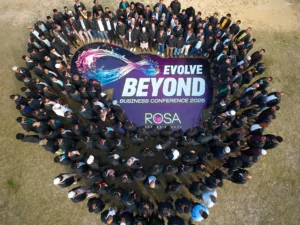
AkijBashir Group hosts ROSA Bathware’s Business conference of 2025
AkijBashir Group recently concluded a grand day long ROSA bathware’s business conference of 2025, Evolve Beyond, at the CCULB Resort, Purbachal. The event brought together over 300+ business associates from the Group’s premium bathware brand Rosa. The conference served as a platform to align strategies and set ambitious goals for the upcoming year, while also celebrating the company’s remarkable achievements. Managing Director of AkijBashir Group Mr. Taslim Md. Khan, Chief Operating Officer Mr. Mohammod Khourshed Alam with all sales and marketing officials participated in the event. The conference featured strategic discussions, an award ceremony, and a vibrant cultural gala night, fostering collaboration and inspiration among all attendees. This remarkable event reflects AkijBashir Group's commitment to innovation, growth, and excellence in business.
Read More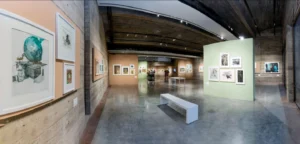
Brishtite Roder Kona’ reminisces Kazi Abdul Baset
The ongoing exhibition titled ‘Brishtite Roder Kona’ at Bengal Shilpalay lets new audiences be introduced to the works of one of the finest artists from Bangladesh, Kazi Abdul Baset. In an age when electricity has reached even the most remote corners of Bangladesh and air conditioning is ubiquitous, the image of a woman cooling herself with a traditional handheld fan may appear to be a relic of the past. However, this simple act of seeking relief from the heat was immortalised in the works of Baset. While his works are rarely exhibited these days, the exhibition at Bengal Gallery in Dhanmondi has provided a unique opportunity to view a comprehensive collection of his work. The exhibition features 72 pieces in a variety of mediums, including acrylic, pastel, charcoal, watercolour, and ink drawings. The artworks are all from private collections and have been generously shared to introduce Baset’s genius to a new generation. Kazi Abdul Baset’s legacy is enormous but unappreciated. Baset, a humble and introverted guy, was recognised for his plain pyjama and grey panjabi outfit, as well as his rigorous guidance of his students. He received a Fulbright scholarship and studied in Chicago from 1963 to 1964. Baset’s work has a unique blend of figurative and abstract styles. Despite his modernist approach, Baset’s themes frequently revolved around the simplicity and beauty of rural life, capturing its essence with profound depth. His depictions of rural women and domestic life added a new dimension to modern Bangladeshi art, specially his paintings of woman with a fan becoming almost a trademark of his artistic identity. Baset had a close relationship with fellow artist Mohammad Kibria, another shining light in Bangladesh’s art history, and analogies between their works were frequently made. Their mutual influence and inspiration resulted in considerable artistic synergy, which shaped Bangladesh’s art scene in the 1960’s. Baset began his career as an art teacher at Nawabpur High School, where other notable figures such as Mohammad Kibria and Murtaza Bashir taught. Baset’s artistic development—from his early realistic images of rural life to his later experimentation with abstraction and return to realism—reflects a dynamic and diversified artistic journey. This show at Bengal Gallery is a fitting tribute to the brilliance of Kazi Abdul Baset, providing spectators with a unique opportunity to immerse themselves in the works of a master who caught the soul of Bangladesh with unsurpassed sensitivity. Presented by Bengal Arts Programme, the exhibition walls adorns the works of Baset which he produced between the 1960’s and 1990’s. All the works being showcased are collected from the personal collections of Abul Khair, Abul Hasnat-Nasimun Ara Haque, Matiur Rahman and Luva Nahid Choudhury. Open for all, the exhibition commenced on 8 November 2024 and will run till 11 January 2025. Written by Shahbaz Nahian
Read More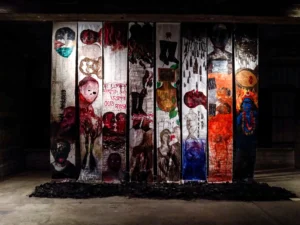
Body and the Map: Of wounds and Hope
Beautifully curated by Sharmillie Rahman, the exhibition “Body and the Map” took place on Bengal Shilpalay between 15 and 28 December, 2024. By engaging viewers to contemplate the interaction of power, identity, and transition, “Body and the Map” was more than just another decent exhibition that had the July-August uprising as its subject matter; the exhibition not only acted as a stark reminder about what must not be forgotten but also intrigued the audiences to introspect. Consisting of the artworks of ten multidisciplinary artists, many of whom were active participants in the mass uprising that overthrew a long-standing regime, “Body and the Map” was a riveting look at societal upheaval in the aftermath of that student-led mass rebellion. The show, based on the collective memory of Bangladesh’s last July-August, is both a reflection and a debate about the force of resistance, the weight of trauma, and the possibility of change. Their work delves into the complicated reality of a country dealing with its old and fresh scars and the tiers of collective psychological state of the mass after the newfound independence. The participating artists were A. Asan, Afsana Sharmin, Ashang Mong, Farzana Ahmed, Mong Mong Shay, Niazuddin Ahmmed, Palash Bhattacharjee, Rasel Rana, Razib Datta, and Ripon Saha. The July-August uprising was characterised by an unprecedented feeling of urgency, as residents defied persecution to demand justice, equality, and dignity. However, the road to liberation came at a high cost, with bodies mutilated, lives lost, and a collective psyche permanently transformed. The show explores this dichotomy, emphasising the body as both a personal and societal vessel for history, pain, and resilience. The artworks that were adorned by the gallery space delve deeply into the concept of the body as a source of memory and resistance. Whether through physical depictions or abstract interpretations, the ten artists highlighted how the human body bears the weight of institutional injustice and governmental violence. The visual narratives starkly remind us about biopolitical disposability, demonstrating how individuals became victims of normalised violence during the authoritarian system. The relationship between body and land appears as a repeating pattern, emphasising identities defined by culture, religion, race, and gender, all of which intersect within a nation’s sovereign borders. However, these links are loaded with tension, since the scars of authoritarian authority and systematic impunity are etched on both the body and map. In the aftermath of this historic movement, “Body and the Map” illustrated the dialectics of trauma and renewal, hopelessness and optimism. The exhibition stressed the importance of open discourse and the reframing of identity and government as centralised power disintegrates and something new emerges. Despite recollections of terror, violence, and loss, the artworks elicit a cautious hope. The collective body politic, though scarred, remains resilient, signalling a determination to redefine itself and the map it inhabits. Written by Shahbaz Nahian
Read More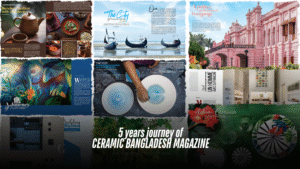
5 years journey of CERAMIC BANGLADESH MAGAZINE
Walking through the memory lane, the 5-year journey of Ceramic Bangladesh Magazine seems like a dream of yesterday. During the planning of the Ceramic Expo Bangladesh 2019, the magazine began its journey by providing complimentary copies to exhibitors to educate them about the ceramic industry in Bangladesh. Along with the success of the Ceramic Expo Bangladesh 2019, everyone particularly praised the magazine, which encouraged us to come up with the next issue in 2021. Chief Editor Mr. Irfan Uddin was recollecting the memories in this way while sharing his experience of working closely with the magazine. Initially, the magazine focused on Bangladesh’s ceramic industry, its overall future, prospects, growth, etc., to bring limelight to the overall sector. Due to Covid-19, it was impossible to continue the publication in 2020. But after that, Ceramic Bangladesh was publishing full-fledged from 2021 at the end of the year. Since then, the magazine has completed its 13th issue and plans to publish bimonthly from 2025. The journey was a rollercoaster for all the team members, along with the editor, sub-editor, coordinator, designer, photographer, and writers. Everyone took a leap of faith to explore a new publication arena with their enthusiasm, interest, and love for taking challenges. The editor of the magazine, Salahuddin A. Talukder, expressed his immense affection for Ceramic Bangladesh Magazine. It was a challenge to sustain the magazine and keep up the top-notch quality so that it would be liked and praised by all. The projects we have focused on were unique and interesting, and each one has a new way of unfolding the journey of development and growth in Bangladesh. While interviewing the subeditor, Rehnuma Tasnim Sheefa, it was really interesting to know how they came up with the names of the segments and selected projects to feature initially. Reminiscing on the initial projects and works, she mentioned that at the beginning, most of the write-ups were done by the editor, Salahuddin Ahmaad Talukder, and himself, along with 2 to 3 writers. Photographer Junaid Hasan Pranto and designer Ali Haider created magic with their photography and layout to make those features alive by narrating a story visually for the readers. The 1st issue of the magazine was prepared by Ant Network, which encouraged BCMEA board members to approve the work of the publication and enable BCMEA to work on the magazine internally. With the publication of the 2nd issue, considering the contribution of the architects and their close involvement with the ceramic industry in their projects, the magazine started to focus on architects and their significant works, various mega projects, interior and exterior insights, industry-related content, and some exclusive and unique projects related to the use of tableware, tiles, ceramic bricks, sanitaryware, etc. Through the magazine, readers learned that Bangladesh is the only country where the maximum number of national establishments are made with red ceramic bricks, a matter of pride for the ceramic industry. There were also some interesting coverages of the projects from a wide range of collections under different segments. For example, for the segment Architectural Regime, Alenbari Mosque of PWD was featured, which is a geometric-shaped prayer space with a dramatic skylight that represents the combination of art and architecture in every part of the project. The feature on Monno Ceramic for Ceramic Central reminds the reader about the legacy of ceramic tableware in Bangladesh, which has created a corner in every showcase of each household and the heart of Bengali mothers. Under Suasive senses, unique ideas like Ajo Idea Space use their own crockery sets to serve their food sustainably and reduce the wastage of food. Some of the exclusive features of the brilliant minds of the country were presented through the magazine. Architect Rafiq Azam recalled his childhood memories and newfound inspiration for sustainable architecture practices from his surroundings, exploring new arenas of work that are inspirations to many young architects. The creator of the new city skyline Architect Mustapha Khalid Palash unfolds the dream of making the city more sustainable and living worthy for the city dwellers. The Mason Master Architect Mohammad Foyez Ullah’s projects represent the combination of modern architecture by designing sleek concrete buildings and making them stand out to praise the beauty of the creation. Apart from them, Architect Mamnoon Murshed Chowdhury, Architect Mahmudul Anwar Riyaad, Architect Tanya Karim, Architect Nurur Rahman Khan, Architect Masudur Rahman Khan, and Architect Salauddin Ahmed’s contributions and journeys of their personal and professional lives are worthy to explore through the magazine. They have shared their life journey, learning, and their experiences under the architectural regime segment. It was a documentation of the living legends and the inspiration behind their creations through the magazine for future generations, added by Sheefa. In the segment Interior Insight, we featured different well-designed restaurants and offices. Some features were also on entrepreneurial stories to encourage new people to start their journeys in similar industries. Exclusive mega projects like MetroRail, Padma Bridge, Kamlapur Railway Station, etc. were also highlighted in the cover stories of our magazine. In the Heritage segment, sites like Lalbagh Kella, Tara Mosque, Shat Gambuj Mosque, Terracotta Temple, etc. were also covered. In parallel, we also focused on scenic sights, covering touristy destinations. From financial institutes to real estate, we have tried our best to cover the wide band. Ceramic Bangladesh Magazine has grown with some excellent team members. Without their dedication and utmost effort, it would not be possible to come such a long way. The former core team members of BCMEA, Mahfuza Tasnim Noshin, Kazi Sumaiya Ahmed, and Anamika Rahman, shared their journey with the magazine as they have closely worked with the CBM since its initiation. They shared their utmost affection and recalled their journey while working on such an interesting project from scratch. To sum up the journey of Ceramic Bangladesh Magazine, the dedication, effort, and consistency of all the team members is remarkable. Without their continuous
Read More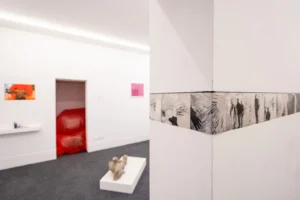
Liminal Horizon: Body, existence & Introspection
“Liminal Horizon,” the solo exhibition of artist Sanad Biswas that took place between 14 and 7 January at the capital’s Kala Kendra, is one of the most fascinating sculpture exhibitions in recent memory of post-pandemic Dhaka’s vibrantly growing exhibition scene. From quirky humanoid figures and brightly coloured and inflated ballooning bodies to disembodied internal organs, Sanad’s sculptures have an aura of eerie sensuality mixed with humour. They appear visually strange to our eyes, but the feelings we perceive are bizarrely familiar to our soul, and they intrigue questions about our fragility and existence as human beings, living and surviving amongst the complexities of the modern world. Although primarily a sculpture exhibition, it consisted of relevant paintings, drawings, installations, and photographs of performance art by the artist as well. This exhibition is also like a diary of Sanad’s almost two decades of art practice. “The world that we live in right now has its tiers of complications. And as human beings, our immediate surroundings and even global circumstances in this era of a world connected through the devices in our hands always have an effect on us, both mentally and physically. The artworks that are shown in this exhibition are artistic manifestations of my psychological journey, how I reacted to certain contexts. For example, the characters in my works are sometimes satirical, sometimes dramatic and colourful, and sometimes they suffer from existential crises!” said artist Sanad Biswas. Another highlight of this exhibition is the beautifully done curation. Curating a show inside a space like Kala Kendra is always challenging, as it is basically a ground-floor part of a residence and not originally designed to be a gallery. But artist Sanjid Mahmud gracefully accomplished the difficult task of dealing with such a space and devised a neatly designed exhibition. “This exhibition was not pre-planned. Sanad had been devotedly working for a long time now; hence, naturally, he has an assemblage of amazing artworks that has a certain coherence that subtly reverberates that they are Sanad’s works. Later, we decided to organise this exhibition. And as a curator, designing a sculpture show inside a space like Kala Kendra was also a challenging task,” said artist Sanjid Mahmud, who is the curator of the exhibition. “Compared to the existing types of sculpting practice that we see in our local art scene, Sanad’s works are starkly different. His works are compelling even in the standard of global contemporary art,” Sanjid further added. With their few other artist friends, Sanad Biswas and Sanjid Mahmud runs their art collective Daagi Art Garage. Although not a familiar name outside our local art scene, this Dhaka-based young art collective, is one of the finest in their genre in Bangladesh. Daagi’s own space, Studio Bhashkarmi, is in the capital’s Hazaribagh area. Written by Shahbaz Nahian
Read More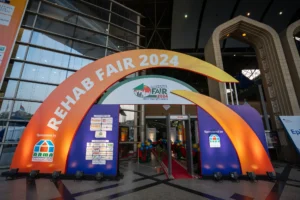
REHAB Fair 2024 Concludes with Overwhelming Turnout and Promising Prospects
The five-day REHAB Fair 2024, organized by the Real Estate & Housing Association of Bangladesh (REHAB), concluded on December 27 at the Bangabandhu International Conference Centre (BICC) with remarkable success. Drawing 17,729 visitors, the event showcased the growing potential of the real estate sector, featuring stakeholders such as land developers, builders, financial institutions, and ceramic companies. RAJUK Chairman Siddiqur Rahman Sarkar inaugurated the fair on December 23. REHAB reported sales and bookings worth Tk 403.13 crore, comprising flats (Tk 230 crore), plots (Tk 96 crore), and commercial spaces (Tk 77.12 crore). Additionally, banks committed approximately Tk 1,090 crore in loans. Prominent real estate companies like Sheltech and Mir Real Estate used the platform to showcase new projects and connect with clients. “The fair helps us engage with old and new customers while facilitating direct comparisons across companies,” noted Sheltech’s Deputy GM, AKM Rafiul Islam. The fair also highlighted the ceramic industry’s growing influence in real estate. REHAB President Md. Wahiduzzaman emphasized that ceramics now constitute a significant part of a building’s finishing phase, accounting for 60% of total construction. Ceramic companies had a strong presence, showcasing high-quality tiles and tableware, which are increasingly in demand. The fair committee chairman, Mohammed Akter Biswas, underscored the industry’s impact, with 12-15% of the GDP linked to real estate and related industries like rod, cement, and tiles. He praised the fair’s role in uniting buyers and sellers, offering customers the chance to explore a wide range of products and services under one roof. REHAB leaders expressed optimism about the sector’s recovery by 2025, contingent on supportive government policies addressing challenges like high registration costs, VAT, and the economic slowdown. The event’s success reinforces its importance in fostering growth and innovation in Bangladesh’s real estate industry.
Read More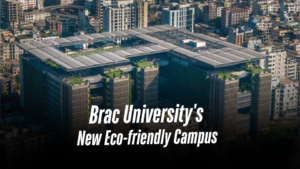
Brac University’s New Eco-friendly Campus: A Blend of Nature and Innovation
As you travel from Rampura to Badda in Dhaka, the imposing concrete structure in Merul Badda is hard to miss. Initially, it might seem like an industrial or commercial complex due to its sheer size on just 7 acres of densely populated land. However, its true purpose as a university is revealed once you step inside. The ‘triple height space’ design allows for free access to light and air, featuring long escalators connecting various parts, amphitheater-like stairs, and several ‘urban windows’ at the top. The building eschews unnecessary glitter, embracing the raw form of brick and concrete both inside and out. The carefully arranged garden adds a touch of greenery, making it an inviting space for students without any sense of grandeur. Inspired by the Sundarbans ecosystem, Brac University’s new campus seamlessly blends nature with architecture. Designed and constructed by experts from Singapore, China, and Germany, this campus in Merul Badda, Dhaka, stands as Bangladesh’s first eco-friendly and sustainable inner-city campus. Last February, Brac University’s new campus was inaugurated with the theme “In the call of green, the call of the future.” Tamara Hasan Abed, Chairperson of the Board of Trustees of Brac University, highlighted the university’s commitments to academic excellence, cultural prosperity, and environmental conservation. She also spoke about the university’s goals and plans to promote a holistic educational experience through environmentally friendly activities, local performances, and discussions. Founded by Sir Fazle Hasan Abed, Brac has always distinguished itself through various creative and innovative initiatives. Over the past two decades, Brac University has achieved significant milestones in higher education, research, and international competitions. Despite this, the lack of a permanent campus was a major limitation. Although there was a residential campus in Savar, it was only available to students for one semester. All other educational activities were conducted in multiple multi-storied buildings in the Mohakhali area. The new Merul Badda campus now provides a permanent, eco-friendly, and sustainable space for all students. Designed by the r e n o w n e d S i n g a p o r e – b a s e d architectural firm WOHA Designs Pte Ltd., Brac University’s new campus is a marvel of modern architecture. Key figures involved in the project include Professor Fuad Hasan Mallick, Dean of Brac University’s School of Architecture and Design; Zainab Farooqui Ali, Chairperson of the Department of Architecture; and Project Architect Shafiqul Islam Suman. This 13-story building with three basements is designed to accommodate around 15,000 students, reflecting a commitment to environmental consciousness. The design allows natural light and air to flow freely, featuring state-of-the-art facilities. Cutting-edge technologies such as cross ventilation, a hybrid thermal management system, and aerodynamic fins ensure optimal airflow. The greenery covering the building enhances the oxygen supply, while the hybrid cooling system maintains clean air in classrooms, helping students stay focused for longer periods. Impressively, the building saves 40% of its energy by reducing reliance on air conditioning. The campus sits on a transparent reservoir, with rain chains installed to collect and store rainwater, which is used to irrigate the building’s plants, and any excess fills the reservoir. Additionally, the campus boasts an advanced sewage treatment plant for waste management. This energy-efficient design uses a total of 5.5 megawatts of electricity, with 25% sourced from solar panels on the roof. For a facility of this size, this is considerably efficient compared to the usual 8 to 10 megawatts typically required. The interior of this aesthetically pleasing building is mostly open space, encouraging student interaction, extracurricular activities, and co-curricular engagements. Design considerations also include universal accessibility standards, ensuring ease of movement for people with special needs or disabilities. The new campus is not only a hub of academic excellence but also a beacon of sustainability and innovation, paving the way for future educational institutions in Bangladesh. Tamara Hasan Abed, Chairperson of the Board of Trustees of Brac University, emphasized the inspiration behind the eco-friendly campus and the educational philosophy of Brac University’s founder, Sir Fazle Hasan Abed. She explained that Sir Abed envisioned a university where education and free intellect would harmonize with nature. This new campus, a blend of nature and modern architecture, aims to teach future generations to think differently about life. She also highlighted the importance of innovation and creativity in urban development to protect nature. This campus will set a benchmark for students, planners, and stakeholders in urban planning and e n v i r o n m e n t a l conservation. Acting Vice-Chancellor Professor Syed Mahfuzul Aziz expressed his determination to develop Brac University’s new campus as a laboratory of knowledge and science. He stated, “We aim to develop this new campus of Brac University as a laboratory of knowledge and science. We expect that we will develop this university as a flagship university of Bangladesh by providing quality research and high-quality education. We are working towards that goal.” Professor Dr. Fuad Hasan Mallick, Dean of the School of Architecture and Design at Brac University, mentioned that discussions about building a permanent campus began after the establishment of Brac University in 2001. Several discussions with Sir Fazle Hasan Abed led to the selection of Merul Badda as the site for the new campus. One challenge was finding such a large land area in Dhaka, and Sir Abed wanted the campus to be located in Dhaka itself. In 2009, Sir Abed started planning the campus’s construction and selecting who would build it. He aimed for a world-class and exemplary campus that students could be proud of. The responsibility of designing the building was given to Singapore-based firm WOHA, known for their environmentally friendly designs. Sir Abed also appointed legendary Bangladeshi architect Bashirul Haque as an advisor for the project. Once the functional program for the campus was determined, the draft was finalized with key figures, including the dean and chairperson of the university. Fuad Hasan Mallick then visited the WOHA office in Singapore to discuss the campus’s design, and they developed a scheme.
Read More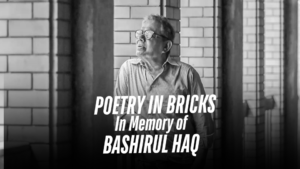
POETRY IN BRICKS: In Memory of BASHIRUL HAQ
Poetry in brick – is how a happy client described the house that Bashirul Haq had designed for them. This short write-up is an effort to describe this poetry and the process by which it was created. Bashirul Haq (1942-2020) had the good fortune to grow up in an idyllic rural environment, where he, unbeknownst to himself, imbibed how people could live in close harmony with the environs, where human habitation merged seamlessly with its surroundings, without disturbing it in any way. The eastern region of Bangladesh, and Brahmanbaria in particular, where his village lay 6 miles away from the town, is notoriously overpopulated. But from afar, from a car or a bus, the landscape is not crowded by people, and villages are tucked away behind clumps of trees, by paddy fields or water bodies. This is the simple living style that Bashirul Haq, as an architect, tried to adapt and express in his urban buildings. Architecture and architects in Bangladesh are carrying on the quest that Bashirul Haq was on—to find a grammar and an idiom of building that speaks to our landscape, that carries on our building traditions, yet is modern and contemporary, and responds to the needs of its users. Bashirul Haq used to describe his life as a series of happy coincidences. Most prominent amongst these coincidences, he felt, was his choice of profession. He discovered that designing buildings could be a profession as he sat browsing the USIS library as an intermediate student at Dhaka College. This set him out on a search for where he could pursue this subject. BUET had yet to start its department, and this led him to the National College of Arts (NCA) in Lahore and to apply for an interwing scholarship. This was a great career move, as the NCA was in search of a local architectural idiom. Trips to Mohenjo Daro and Harappa organized by the department, studying Mughal building traditions, and being housed in a building that embodied Indo-British architecture, students were encouraged to explore their modes of expression. This early training was honed at the University of New Mexico, where he went for his postgraduate studies. The adobe building patterns there further honed the young architect’s search for design practices that spoke to the environment and a sense of history and tradition. Returning to Bangladesh in 1977, Bashirul Haq felt that he could translate this training and preparation into practice. He began with small projects, and the ‘poetry in brick’ mentioned earlier was a house built for Justice Abu Sayeed Chowdhury. From the beginning, he chose brick as the construction material of choice. It sprung from the soil—nothing else could be more indigenous than brick, he would claim. Brick had a long history as a building material in the region, and he felt that the color of the brick and the green surroundings were in total harmony. His brick buildings were distinctive, but it meant that they appealed to a selective group of clients. However, he stuck to his design principles and always tried to combine the local with the modern. The cost of building was a big concern. In his more institutional buildings, such as the BCIC building, he would look for ways of cutting costs without compromising on aesthetic quality. Glossy materials were not part of his designs. Even the high-rise buildings are quite quiet—they do not draw attention to themselves in any way. The site is used to orient the building as much as possible with its environs. He was a purist in many ways and did not believe in using brick as surface cladding but as the actual structural material. He would emphasize the maintenance-free nature of brick, which does not need to be repainted or plastered. He spent long hours in making this material more resilient to weather conditions, to make it waterproof, or to prevent the salinity that tends to seep through. Architecture and architects in Bangladesh are carrying on the quest that Bashirul Haq was on—to find a grammar and an idiom of building that speaks to our landscape, that carries on our building traditions, yet is modern and contemporary, and responds to the needs of its users. Brick remains prominent in the architectural design practice in the country. This preponderance of brick has led, we are told, to great atmospheric pollution. Bashirul Haq would contend that ethical brickmaking processes would minimize this degradation and had a calculation regarding carbon emissions in the production of brick versus that of cement, where the brick was better. He also thought that more efficient methods of production had to be devised, minimizing the effects on climate. He was interested in building with mud and had designed a mud building, which sadly remains unbuilt. Reinforced bamboo was another material that interested him. He had prepared a book on cyclone-resistant housing in the coastal belt of Bangladesh. This book contains a detailed description of a house in the Cox’s Bazar region, which had withstood the great cyclone of 1991. Bashirul Haq was a thoughtful and creative person who believed that buildings should blend into the existing landscape, rather than stand out as monuments that define the landscape. In today’s world, with environmental issues at the forefront, this is a good architectural principle. Written by: Professor Firdous Azim Photo credit: Al Amin Abu Ahmed Ashraf Dolon | Prantography
Read More
TRAVEL BACK TO THE ROOT WITH JATRA
For now, you forget that you are in Dhaka city and go back to the rural roots. Thankfully, Jatra has made it possible in this city. Amidst the rigid and chaotic city life of Dhaka, if you need a break, miss the rural natural vibe, and want to have a warm and cozy time with a vegetarian meal in a colorful, mesmerizing rural Bengal ambiance with folk music, then surely “JATRA” is the place to visit. Imagine, on a moonlit night, you’re sipping tea under the sky, and a mesmerizing flute is blessing your ear; the breezy sound of the thatched roof plays along with the music. You look around and see the mud-textured wall, bamboo trees, fences, and traditional local art everywhere. For now, you forget that you are in Dhaka city and go back to the rural roots. Thankfully, Jatra has made it possible in this city. Amidst the rigid and chaotic city life of Dhaka, if you need a break, miss the rural natural vibe, and want to have a warm and cozy time with a vegetarian meal in a colorful, mesmerizing rural Bengal ambiance with folk music, then surely “JATRA” is the place to visit. Jatra was created in the year 2000 in Banani by artist and musician Anusheh Anadil to highlight Bangladesh’s folk arts and crafts. Harmony with nature is one principle philosophy of Anusheh. In Bengali, Jatra means ‘journey.’ The people and culture of Bangladesh are vibrant, and everywhere the “Jatra” is visible, that vibrancy and harmony are visible. The art and music lounge of Jatra is “Jatra Biroti.”. In 2023, Jatra was relocated a few buildings away, close to their previous address. The design is done by the “Roofliners_studio of architecture” in association with “Charuta” as the construction partner. Late Ar. Rajib Ahmed, Ar. Tesha Sarawat, and Ar. Monon Bin Yunus played an important part in the design of “Jatra.” They have shared their journey of designing “Jatra” with us. Ar. Tesha Sarawat said, “We are connected to Jatra from the very beginning. As a designer, as a friend, as an acquaintance, we contain the philosophy as well. The harmony of nature and human beings is the philosophy of Anusheh. We also believe that this helped us design the place. Jatra was a fun project. Guidelines were there; also, there was full freedom of designing. The experiment was there too. Adding, eliminating, and adapting from the mistake was the design principle that we’ve followed. We have got a building with a field. We have designed the entry in a welcoming way so that any passerby feels like entering the place without even realizing when they have entered. The performance space is seen from the road. Jatra wants to go closer to people and wants to take people closer to nature. It was all kept in mind while designing.” The main challenge was that the building was very small and congested when they got it. Small rooms, one door, like an old residential house. Also, the structure was brick. So they couldn’t break wherever they felt like. It was impossible without expert engineering advice. Eng. Mashroof Kabir was there, who advised on where to break and where not to, keeping the structure stable. In this way, the whole place became like an interconnected floor. So that, when you go inside, you become confused about the entry and exit, like a maze. Which is strategically good for a showroom design and is intentionally done in this way. The thatched hut, with a mud-textured wall with traditional ìPuthi artî throughout the wall continuing up to the roof in some places, bamboo seating, and a small ìgamchaî patterned flag with cozy and warm light, ensures very selective usage of interior detailing and the right execution of the concept of distinct rural Bengal ambiance. “One big multipurpose hall was added later; one structure of mango wood was added. One kitchen of the restaurant was added on the roof. Structurally, the building was two-and-a-half-storied. It was not very fragile itself. But the addition we were supposed to do could not be mistaken. No technical mistakes could be made while modifying. Keeping the permanent part, many things would be added to the design journey that we have decided on at the beginning of the design. Then we did this. It’s continuing. Every year something will be added. That is the journey. Jatra Biroti is the restaurant part, but the whole philosophy is jatra”, said Ar. Monon bin Yunus. It was just a building with a field. Old, but not very old. There was a plinth in the front, which is the hall room now. The plucked structures are not very permanent. Mango wood, hemp (Shaun), and tin are the types of materials that are used. The hall room is an important function but gives the vibe of a temporary structure. Plus, “jatra biroti,” the restaurant part has an extension on the ground floor, which is also of mango wood structure and hemp (Shaun). The restaurant part also continues on the roof and the top roof. Some interesting elements, like blocks and dice of blocks, are used on the roof. The old staircase is also there as an exhibit. Reusing almost everything from the old “jatra” is seen everywhere. The thatched hut, with a mud-textured wall with traditional “Puthi art” throughout the wall continuing up to the roof in some places, bamboo seating, and a small “gamcha” patterned flag with cozy and warm light, ensures very selective usage of interior detailing and the right execution of the concept of distinct rural Bengal ambiance. The courtyard, or “Uthan, is the most original and core architectural element of every rural Bengal homestead. This courtyard is the main attraction of “Jatra Biroti,” surrounding which is all the thatched-roof lower seating area in a small raised plinth with bamboo-silted woven curtains and colorful artworks. The idea behind it was to recreate a traditional courtyard of the delta. To build a warm, inviting
Read More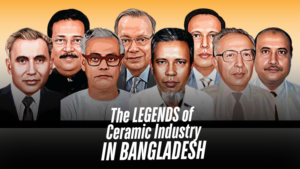
The LEGENDS OF CERAMIC INDUSTRY IN BANGLADESH
The ceramic industry in Bangladesh boasts a rich heritage and has produced several legends known for their significant contributions to ceramics and overall company formation. The industry has grown substantially over the past few decades, establishing itself as a leading sector in the country’s economy. In 1992, with the rapidly growing ceramic industry, a nationally recognized trade organization of manufacturers and exporters of ceramic tableware, pottery, tiles, sanitary ware, insulators, and other ceramic products was formed, called the Bangladesh Ceramic Manufacturers & Exporters Association (BCMEA), under the leadership of many of these ceramic legends. Here, we highlight some legendary leaders and key entrepreneurs who have been instrumental in the journey of the ceramic industry in Bangladesh. These pioneers have laid the foundation for the thriving ceramic industry in Bangladesh, which now covers various subsectors such as tableware, tiles, sanitary ware, and ceramic bricks. Their legacies continue to inspire future generations of ceramic entrepreneurs and professionals. Mohammad Abdul Jabbar Known as the pioneer of the ceramic industry in Bangladesh, Mohammad Abdul Jabbar founded Tajma Ceramic Industries. His contributions laid the foundation for modern ceramic manufacturing in the country. The story of Tajma Ceramic Industries Ltd is quite fascinating. In 1958, the ceramic industry took its nascent steps with only one small tableware manufacturing plant in Bogura. Mohammad Abdul Jabbar, instrumental in promoting and advancing the ceramic factory in Bangladesh, was the Managing Director of the company until his death on May 7, 1985. Tajma Ceramic Industries, recognized as the oldest modern ceramic manufacturing plant in Bangladesh, marked the formal beginning of the ceramic industry in the country. It was the first ceramic earthenware plant to produce porcelain tableware using traditional methods. Tajma played a crucial role in pioneering porcelain tableware production using advanced technology for its time, inspiring many other manufacturers to follow suit. Ariff Wali Mohammed Tabani In 1958, Mirpur Ceramic Works Ltd in Dhaka began producing heavy clay products using German plant and technology, gaining a reputation for manufacturing the best quality ceramic bricks in the subcontinent. The late Ariff Wali Mohammed Tabani, known for his contributions to Mirpur Ceramic Works, played a key role in its evolution. Tabani was the founding Chairman and Managing Director until his death on December 7, 1990. Currently, the company manufactures various types of unglazed tiles and has established two more ceramic companies, Khadim Ceramics and Sunshine Bricks. Both Mirpur Ceramic Works Ltd. and Khadim Ceramics Ltd. have been synonymous with ceramic-based construction materials, manufacturing a comprehensive range of products including blocks, bricks, ornamental screens, claddings, pavers, roofing tiles, and floor and wall tiles, along with the necessary mortars. These materials have been pivotal in landmark projects nationwide, showcasing the group’s commitment to quality and innovation. Md. Abdul Hai Mohammad Abdul Hai was a visionary entrepreneur who founded the country’s first ceramic sanitaryware company, Dacca Ceramics and Sanitary Wares Ltd., in 1969. He embarked on a revolutionary journey in the ceramic sector with the aim of advancing the country through innovative ceramic products. Despite facing political unrest and significant challenges during the Bangladesh Liberation War in 1971, which led to the destruction of the factory and the loss of materials, Abdul Hai was determined to rebuild the company. After the war, he successfully revived the company in 1974. Dacca Ceramics became the country’s first non-heavy clay building ceramic plant and started the production of sanitaryware in Tongi, Gazipur. Under his leadership, the company grew to become a leader in the country’s ceramics industry, known for its high-quality, durable, and cost-effective products. Abdul Hai’s dedication and resilience played a crucial role in shaping the success of Dacca Ceramics, leaving a lasting legacy in the industry. Mr. Hai passed away on December 21, 1995. Ansar Uddin Ahmed A key figure in Peoples Ceramic Industries, Ansar Uddin Ahmed significantly contributed to the industry through innovation and quality control, helping the company gain a strong foothold in domestic market. In 1966, Peoples Ceramic Industries Ltd, formerly known as Pakistan Ceramic Industries and located in Tongi, Gazipur, began production using modern porcelain tableware manufacturing technology from Japan and started exporting their products. The late Ansar Uddin Ahmed, a respected entrepreneur, inspired many in the field. He was the Managing Director of Peoples Ceramic Industries and Standard Ceramic Industries Ltd and passed away on August 14, 2005. He served as the first President of BCMEA from 1992 to 2002, revolutionizing the export of local ceramic products Rashed Mowdud Khan As the Managing Director of Bengal Fine Ceramics Ltd, Rashed Mowdud Khan advocated for sustainable practices and modern technologies in ceramic production, enhancing the global reputation of Bangladeshi ceramics. In 1986, Bengal Fine Ceramics Ltd, the first stoneware tableware manufacturer in Bangladesh, entered both domestic and international markets. The late Rashed Mowdud Khan was a prominent figure in ceramics, known for his artistic and technical expertise. He served as the first General Secretary of BCMEA from 1992 to 2002 and President four times from 2003 to 2009. He passed away on January 9, 2011. Iftakher Uddin Farhad Mr. Iftakher Uddin Farhad was the Chairman & Managing Director of FARR Ceramics Ltd and served as the President of BCMEA in the 2011-13 session. Established in 2005, FARR Ceramics is a manufacturer and exporter of Euro Fine Porcelain tableware. The company began as an export-oriented business in 2007, producing hard porcelain tableware for both international and local markets. Located in Gazipur, Bangladesh, the plant is equipped with state-of-the-art European ceramics manufacturing technology from Germany and Italy, and decal printing technology from Japan. FARR Ceramics currently exports to 31 countries, from North America to Europe, the Middle East, and India, with a monthly production capacity of 2 million pieces. Mr. Farhad passed away on December 25, 2012. Golam Sabur Tulu The founder of Madhumati Tiles Ltd, Golam Sabur Tulu introduced advanced technologies and designs in ceramic manufacturing, significantly impacting the market in Bangladesh. He was a visionary entrepreneur who made significant contributions to the ceramic industry.
Read More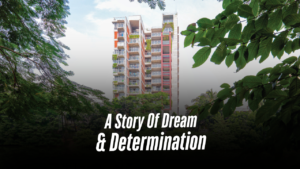
A Story of Dreams & Determination: South Breeze Housing Ltd.
In the growing heart of Dhaka in the mid-1990s, three brothers stood at the crossroads of ambition and legacy. Aminur Rahman Khan, Anisur Rahman Khan, and M. Ashiqur Rahman Khan were driven by the vision to create something extraordinary—something that would not only honor the legacy of their father, the late M. Abdur Rouf Khan, a pioneering businessman in Bangladesh’s shipping industry, but also transform the way people experienced home. With this dream, South Breeze Housing Ltd. was born in 1995. In their early days, the brothers set their sights on Dhaka’s most coveted neighborhoods—Gulshan, Dhanmondi, and Baridhara. They understood that homes weren’t just structures of concrete and steel but sanctuaries where lives unfolded. They poured their energy into designing residences that offered not just comfort but also an elevated lifestyle. Their first projects quickly gained attention. Each building was a statement of architectural innovation and uncompromising quality. As word spread, South Breeze became synonymous with exclusivity and refinement, setting a new standard for real estate in Bangladesh. “South Breeze is a trailblazer in the real estate industry; they were the first to believe in my vision,” shared Rafiq Azam, the renowned architect of Bangladesh. His firm, Shatotto Architecture for Green Living, has been collaborating with South Breeze Housing Ltd since 1998, being one of the pioneers to facelift the look of the residential real estate. A true artist, Azam seamlessly integrates his creative vision into the buildings he designs, setting his work apart. South Breeze’s ethos was clear: every detail mattered. From meticulously designed single-unit apartments to duplexes with breathtaking views, each project spoke to the company’s relentless pursuit of perfection. Collaborating with the country’s finest architects and engineers, they created masterpieces like ‘South Ripple’ in Gulshan, where residents could wake up to serene lakeside views, and ‘South Terrace’ in Baridhara, a collection of sprawling single-unit homes that felt like a retreat in the middle of the city. This achievement was made possible by Rafiq Azam’s boldness in challenging conventional norms. Reflecting on his inspiration, he shared, “I spent time in Puran Dhaka and noticed how open their houses are—the rooftops are close, the walls are low, and people feel more connected. This inspired me to think, why not use glass walls at the front of my apartments as a breath of fresh air, instead of the usual long concrete walls with barbed wires?” ARCHiTECTURE BEGAN TO CHANGE. PEOPLE STARTED NOTiCiNG THE DiFFERENCE. I BELiEVE WE ARE A COMMUNiTY, AND WALLS ONLY SERVE TO SEPARATE US FROM SOCiETY. THE GROUND FLOOR OF ANY BUiLDiNG iS CRUCiAL—iT SHOULD BE A SHARED SPACE FOR iNTERACTiON, CREATiNG ROOM FOR GREENERY, A PLAYGROUND FOR CHiLDREN, AND A CLEANER, MORE WELCOMiNG WALKWAY Their projects weren’t just buildings—they were homes that told stories, each uniquely tailored to the dreams of their residents. With walls made of glass, lush green porches, and thoughtfully designed playgrounds for children, these spaces fostered a sense of community while blending functionality and artistic vision seamlessly. “My main priority is that the buildings must be green—they need to have grass and plants so that the residents still feel connected to nature. There should also be a waterbody surrounding the building or a pond at its center,” shared Azam. His innovative approach paid off when the company’s out-of-the-ordinary architectural designs caught the world’s attention in 2017. Rafiq Azam won the ‘Cityscape Awards,’ a global accolade for outstanding architecture. This wasn’t just a win for South Breeze but a moment of pride for Bangladesh. Today, South Breeze continues to redefine luxury living. Their portfolio includes stunning developments like ‘South Supreme’ with its rooftop lap pool and panoramic views and ‘South Spring,’ a tranquil haven beside Dhanmondi Lake. Each project reflects the company’s deep understanding of its clients’ needs: privacy, sophistication, and a connection to nature. However, when architect Azam first embarked on his journey, his unconventional approach was met with skepticism. Many doubted the practicality of incorporating nature into buildings, fearing that it would lead to damp walls and significantly higher costs. His innovative requirements, such as large windows for enhanced ventilation, natural light, and expansive views, as well as the use of glass walls and exposed concrete instead of painted surfaces, were considered radical at the time. Despite these concerns, Azam remained steadfast in his vision. “Architecture began to change from that point,” Azam reflected. “People started noticing the difference. I believe we are a community, and walls only serve to separate us from society. For me, the ground floor of any building is crucial—it should be a shared space for interaction, not just a parking lot. That’s why I chose to position the cars at the back, creating room for greenery, a playground for children, and a cleaner, more welcoming walkway.” There was a time when there was no space to add plants in front of the building, so in 2002, I decided to take the garden to the roof—a concept that was considered impossible back then. But I made it happen. I transformed the roof into a thriving garden, which was greatly appreciated by the residents. The innovative decisions taken by South Breeze not only provided them with a significant business advantage but also solidified their reputation as leaders in the industry, thanks to their ability to break barriers and embrace bold ideas,” he added. Rafiq Azam did his job as an architect, but South Breeze took care of his art, making sure they did not lose their value over the years. “I owe it to South Breeze for where I am today and making my architectural dreams come to life,” he concluded. As they continue to expand their portfolio and take on new challenges, one thing is certain: South Breeze isn’t just building homes—they’re shaping the future of living. For those looking for a home that tells a story as unique as theirs, South Breeze offers not just a residence but a legacy. This made South Breeze offer more than a luxury but a lifestyle. Families who move
Read More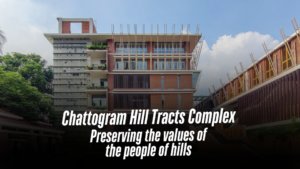
Chattogram Hill Tracts Complex: Preserving the values of the people of hills
The complex was designed with one mission in mind: to give visitors the impression that they are experiencing a piece of the Chattogram Hill Tracts right in the heart of bustling Dhaka. The complex serves as a pivot between the people, and architecturally, it has achieved in taking us close to experience Chattogram Hill Tracts without having to travel 300 kilometers. This cultural complex consists of an office building, library, multipurpose hall, amphitheater, restaurant, public plaza, sculptures, and water body in the 2 courtyards, souvenir shops, etc. The public places of this complex are designed in a way to facilitate communal meets, fairs, and cultural events in the public and semi-public zones. Layout, zoning, planning, and construction of the entire complex were modeled after, or at least resembled, structures hailing from the hill tracts, using their common building materials like bamboo, straw, cane, and thatched roofs, which were initially used. A distance of 300 kilometers keeps Dhaka people from experiencing the rich cultures of the Chattogram Hill Tracts (CHT). To bridge that, the Chattogram Hill Tracts Complex has been constructed on Bailey Road, in the heart of the capital city of Bangladesh. This government project has also brought the deeply cultural people of the CHT closer to the Dhakaites. The primary concept behind this 2-acre complex was to serve as a common gathering space where children of hills and city people can come together, as well as exchange intercultural values. To strengthen the complex, modern materials like reinforced concrete and rods were used around it but not to take away its vernacular architectural roots from it. For example, thatched roofs of huts are trussed up with external support struts or buttresses made of very basic material but with superior compressive strength—bamboo. However, the aluminum beams propping up the surrounding top floor serve that symbolic role. The complex was designed with one mission in mind: to give visitors the impression that they are experiencing a piece of the Chattogram Hill Tracts right in the heart of bustling Dhaka. A sloped garden and a fountain mimicking the trickling down of water from a hill face welcome visitors. The sound of water trickling can trick the mind that one is standing next to a natural fountain if they are leaning into the experience. The grand amphitheater is yet another attraction of the Chattogram Hill Tracts Complex. Besides functioning as a venue for plays and shows, this open-air amphitheater can be a wonderful place to sit and enjoy the quiet and spatial experience of this state-of-the-art complex. North of the amphitheater is a crescent-shaped artificial water body. Many beautiful sculptures are displayed between the water body and the amphitheater. These two attractions are joined by a spiraling staircase. The sloped garden on the side of the elevated amphitheater gives a visitor the impression of standing atop a hill. However, visitors will be greeted by beautiful waterscapes at the entrance, even before they reach the best part. The neat waterbody is depressed into the ground, and its step design can remind one of the Rajsthani Chand Baori, although a lot less elaborately. This should give an idea of the extensive care that was spent constructing this complex, which is meant to bolster relations between two peoples. And whether one would like to collect a souvenir, they can do so at the entrance where the souvenir shops are, next to the water body, or they may get their souvenirs at the end of their stay, since the shop would be in the way either way. The number of elements in the complex is high. Yes, there are public spaces that hold all the pretty water bodies and sculptures, semi-public spaces comprising administration buildings, and private spaces that form up a minister’s bungalow, chairman’s bungalow, and dormitories and suites for officials. Yet, the entire complex boasts ample open space through which sufficient air and light flow through without much hindrance. Nooks and crannies of this large project are given room to grow green grass and plants wherever possible. Grass aside, walkways are divided up by lines of pebbles between brick and tile floors, occasionally having concrete stepping slabs. To design freely with nothing held back is one way to go. The designer might as well create something completely fresh and be applauded for it. However, fusion, on the one hand, means staying truthful to each element in the blueprint, and, on the other hand, it also means having to come up with something different by mixing two or more elements. Architects with extensive experience and a clear vision are then responsible for achieving this. Restrictions of conforming to design elements from the hill tracts while embracing modernity were there, but the finished outcome, it seems, has achieved the desired fusion. A fine balance between modern versus nature is evident in this complex. And yet, the interior design of the Chattogram Hill Tracts Complex is a very different picture. Every inch of its interior oozes modernity in every way possible. Hanging staircases supported by high-tensile steel cables, lofty ceilings with wooden panels for ultra-modern design, soft, warm ceiling lights, squeaky clean floor tiles throughout the interior, etc., all add up to the modern style of interior decoration. Since its inception in 2022, the Chattogram Hill Tracts Complex has already hosted two full-fledged Mela (fairs). Culturally, the complex serves as a pivot between the two peoples, and architecturally, it has achieved in taking us close to a CHT experience without having to travel 300 kilometers.
Read More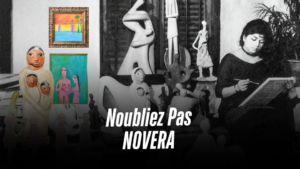
Noubliez Pas Novera
THE WAYS NOVERA PLAYED WITH FORMS AND SHAPES ON HER BEST SCULPTURES HAVE AN INEXPLICABLE AURA THAT CAPTIVATES AND TAKES YOUR SOUL TO A SPACE THAT IS SOMEWHERE BETWEEN THE VAST ABSTRACT AND YET TANGIBLE. In August of 1960, on the ground floor of the Central Public Library building of the University of Dhaka, showcasing 75 of her artworks sculpted between 1956 and 1960, Novera Ahmed had her first solo exhibition titled “Inner Gaze.” This formidable exhibition arguably sparked the genesis of modern sculpting practice in both West and East Pakistan (now present-day Bangladesh). She was the first-ever sculptor from the undivided Pakistani region. Novera Ahmed was born on March 29, 1939, in Kolkata, British India, and on the occasion of her 85th birthday, this attempt is to reminisce about one of the finest artistic personages from this part of the world. Today, Novera’s importance is cemented in the history of art in this region, and it seems that she has a newly found celebrity status, especially amongst the younger generation of art enthusiasts, but for decades and even today, to a significant extent, Novera’s public repute mostly synonymizes as enigmatic. But Novera should not be important because of her public portrayal that branched from her peers: that she was a good-looking female artist of prodigal calibre who worked and lived independently as a divorcee in a patriarchal society; the way she did her buns and draped herself in black sari and curated her look as Baishnabi wearing Rudraksha garland and tilak on her forehead; that she used to exploit her male peers; that she had a sentiment because of the way she was gazed upon and which is why she eventually left Bangladesh; the list of such narratives that circulated her is pretty long. Novera is important because of her artworks; the quality of her artworks effortlessly transcends the tags she was associated with, which boxed her only as an eccentric rebellious character, undervaluing her art. The ways Novera played with forms and shapes on her best sculptures have an inexplicable aura that captivates and takes your soul to a space that is somewhere between the vast abstract and yet tangible. Novera used to travel around and gradually minimised her activity in the local art scene. Her complete disappearance from the scene in 1970 after she permanently moved to France eventually turned her into a myth. Later, she married the love of her life Gregoire de Brouhns in 1984. Although there is no concrete evidence regarding why she left, it is speculated that the key reasons are monetary and no recognition even from her peers. Belonging to a middle-class background, she almost single-handedly established a medium that was still very new in the region so there were not many commissions for her so she could continue her practice and earn a decent living. There was also an uncanny silence from her peers, which only fueled the collective negligence towards her. Even in the artist community, she was only remembered as an amateur female sculptor. In fact, for a while, it was even established that she was dead, and it was only in late 1998 after a brochure of her 1960 exhibition was found, that it catalysed the rebirth of discussions about artist Novera Ahmed. Although Novera studied in Europe and like many other artists, had that influence on her works in her earliest years, very soon she found her style. If we examine Novera’s available discography of sculptures and paintings, it resembles the wide array of subject matters she had her interests. Notably, in artworks from her formative years, it is very evident how much she was fascistically influenced by her roots. The way she took Bengali folk elements and ethereally blended them within her modernist approach of practice shows how revolutionary she was. Novera’s idea of using cement instead of large blocks of stone or wood, as they are scarce in this region, and sculpting such smooth cement sculptures, which is very difficult to accomplish, shows both her innovativeness and technical prowess. When she started traveling to Southeast Asia, she decided to collect scrap metal from the debris of the U.S. Air Force plane used in the Vietnam War and use it as materials for her newer sculptures at the time. For a long period, little to no care was taken to preserve most of Noveraís works that are in Bangladesh. In fact, for a while, it was even established that she was dead, and it was only in late 1998 after a brochure of her 1960 exhibition was found, that catalysed the rebirth of discussions about artist Novera Ahmed. She was also highly influenced by Indigenous and Buddhist themes; in fact, she once said that the form of the concrete structures of the Shaheed Minar (which she co-designed with another notable artist, Hamidur Rahman—a topic that still has loads of debate regarding who came up with the original idea) is inspired by the idea of an ascending hand of Buddha. The long list of her oeuvres includes works like Cow With Two Figures (1958), Serpent Nommé Désire (1972), Le Djinn (1973), Le Heron (1982), Le Baron Fou (2001), etc. In her France years, even after Novera was wheelchair-bound after a life-altering car accident, she continued working with her forever devotion and love towards art, till she was bedridden due to health complications when she was older and eventually passed away on May 6, 2015. For a long period, little to no care was taken to preserve most of Novera’s works that are in Bangladesh. The whereabouts of many of her works are yet unknown, and the ones that survived did so due to her patrons and private collectors. A collection of her works and memorabilia is at the Musee Novera Ahmed at La Roche-Guyon in northern France which was set up by her dear husband. Currently, only 33 of Novera’s sculptures are in the collection of the Bangladesh National Museum, and the gorgeous frieze that she
Read More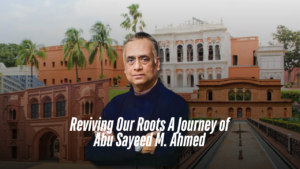
Reviving Our Roots A Journey of Abu Sayeed M. Ahmed From Legacy To Leadership
While many architects push the boundaries of innovation, there have been some who charted a different course. Instead of focusing solely on creating the new, Architect Dr. Abu Sayeed M. Ahmed turned his gaze to the past—reviving forgotten monuments and ancient buildings. A pioneer in conservation architecture, he has dedicated his life to protecting and restoring the architectural jewels of Bangladesh. For Dr. Sayeed, preserving heritage is not just about safeguarding structures; it’s about understanding who we are and how the past shapes our identity today. From restoring historic mosques and colonial buildings to leading the Institute of Architects Bangladesh as president thrice in a row and serving as the elected president of ARCASIA on an international level, his contributions have earned him both national and global recognition. As an educator and author, his efforts in heritage protection continue to inspire future generations of architects. Dr. Sayeed’s legacy as a guardian of Bangladesh’s architectural treasures makes him an enduring force in both the past and future of the nation’s architectural identity. A pioneer in conservation architecture, he has dedicated his life to protecting and restoring the architectural jewels of Bangladesh. For Dr. Sayeed, preserving heritage is not just about safeguarding structures; it’s about understanding who we are and how the past shapes our identity today. From the Water’s Edge: A Childhood in Comilla Long before the architectural world knew his name, there was a young boy in Comilla, Bangladesh, who spent his days by the waterside, watching the reflections of ancient trees shimmer in the lights and ponds. In this quaint town, the city’s water bodies—like Dharmasagar and Rani’s Dighi—were more than mere landmarks; they were playgrounds, gathering spots, and the backdrop to countless moments of childhood joy. Football games often ended with a refreshing dip in the cool waters, and laughter echoed across the banks, blending with the gentle sounds of nature. That little boy, Abu Sayeed M. Ahmed, found joy in simple things like drawing intricate sketches, building models, and creating Eid cards. His love for the technical precision of his creations grew in the quiet corners of his home and school, unknowingly laying the foundation of his future as an architect. Abu Sayeed’s fascination with design was nurtured by his father, Abdur Rashid, a principled educator, and his mother, Helena Begum, whose warmth and love kept the heart of their home alive. The roots of his curiosity about history and architecture grew deep in the soil of Comilla, where he first learned to see beauty in the details around him. Even as a student at Comilla Zilla School and later Comilla Victoria College, Sayeed stood out. His involvement in Scouting allowed him to explore Bangladesh’s landscapes, meet people from different walks of life, and develop a strong sense of leadership. By the time he graduated in 1976, these experiences had shaped his collaborative spirit and a love for discovery—qualities that would define his career for years to come. His bond with his architecture batchmates was legendary. Known as the “batch of talents,” they shared a camaraderie that extended beyond classrooms. From organizing grand tours across India and Bangladesh to planning picnics, Sayeed often emerged as the natural leader. His ability to bring people together flourished during these years, and the friendships he built remain strong to this day. In 1983, he graduated with a Bachelor of Architecture, ready to leave his mark on the world. Stepping Into a New World: The BUET Years In 1976, Abu Sayeed entered BUET’s Department of Architecture, a choice that marked the beginning of a transformative chapter. Life at BUET was unlike anything he had known. Sharing dormitories with students from other disciplines introduced him to diverse perspectives. While his engineering peers were deep in equations, Sayeed and his classmates were sketching, brainstorming, and working late into the night on design projects. The Architect Emerges: Early Projects at ECBL Sayeed’s first professional step was joining the consultancy firm ECBL, where he worked for four years. It was a period of intense learning and growth. He became involved in landmark projects such as the Bangabandhu Hall of Dhaka University, Nagar Bhaban, the Air Force Academy in Jessore, and the Dhaka Cantonment’s central mosque and library. These projects gave him firsthand experience in balancing design with functionality. His natural f lair for leadership and meticulous approach to detail made him an asset to the firm. However, Sayeed knew his journey was far from over—he dreamed of exploring new horizons. A New Chapter in Germany: Rediscovering Bangladesh In pursuit of higher education, Abu Sayeed M. Ahmed embarked on a bold journey to Germany to pursue his master’s degree in architecture. Before leaving, he received two meaningful gifts—one from Lailun Nahar Ikram, the Managing Director of ECBL, who gifted him $1,000, and another from Prof. Abu Haider Imam Uddin, a colleague at ECBL, who presented him with the book Islamic Heritage of Bangladesh by Dr. Enamul Haque. Little did he know, this book would become a faithful companion in his new chapter abroad. The transition was anything but easy. Sayeed had to learn German from scratch, adapt to a foreign culture, and navigate a competitive academic environment. He lived in a hostel with students from all over the world, and conversations inevitably turned to his homeland. “What makes your country special?” his peers would ask. At first, Sayeed found himself at a loss for words, unsure of how to convey the richness of Bangladesh’s heritage. But then, the book he had been gifted came to his mind. The book Islamic Heritage of Bangladesh became his bridge to the world. He started to share Bangladesh’s architectural treasures—the Sixty Dome Mosque, the Small Sona Mosque, then the Paharpur Monastery, Mahasthangarh, and so on. His peers were astounded. “Bangladesh has a heritage this rich?” they asked, their eyes wide with surprise. They had never imagined that such ancient, awe-inspiring architecture existed in a country they often perceived as impoverished. These moments sparked something
Read More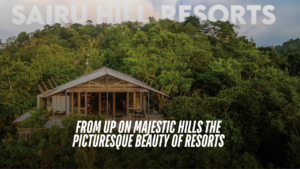
FROM UP ON MAJESTIC HILLS FROM UP ON MAJESTIC HILLS THE PICTURESQUE BEAUTY OF RESORTS
Discovering A Gem Like Sairu, Amidst The Serena Hills Of Bandarban, Will Feel Like Uncovering A Hidden Treasure. The Experience Will Be Nothing Short Of Magical, Blending Natural Beauty With A Sense Of Tranquility That Only The Mountains Can Provide. Sairu is a contemporary eco-resort that blends modern luxury with natural harmony. Designed with sustainability in mind, it incorporates local materials like stone and bamboo to create a rustic yet refined aesthetic that seamlessly integrates with the surrounding environment. If given a choice between the beach and the mountains, I wouldn’t hesitate to pick the mountains. Exploring mountainous terrain has always been a source of joy for me, and discovering a gem like Sairu, amidst the serene hills of Bandarban, felt like uncovering a hidden treasure. The experience was nothing short of magical, blending natural beauty with a sense of tranquillity that only the mountains can provide. The resort is around a 40-minute drive from Bandarban town. Upon entering the compound of Sairu, the f irst thing that will grab your attention is how everything looks in place and blends effortlessly with the surrounding topography. There is not a single element or structure you will find there that is off-putting. To the entrance left of lies the the reception and dining area, nestled beside a tranquil water body. From the hanging balcony of the eating zone, the panoramic view of the towering hills and the Shanghu River is breathtaking, offering a visual feast that captures the essence of Bandarban’s serene charm. To the right of the entrance, cottages are arranged in terraced layers along the hillside, accessible only via steps. For those less accustomed to physical activity, the steep climb might feel challenging, especially with frequent trips. However, the effort is well rewarded with changing, picturesque views at every turn. Mini golf carts are available for transporting luggage and assisting individuals with disabilities. At the hill’s summit lies the infinity pool and jacuzzi, offering unparalleled vistas. Rest stops throughout the resort invite you to pause and enjoy the stunning beauty of Bandarban. Long ago in Bandarban, a Mro princess named Sairu fell in love with a prince from a rival hill tribe, defying tribal rules. Their secret meetings ended tragically when the prince was forced into an arranged marriage. Heartbroken, Sairu disappeared into the hills. The resort is named after this story, with “Sairu Point” marked by entwined trees on a hill, symbolizing their love. The Sairu Hill Resort draws its name and logo from this legend, preserving its memory for visitors to honor. Sairu is a contemporary eco-resort that blends modern luxury with natural harmony. Designed with sustainability in mind, it incorporates local materials like stone and bamboo to create a rustic yet refined aesthetic that seam lessly integrates with the surrounding environment. The cottages at Sairu are thoughtfully priced, offering options tailored to your preferred view. Each cottage features a private balcony and a spacious washroom with a unique, nature-facing concrete bathtub—a rare luxury in the country. The rooms are generously sized and adorned with colorful jute rugs, bamboo curtains, and furniture crafted from tree logs. A standout piece is the giant coffee table, made from a single slice of a tree trunk. Modern amenities such as toiletries, skincare essentials, laundry services, and safes ensure a comfortable stay. The culinary excellence of the resort is also a notable mention if you are into local cuisine. Their downhill restaurant provides all kinds of meals and offers both à la carte menus with diverse cuisines and buffet options. Open to all visitors, not just guests, it welcoming provides space a for anyone looking to enjoy a meal amid the serene surroundings. There is also a badminton court in another part of the downhill. The resort’s design and execution were spearheaded by DOMUS, a renowned architectural consultancy in Bangladesh, with Principal Architect Mustafa Ameen envisioning a “less is more” approach. The master plan was crafted to respect the natural terrain, with structures elevated on steel stilts to preserve the contours and existing trees left untouched. Additional greenery enhanced the landscape, ensuring harmony with the surroundings. Maximizing panoramic views, the design integrates modern luxury with environmental sensitivity, with the only major alteration being the driveway carved into the hill. Water was sourced from a spring 1,200 feet below, showcasing remarkable ingenuity. The mornings at Sairu are invigorating, with a gentle breeze whispering through the trees, while nighttime transforms into a magical spectacle, as the starlit sky casts an enchanting spell, leaving visitors in awe. Once you are inside Sairu, you will not feel the need to go elsewhere, as the tasteful setup with modern amenities will you amazed. But, yet, if you have plans to keep explore the surroundings, Sairu will arrange that for you. You can rent a jeep or CNG from them and explore the nearby tourist attractions like Nilgiri Mountain. Written By Kaniz Supriya
Read More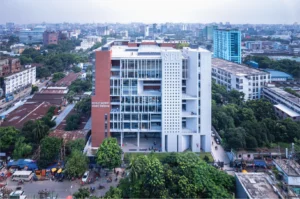
A stunning display of architectural grandeur, welcoming students
We are all familiar with the Dhaka University and its grandeur. Even now, when major infrastructures shroud the beautiful campus, its thousands of students still enjoy a little retreat among greeneries in, for example, Muktamancha or Suhrawardi Udyan. The same can also be said for all public universities. It’s on one such campus where BUET alum Khandaker Ashifuzzaman Rajon, Principal Architect of Cubeinside Design Limited, studied architecture. Of course, Rajon’s idea of a campus vastly differs from that of private university students. Thus, when tasked with designing a campus for Southeast University (SEU) well within the hustle-bustle of Dhaka, Rajon had to tumble down all his cards and think of fresh ways to give the students of Southeast University some taste of his own campus-going experience. The project being the permanent campus came with the additional worry of how to design the structure that would inspire students to enrol just looking at the place years, even decades, after its novelty factor has worn off. But before we go further into Rajon’s and the Southeast University permanent campus story, allow us to tell you what it is about all private universities competing to move to their permanent campuses. Competition here is particularly good, as all private universities want a permanent campus that is the most student-friendly while being attractive. UGC, the University Grants Commission, recently stipulated that all private universities, without fail and exception, move to a permanent campus that facilitates students with open space, interactive classrooms, and all the amenities that university students abroad enjoy from a campus. So, that triggered the mass relocation of private universities to actual campuses in place of stuffy buildings. Rajon opened his story with the mandatory 50% open space policy in the rulebook for building a new permanent campus. “The idea of a cubic volume in the centre of the campus came from this rule. I wanted the rest of the structure to look over the open space as the centerpiece of the campus. As a by-product, a central courtyard would help dissipate light and aerate its surroundings, like the classrooms, for example. However, the Board wasn’t initially unanimous about the central open space idea, but it was up on completion that they saw my vision behind this design choice, and this later became everyone’s favorite part of the entire campus,” began the architect. But beyond the Board’s stamp of approval, the campus just had to be completed and made fully functional within a very limited window of time, set by the UGC. If you happen to be a current student of SEU or have even visited the place, you may have taken a moment’s pause and thought of how it was even possible to erect an edifice as such in such a constricted amount of time. This is where the seasoned, but young, architect’s ingenuity just begins. If my memory serves well, I remember seeing in the popular cartoon show “Popeye: The Sailor Man” Popeye stacking floors upon floors of a skyscraper with steel I-beams, all in one shift, of course with the help of his special formula spinach, but steel I-beams were the actual hero that allowed for construction at such mind-boggling speeds. I am not inferring that Rajon got his hands on Popeye’s spinach, but being the well-bred architect that he is, he knew that I-beams would be an ideal instrument in his race against time. He explained how: “All the brick and concrete facades of the entire complex give it the impression of an RCC (reinforced cement concrete) structure, but its basic skeleton is made of I-beams. This bought me time! I-beams, like Lego, just have to be joined together using nuts and bolts without trading modern looks for time or structural integrity, but we did trade off some extra money to be able to complete construction in time.” The mission he had in mind to let light dance around the entire complex with the help of a central open space was a massive success. As the structure was shaping up rather quickly, it was instantly visible that the same campus took on different faces because of the changing sunlight that entered at different angles at different hours of the day. As a creator, the play of light and shadow had Rajon all emotional when he laid eyes upon the outcome. “The place would change its look at the change of each season too,” he said. “A few of my acquaintances who study at SEU find the campus quite photogenic. As climates change, they post photos and reels of different parts of the campus on their social media, and from there, I get to observe, from an onlooker’s perspective, how the most important beneficiaries of the campus—who are the students—are lovingly accepting it and are also low-key boasting it on their socials.” All this is to say that a structure made exclusively out of complex mathematics and engineering can also evoke emotions when made with the human angle in the mix. Ever since the permanent campus opened its doors to students in early 2023, the entire place teems with students in any direction imaginable. Not only is that the proper utilisation of space, but it also points towards the inevitable fact that students love their new campus. Everyone is doing what a student does: going in and out of class, singing, laughing, teasing, playing with classmates between classes, and most importantly, enjoying their newfound freedom in such a capacious facility that can house over 12,000 students at once! The former campus building is in the backyard of the new campus. It will be demolished soon and replaced by a new building to house the School of Engineering. It is to be designed by Cubeinside Design Limited as well. “But looking at the design of the new building and the one we just completed, no one will be able to say that the same architecture firm was behind the drawing board of the second one; it’s that different from the
Read More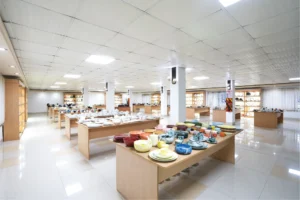
Paragon Ceramic, Pioneering Innovation and Sustainability in a Challenging Global Market
The global ceramic industry, including Bangladesh, is navigating a period of uncertainty due to economic slowdowns, fuel shortages, and inflation. However, Paragon Ceramic Industries Limited (PCIL) has managed to stand out as a leader in this competitive sector, driven by an unwavering commitment to quality and resilience. Below is a closer look at the company’s journey, challenges, and future plans as discussed by its Managing Director, Farian Yusuf. A Journey of Resilience and Early Success Founded in June 2008, Paragon Ceramic began commercial production in December 2010. Remarkably, within just two months, the company achieved its first export, a significant milestone that set the stage for its future success. Despite the current oversupply in the domestic market, Paragon continues to thrive internationally, with exports showing considerable growth. “Our entry into exports soon after production was a major accomplishment,” said Yusuf. “Although the local market is challenging, we are seeing tremendous growth internationally.” Paragon Ceramic: A Leader in High-Definition Porcelain Tableware Manufacturing Located in Mirzapur, Gazipur, approximately 50 kilometers from Dhaka, Paragon Ceramic benefits from a strategic location with access to all necessary infrastructural facilities. With a total investment of over US$ 16 million, PCIL has established itself as a key player in the porcelain tableware industry in Bangladesh. Cutting-Edge Technology and Skilled Workforce PCIL specializes in manufacturing and exporting high-definition porcelain tableware, utilizing state-of-the-art machinery sourced from renowned global suppliers like SKK and TAKASAGO from Japan, TCK from Taiwan, Modena and COTO from China. The factory is supported by a workforce of approximately 1,600 highly skilled and motivated employees, ensuring the highest quality in every product. “In a market where competition from China is fierce due to low pricing, Paragon Ceramic has adopted a strategy of prioritizing product quality over competing on price. China, with its advanced technology and domestic resource pool, offers products at far lower costs than Bangladesh.” Durability and Performance Paragon Ceramic decorated tableware combines vibrant colors and unique shapes that endure even the most demanding dining kitchens. Our proprietary clay recipe, infused with alumina, ensures strength, durability and a pure white finish. Yusuf said “Tested for quality, our products resist fading, chipping, and scratching, even after 500 dishwasher cycles. With advanced shape engineering and glazing techniques, we guarantee functionality, hygiene, and impact resistance”. Innovation and Global Reach Through cutting-edge technology and constant design innovation, Paragon Ceramic stays ahead of trends, offering high-performance tableware. With a robust global distribution network, we ensure timely deliveries worldwide. State-of-the-Art Manufacturing and Quality Assurance PCIL operates with cutting-edge technology, from its porcelain plant to its decal and packaging units. With modern equipment from Japan, Taiwan and China, and a highly skilled workforce, PCIL produces high-definition porcelain tableware for global markets like IKEA and H&M. The company excels in custom designs, meeting clients’ diverse requirements with unmatched flexibility and service. Precision and Excellence in Every Step PCIL’s advanced Mould unit and dedicated Quality Assurance (QA) team ensure every product meets strict international standards. With over 25,000 Mould produced monthly, the team delivers high-quality ceramics while adhering to ISO 9001:2015 standards for superior customer satisfaction. Overcoming the Industry’s Biggest Challenges Paragon has faced its fair share of challenges, from fuel shortages to a shortage of skilled workers. The company’s resilience in overcoming these hurdles speaks volumes. According to Yusuf, the biggest obstacle remains the gas crisis, which has severely impacted production costs and supply. “Fuel costs have skyrocketed by over 250 per cent, yet gas pressure remains very poor, affecting overall production,” he explained. “We’ve had to turn to alternative energy sources but that increases our costs, making us less competitive and facing global challenges to survive” Despite these difficulties, Paragon has continued to expand and evolve, focusing on maintaining its stronghold in international markets while also striving to meet local demand for Porcelain tableware. Quality over Price: A Global Strategy In a market where competition from China is fierce due to low pricing, Paragon Ceramic has adopted a strategy of prioritizing product quality over competing on price. China, with its advanced technology and domestic resource pool, offers products at far lower costs than Bangladesh. However, Paragon’s superior quality remains a competitive edge. “While China has access to its own resources, we rely heavily on imports, which raises our costs,” said Yusuf. “But in terms of quality, we’re second to none and that’s what has helped us to secure buyers internationally.” Reducing Import Duties: A Key to Growth Yusuf believes that reducing import duties on raw materials could significantly boost Bangladesh’s Ceramic industry and its global competitiveness. Since the sector relies entirely on imported raw materials, lowering these costs could fast-track growth and innovation. “If the government offers duty benefits, the sector will see accelerated development. We have the potential, but policy support is crucial to our future,” said Yusuf. Attracting Foreign Direct Investment (FDI) for Expansion Paragon Ceramic is also focused on attracting foreign direct investment (FDI), which Yusuf sees as essential for broadening the scope of the industry. More FDI could increase the number of companies in the sector, giving buyers more options and boosting confidence in Bangladeshi ceramics. “In the same way that Bangladesh’s garment industry grew with increased foreign investment, the ceramic sector can also be benefited,” Yusuf explained. “The more companies we have, the more options buyers have, leading to better overall industry growth.” The Gas Crisis: A Major Production Bottleneck The ongoing gas crisis has led to a surge in fuel prices and decreased availability, creating a substantial challenge for Paragon and other industries. Low gas pressure in industrial areas like Gazipur has severely impacted production as well as quality that reflects on financial statement. “The entire industrial area is affected by this, and it’s not just us—garment and other industries are also facing disruptions,” Yusuf said. “We need long-term solutions for energy security if we are to continue growing.” Technological Advancements: A Path Forward Yusuf emphasizes the need for technological innovation to enhance production efficiency and maintain competitiveness. While inflation has dampened local
Read More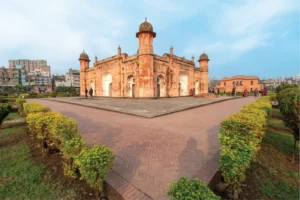
The Unfinished Mughal Fortress
Lalbagh Kella is perhaps the most quintessential remnant of the Mughal era in Bangladesh. Also known as Lalbagh Fort or Fort Aurangabad, it is a majestic historical site located in the heart of the old town of Dhaka. Built during the 17th century, Lalbagh Fort is a testament to the grandeur of this region’s rich history. Commissioned by Prince Muhammad Azam, the third son of Emperor Aurangzeb, it is also one of the most renowned Mughal structures in the subcontinent. Although Prince Azam initiated its construction, it was left incomplete due primarily to untimely death of his beloved wife, Pari Bibi. Iran Dukht Rahmat Banu, more known as Pari Bibi, was the daughter of Shaista Khan and grandniece of Nur Jahan, the consort of the Mughal Emperor Jahangir. Prince Muhammad Azam’s dream of creating a magnificent fort was left incomplete due to his wife’s untimely death and his own departure to join his father’s military campaign. This poignant episode in the prince’s life is an integral part of the fort’s history. The incomplete status, frozen in time, grips the guests within an aura of wonder about what it might have looked like had it been finished. In 1678, Mughal Prince Muhammad Azam Shah embarked on the construction of Lalbagh Fort along the bank of Buriganga in the southwestern part of Dhaka city. At the time, he held the position of Subedar (Provincial Ruler) of Bengal. However, his tenure in Bengal was only 15 months. His father Emperor Aurangzeb called him to Delhi to suppress the Maratha rebellion. Despite this setback, significant progress had been made, including construction of a mosque and the Darbar Hall. In 1680, Shaista Khan assumed again the role of Subedar of Bengal and took up the mantle of completing the fort. Under his guidance, the construction resumed. However, tragedy struck when Shaista Khan’s daughter, Pari Bibi, passed away prematurely within the fort in 1684. Grief-stricken, Shaista Khan deemed the fort is inauspicious and halted further construction, leaving it forever incomplete and abandoned. Shaista Khan ruled Bengal in Mughal period for a total of 22 years, from 1664 to 1678 and from 1680 to 1688. He was the maternal uncle of Emperor Aurangzeb. During his reign Dhaka prospered greatly and the best period of Mughal rule passed. He built Chota Katara Mosque and Seven Dome Mosque near Lalbag fort. Chittagong victory is one of his notable achievements. He also defeated the British in the Anglo-Mughal war. The architecture of the fort reflects the distinctive style, characterised by its typical grandeur, symmetry, and meticulous attention to ornamented details. Built primarily with brick, it showcases the finesse of Mughal-era craftsmanship. The fort’s main gateway is a three-story structure that embodies the classic Mughal arch. The gateway features ornate floral motifs and Quranic inscriptions, a sublime fusion of Islamic art and architecture. With its symmetrical design and elegant arches, the southern gate of the fort is another splendid example of Mughal architecture. The fort is adorned with massive corner towers, each with a distinctive style. These towers served both decorative and defensive purposes, and they provided an excellent vantage point to appreciate the entire site and its surrounding landscape. Tomb of Pari Bibi: A Testament to Love and Tragedy The tomb of Pari Bibi stands as one of the three primary structures within Lalbagh Fort — a silent witness to love, loss, and architectural beauty. In 1684, tragedy struck when Pari Bibi, the beloved wife of Prince Muhammad Azam and daughter of Subedar Shaista Khan, passed away prematurely. Her final resting place became the under-constructed Lalbagh Fort, where a tomb was erected to honour her memory. As visitors enter through the main gate of Lalbagh Fort, Pari Bibi’s tomb immediately captures their attention. In fact, the iconic image associated with “Lalbagh Fort” is none other than the exquisite tomb of Pari Bibi herself. The tomb boasts a quadrangular design, crafted from pristine white marble adorned with delicately carved screens and intricate floral motifs. Inside, nine rooms reveal a symphony of materials: marble stones, rough stones, and glazed tiles adorned with colourful flowers and leaves. The central chamber houses Pari Bibi’s burial site, surrounded by eight additional rooms. Among them, the southeast room cradles another small tomb — the resting place of Pari Bibi’s daughter, Samsad Begum. The tomb’s roof, fashioned in the corbel style, features four octagonal minarets at the corners and a central octagonal dome. Once gilded, the dome now wears a covering of brass and copper sheets. The interior, too, gleams with white marble stones. This 20.2-square-meter tomb was constructed before 1688 AD, but fate had other plans. After Subedar Shaista Khan’s departure from Dhaka, the fort lost its significance, eventually falling into abandonment. The shift of Bengal’s capital to Murshidabad (West Bengal) further contributed to Lalbagh Fort’s decline. In 1844, following the end of the Mughal Empire, the area was renamed from “Aurangabad” to “Lalbagh” (Red Garden) Lalbagh Fort: A Fusion of History and Architecture The Lalbagh Fort, a captivating blend of heritage and design, encompasses three distinct structures: a mosque, the tomb of Pari Bibi, and the Dewan-e-Aam. Alongside these focal points, two grand arcades and a partially ruined fortified wall contribute to the fort’s allure. Recent archaeological excavations, led by the Bangladesh Directorate of Archaeology, have unveiled additional hidden treasures within the fort’s grounds. Among these discoveries was a sizable dome situated at the southwestern corner of the southern fort wall. To the north of this wall stood various edifices — buildings, stables, and administrative structures. On the western side, a picturesque terraced garden adorned with reservoirs and fountains graced the landscape. Residential quarters occupied the space between the western and eastern sections of the fort, primarily clustered southwest of the mosque. The southern fort wall boasted five towers, each rising two stories high at regular intervals. Meanwhile, the western fort wall featured two towers, with the largest guarding the southern main entrance. Beneath one of these towers lay an underground tunnel that traversed
Read More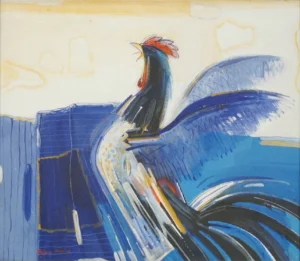
Art Collection & Beyond
Folk art, music, and other forms of art practices have a fairly long history and tradition in Bangladesh. However, there is still a lot of inconsistency about how we properly institutionalise, engage, and treat our own important art and artists, even though a lot of young people go to major exhibitions, mass concerts, and festivals every once in a while. Although there has been a noticeable improvement in the scene that developed in the past few years, especially in the post-pandemic era, the majority of the prominence that we see in social media is still inside a Dhaka-based bubble. Historically, there always had been a lack of responsible actions from the state or government regarding the endorsement of the overall art scene and practice. Not enough quality art education for everyone in schools and even not enough quality art education at universities, the fact that most people are interested in and involved in mainstream art, and facts like some people don’t take part in art responsibly and certain forms of art can be hard to get to are all things that contribute to the problem. In this reality, passionate art collectors and patrons are very rare breeds in Bangladesh. For a long time, Durjoy Rahman had quietly been a prominent figure in the Bangladeshi art scene. He has been personally collecting art for roughly three decades now; it was only in 2018 that he decided to go for a more institutionalised format for further contribution to the local art scene and founded the Durjoy Bangladesh Foundation. Despite the pandemic years and Durjoy’s preference of operating the foundation with very selective personnel, the foundation is promisingly making a name for itself within the niche of the local scene, the Global South, and the wider international art arena. “Many people misinterpret that the foundation is named after me, but the word Durjoy roughly translates as indomitable or invincible in Bengali. I had that in mind while naming the foundtion. Invincible/indomitable Bangladesh is the spirit of DBF,” said Durjoy to Ceramic Bangladesh Magazine at his office for a short but engrossing conversation about art, business, and life over cups of tea and biscuits. Soft-spoken, a bit formal with conversations, and always a well-dressed gentleman with a fatherlike old-school discipline, Durjoy carries a distinct eccentric aura—perhaps like that of many artists. Durjoy’s persona transcends the boxes of notions that are typically associated with the term “rich businessman turned art collector.” Speaking of art collection, he is also known for his amazing collection of various vintage cars. With his businessman father, who was a prominent name in the Jamdani trading scene back in the day, and a mother who was a doctor in the army and a freedom fighter who contributed to the liberation war of 1971, his knack towards business and having a soft corner for Bangladesh is perhaps unsurprising. You grew up in Dhaka cantonment. Do you remember your earliest influence of art— that intrigued you deeply? Absolutely! When we were young, there was a popular weekly literary magazine called ‘Bichitra’. I used to admire its design and the published cartoons. It was the timeline when the famous “Tokai” series by our very own modernist Rafiqun Nabi started getting published in the weekly, and I became a big fan of it. Later in life, when I started collecting, Nabi’s work was my first ever purchase, and now I have over 70 works produced by him. This gives me intense joy; it is as if I am satisfying my inner child. How was the local art and exhibition scene back then, given the type of crowd, their engagement, and the collectors? Furthermore, if we compare the eras of Muzharul Islam, Novera, S M Sultan, Murtaja Baseer, and the other renowned figures practicing the contemporary art scene of Bangladesh, it seems that what they did, considering time context, we still haven’t reached that level of quality despite having a lot more privileges now. There was always a very few collectors and patrons. Given the popularity of cinemas back then, there was always a regular crowd at the theatre shows, but it wasn’t often that we got to see a large number of crowds at exhibitions. The people of the crowd were not as young as those of today. If we talk about the number of people engaging, overall it is a lot more now. These are the big differences if we compare. Speaking about the improvement, I think the quality of contemporary art in Bangladesh is still pretty strong and not something to be undermined. We tend to think that artworks produced during those times are superior compared to contemporary Bangladeshi art, but I don’t entirely agree with that. I think some artworks produced these days are also timeless and very important. In the early 90’s, you entered the design and textile industry and had been successful with your entrepreneurial venture, Winners Creations Ltd. The company has a valuation of over 40 million USD. As a veteran businessman, what are your thoughts regarding the ceramic industry of Bangladesh? If we look at the financial reports, I think they are doing fabulous. It’s a growing industry, and ceramic-based products will always have their demands globally because of how we use them in our day-to-day lives. In my opinion, I think there is always room for improvement in the design. We usually don’t incorporate our local motifs; we don’t utilise our local artisans and talented young designers properly. For example, using elements from rickshaw art. Notably, when I visited Spain and Japan, I saw how beautifully they brought their influence of art into their ceramic products.
Read More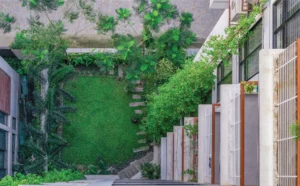
JBS Holding making Green Buildings
JBS Holdings Limited, a Japan-Bangladesh joint venture company, has been in the business of real estate industry, infrastructure development, commercial, and condominium ventures with the association and experience of professional experts and investors from Japan and Bangladesh. Since its inception in 2020, JBS has handed over more than 15 projects, till the end of 2023, to the satisfaction of customers. More than 300 engineers and employees are directly working in the company. The company’s maximum investment came from Japan. The company has 25 ongoing projects and additional 38 upcoming projects across the country. The company is a member of Real Estate and Housing Association of Bangladesh (REHAB) under approval of Rajdhani Unnayan Kartripakkha (RAJUK) or capital development authority. According to Abdul Haque, Managing Director of JBS Holding Ltd, the company within this short span of four years, has been able to occupy a prestigious space in the arena of real estate sector for its commitment and quality. In the past three years, it has completed 15 projects. Most of features of green building were included in those projects. As per requirement of green building it tried to include green building’s features in the buildings. He stated, “JBS Holdings is committed to offering the best investment opportunities to buyers through innovation, continuous improvement, quality and reliability. We believe in a strict Code of Ethics, integrity and commitment to excellence, professional attitude and personalized care.” The country’s real estate sector has been playing a significant role in gross domestic product (GDP). The sector contributes 8-10 per cent to GDP and with related business account 15-17 per cent to the GDP. Thousands of developers, engineers, architects, technicians, MEP experts and workers are engaged directly in this sector. The sector is also supporting the country’s construction-related industries such as rod, cement, ceramic tiles, sanitary ware, paints, woods, glass, cables, aluminium and bricks industry. A lot of products are consumed by the developers helping these industries to sustain, grow and expand. “We want to continue our support to boost the sector in future,” the Managing Director pointed out. Green Building The green building is also known as green construction or sustainable building. The buildings refer to saving resources to the maximum extent including energy saving, land, water, and material saving. Besides, it protects environment and reduces pollution, and provides people with healthy, comfortable and efficient use of space, in harmony with nature. “Those who live in green building get maximum benefits – in terms of health, internal quality environment, resource efficiency, and energy saving. We have the intention to include all features in future, and take international certifications,” Mr Abdul Haque added. He said the commitment is very important in the industry. “We ensure the commitment, complete the buildings before the deadline, ensure quality construction, and maintain compliance. Our clients are also very satisfied. Customer’s satisfaction is our main goal in business.” Location is also important for sustainability. “The site of the building should have good communications network, good atmosphere, and all civic amenities such as healthcare facilities, school, and market. These issues are considered when we take a project,” he explained. “When we design a building, we follow the government’s rules and regulations properly. We keep 50 per cent open of total space of the building site, according to DAP. So, the buildings get enough air, light, oxygen, rainfall, water supply and energy efficient. We look into maximum air and light as well as ventilation system taking a project,” Abdul Haque said. “We consider it while constructing a building. As wind is available there is no need to run AC and fan all times. Besides, solar panel on rooftop of the building helps energy efficiency too. We use the brand’s equipment like lifts, generator, and it helps save energy for operation. We provide a lot of plantations in rooftop, verandahs and terrace of a building. It helps us get adequate oxygen. It keeps cool environment.” Green Building saves 30-40 per cent Energy The demand for the green building is increasing gradually but it has not been popular yet in the country. We have to construct green building as it is a demand of the day. As energy crisis is now across the world, green building needs to ensure naturally benefits like winds, light and energy efficiency, Mr Haque also said. Challenges and recommendations There are a lot of challenges including scarcity of land, and its high cost, urban planning, high registration cost, floor area ratio (FAR), policy complexity, VAT and tax, as well as high living cost now, and land owner’s high demand. He said, “We need a proper real estate-friendly policy which would further boost the sector. So, the government should take a strategy engaging private sector here. The government can take many projects like Purbachal and give it to private developers to develop it. Then, there will be a quick and sustainable development in real estate sector.” Written by Rafik Hasan
Read More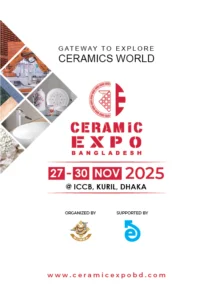
7 Ceramic Events worldwide
The Ceramic exposure and trade fair events across the globe have always been the best mean to interconnect the ceramic verse. The expos are usually a few days long, and as seen in Bangladesh and globally, they are jam packed with buyers, industrialists, business officials, architects and real estate personnel, along with visitors who are enthusiasts. The stalls are local and international businesses showcasing the best and the latest. Visitor count in such an event can reach up to and beyond 20k in Bangladesh, and in China, we’ve seen that number reach six figures. Expos bring about an infusion and adds to the dynamics of the market. The world becomes smaller under one roof, the market gets bigger as global companies collaborate, thus enriching the market place. To name a few of these impactful events, here are noteworthy 7 from around the world: Asean Ceramics (11-13 December, 2024) The 2024 Asean Ceramics exhibition is coming up on the 11th of December and will end on the 13th. It will be hosted at the Saigon Exhibition and Convention Centre in Ho Chi Minh city of Vietnam and will showcase the latest technology, advanced Ceramics, technology used in the manufacturing process, and much more. Asean Ceramics Exhibition had 3000 visitors in 2023, had 200 brands participating, and had more than 200 delegates for the conference. The event was a grand one and a sizable networking hub. Indian Ceramics Asia (5-7 March, 2025) Centered around ceramics and bricks, Indian Ceramics Asia in Gujrat is a one of a kind annual event that brings in key players from around the world. We’ve seen one of the events being hosted at the Helipad Exhibition Centre of Gandhinagar, Gujrat, on 6th March 2025 and continued till the 7th March. The 17th annual event in 2023 was three days long as usual and had 100 companies from 11 countries catering to 6440 visitors. Visitor count for 2024 event was 8200 approx. and there were more than 200 exhibitors. Indian Ceramics Asia is a B2B platform that harbors suppliers and buyers of raw materials and machineries. This event is the ground for two events jointly taking place: India Brick and Roof Tiles Expo and Engineering and Technical Ceramics Exhibition. Indian Ceramics Asia also featured workshops, seminars, and discussions from esteemed Indian officials who talked about improving and increasing trained labour force in India, innovative solutions for the energy and raw material crisis, waste disposal technology, and much more. Foshan Uniceramics Expo (18-22 April, 2025) With over a 100,000 sq.m of exhibition space and 1200 exhibitors, Foshan Uniceramics Expo is a spectacular joint event in Foshan, China, and a leading event in Asia as well. The event welcomes some 150,000 visitors each year, as the two Expos collaborate- Technology Expo and Ceramics Expo. Going through the array of companies lined up at one of the expos, one could see abundance of ceramic tiles, some of Italian and Spanish origin. Products with wear resistance and antique features were also amongst the catalogue of participating companies. SACMI displayed the latest technology in their allocated space, playing an integral role at the event. Asian largest Expo and an esteemed event, Foshan Uniceramics Expo is ever-growing. Ceramic Expo USA (April 28– 30, 2025) USA have had a substantial contribution to global ceramics and the Michigan Expo is a great place to see a cluster of it. Technical ceramics and innovation, both unleashes at this event, highlighting machineries and technology for efficiency and growth and connecting engineers with state of the arts equipment. Product developers and engineers connect with businesses at the event, and it turns to a buzzing ground. North America’s leading technical ceramics exhibitions and conference, Ceramic Expo is held at Michigan, USA, at the Suburban Collection Showplace. Exhibitors such as Bosch, Lithoz, Fiven, among others, participate in the event. Besides finding the latest technology at the event, a visitor goes through an immersive experience where they get to learn from experts, do face to face meetings and much more. Ceramics China (18-21 June, 2025) Another grand event, an expo that welcomes a whopping 80,000 visitors every year, is the Ceramics China, hosted in 2023 at the Canton Fair Complex in Guangzhou, China. The event fosters ‘new’ when it comes to technology and materials for the manufacturing process , and encompasses elite high end companies within its body. The 38th edition of this event aims to gather global innovations for a holistic development of the industry. Other focal points include new generation hydrogen hybrid combustion technology, waste heat recycling technology, AI visual technology, industrial robotics, and much more. The permeability of participating in such an event depends on awe so many factors. The event allows a lions share of its space to machines and spare parts, accounting to 45% of exhibitors. Visitors from beyond borders attend the event adding up to 9.2% of the entire visitor count. CERAMIC EXPO Bangladesh (27-30 November, 2025) 4th Edition of CERAMIC EXPO Bangladesh-2025 is an international exhibition on the global ceramic industry will held in Bangladesh. It brings the local and international manufacturers, exporters, and suppliers of ceramics and related products onto a single platform to showcase their achievements earned through creative entrepreneurship and hard work, to the world. The Expo will be held at the International Convention City Bashundhara (ICCB), at the Expo Zone (Tent Hall) from 27th November to 30th November 2025. The international exhibition is expected to be attended by representatives of more than 300 global brands, manufacturers, and suppliers of ceramic raw materials and machinery from 25 countries. Bangladesh, being a high-quality producer of ceramics and having skilled manpower, low labour cost, and sufficient supply of Sulphur-free natural gas, is perfectly placed to be a strategic partner in the production and supply of ceramic goods on a global scale. As a result, the Expo creates ample scope for foreign ceramic manufacturers, buyers, and investors to explore and invest in the
Read More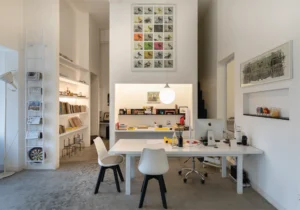
Meet Architect Salauddin Ahmed- UN HOMME AVEC DU PANACHE
Many people spend their entire lives believing that the arts and music are completely different from the hard sciences, which include physics, chemistry, engineering, and even architecture. But are they really? Enter architect Salauddin Ahmed’s Atelier Robin Architects (ARA) in Hazaribagh and marvel in the atelier’s (French for studio) all-white, lofty, and expansive interior. You will see that architecture is not truly that far from art, if at all. Walking into Salauddin’s studio was in part equivalent to getting a glimpse of his inner workings: neat, geometrically perfect, and symmetrical. Aside from the conference room, which doubles as a miniature gallery, paintings and his sketchbooks are neatly spread out in the spatial atelier, where voices echo. Salauddin, a creator as well, designed most of the fixtures and furniture in the studio. But what sets ARA’s principal architect apart from the other practitioners in the industry? His schooling is in the US. His decade-and-a-half-long stay in the US, where he studied architecture at the University of Pennsylvania, in his career-forming phase exposed him to elements of his trade that are otherwise tough to attain in Bangladesh. “I didn’t come here to settle down. I came here to try it out. During my time away from here and being involved academically, I met architect, urbanist, and architectural historian Kazi Khaleed Ashraf. He influenced me to try out my trade in Bangladesh, as there were many opportunities here when I was starting out professionally, circa 1995. Then I did discover the vastness of the architectural practice in Bangladesh,” Salauddin said, explaining why he stayed back. Then he went on to compare architecture with music, alluding to how Wolfgang Amadeus Mozart perfected music from the age of four for the love of music—not commercialisation or leaving behind a vast collection but simply a legacy. “If an architect is just building buildings at an existential level, then,” he retorted, “it’s not architecture at all. Architecture is in the conscious and the subconscious; that is the vastness of architectural practice.” As Dhaka expands northward, homogenous residential buildings are popping out everywhere. People need a place to live, yes, but these buildings are just mere cages with the most basic elements that do not remotely enhance the art of living. The schooling our young architects are receiving just deals with hyper-commercial ways of living—ways in which more buildings and apartments can be crammed into the ever-so-dwindling space of Dhaka. “The application of laws, codes, and the conduct of architecture are barely taken into consideration by the authority. All the authority cares for, almost in a military fashion, is that the buildings conform to straight lines and extremely basic designs. They are not bothered by the emotional contact that architecture bears with the art of living. Habitats that enhance the beauty of living are underscored as a passion project, and they simply don’t make a lot of money. The number of architects presently practicing is sky-high, but that number needs to be threefold as high. However, they also have the mammoth task of dictating to society how architecture works. Bangladeshi architect and urban planner Muzharul Islam embodies that ideal concept of architecture. Later on, a school was set up to learn and then unlearn Muzharul Islam to create room for fresher ideas. That has been a successful way forward, a tried and tested system through which many contemporary architects of renown have come forward. But a few exceptions cannot be an example. In a country like Bangladesh, one or two exceptions will not do,” he explained it in detail. In all sincerity, Salauddin stressed emphatically the importance of ‘averageness’. “The word average carries a negative meaning in our society. But it has been proven that a person who carries themselves with the average air is the most attractive. However, the importance of averageness is not taught at an academic level. For example, all circles don’t have to be spherical. There is beauty in a slightly elliptical and average circle as well.” This city should represent an old ‘kantha’ that is average and not gaudy, so that everyone feels a level of comfort and familiarity, thus explaining averageness. Most Dhaka residents cannot afford such luxury, which makes an average approach go hand in hand with architecture: turning an empty lot into a home. “Dhaka is growing, but as an orphan,” Salauddin said morosely. Although much opportunity is not there to salvage Dhaka anymore from its systematic ruination, “possibilities” are, however, still there. His atelier is proof of that! Walking through the mazes of what used to be the heart of the now-removed tannery industry in Hazaribagh leads to his studio. A 15-foot gate, which could almost function as a castle drawbridge, welcomes you into the imposing interior. One would be left in awe that such a magnificent studio can be set up in a relic of a retired tannery. To Salauddin, it is the will and temperament that matter. “It’s a part of my ensemble: I take immense personal struggle to show someone the possibility.” Getting back on the matter of urban design, he spoke briefly about how it is done in successful cosmopolitan cities, one in which he once resided for a while. He elaborated, “Everybody here wants a south-facing veranda. Okay, but his neighbour might be deprived of the southern wind if he takes up all the space. In New York, for example, there’s a code: your building cannot project two hours of shadow on any surface in an eight-hour window. If you cast a shadow long enough, the adjacent building will need more heating capacity in the cold and get much less sun during the day. Your design form has to respect the many constituencies of urban design. This is impossible to even imagine in Dhaka.” The long conversation ended on a beautiful note. He said, “Ninety
Read More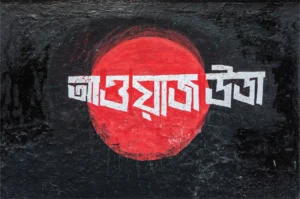
Graffiti Of Revolution
The essence of what Bangladesh witnessed last July-August, during a student-led protest, which emerged to a mass rage, turned into a blood-shading revolution. Eventually, it brought us what we now call a new Bangladesh. All that went through is difficult to put into words. Every single individual who was somehow part of the revolution—the ones who were out in the streets and directly witnessed both the brutalities and the togetherness of people; those who gave shelter and food to the protestors, took the injured for medical aid, and even those who kept the spirit alive in social media—the memories of July are firmly etched in everyone’s hearts, with their fair share of bitter sweetness. Given that visual communication is very impactful, visual materials played a vital role as a monumental catalyst in this revolution. While cartoons, photographs, and videos of the atrocities instantly circulated in social media almost every day, the graffiti mostly consisted of revolutionary and populist slogans on the city’s concrete, which acted as a source of constant inspiration for the ones who were on the street during the protest and even after the chaos was over. Graffiti, as an art form, has its own distinct raw flavour. Using graffiti as a tool for protest has always been a part of the biggest revolutions and mass uprisings in contemporary world history. The role of graffiti in the July-August revolution in Bangladesh is no different. Bangladesh has a long history of using graffiti as a form of protest. Graffiti was a common tool utilised by dissenting parties to express their disapproval throughout the Liberation War in 1971 and the political unrest of the 1980s. However, the pattern of graffiti we witnessed in July-August was comparatively unique, primarily because it represented a generation that many had assumed to be politically disengaged. Graffiti, or wall paintings, first emerged in New York in the ‘60s before spreadi ng worldwide. However, it has not taken root globally as profoundly as in Bangladesh. Reflecting on 53 years of post-liberation discrimination and turmoil, young students have distilled its essence through their art. During the anti-discrimination movement, Dhaka earned the title of the “graffiti capital” of the world. The walls became vast canvases of protest, adorned with creative and heartfelt slogans and poems that delivered powerful messages to the government. Furthermore, their graffiti themes did not only address particular political complaints but also lurking issues of social justice and human rights in Bangladesh. A significant number of these graffitis were direct one-liners spray painted by the students with a lot of risk during the tense times of the revolution. Even after achieving the desired victory through the revolution, new graffiti kept emerging, depicting the scenes of revolt, resistance, victory, and even more, including portraying the most memorable events and lines with humor. With utmost care, the concrete of the metropolis proudly holds these graffitis that reverberate the spirit of the revolution, acting as a memoir and constant reminder of what must not be forgotten.
Read More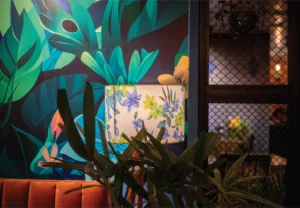
A Journey Of a Thai Culinary Excellence of and Artistic Innovation
We are sure that there are times when you crave some good tangy Thai flavours and also miss the vibrant experience of street life in Thailand. Naming from the famous street of Bangkok, Khao San is such a place where you can meet both. Founded by four friends – Bushra Haque Sarah, Syed Sameem Shahriyar, Taposh Ghosh, and Mustafid Raiyan Khan—Khao San is more than just a dining spot; it’s a passion project. After gaining popularity in Dhanmondi, Khao San has now made its mark in the heart of Gulshan. Despite being open for only a few months, the restaurant has already captured the hearts of diners with its delectable taste and unique interior. With the air infused with tantalising Thai flavours and the atmosphere adorned with bold hues with a pinch of earthy colours, the restaurant interior pays an ode to its famous Thai street namesake, Khao San Road. As guests step into this new branch, they might subconsciously reminisce about the interior of Dhanmondi and immediately be enveloped in a newer enchantment. The restaurant not only draws its name from the famous road but also matches the vibes of the lively and bustling area renowned for its vibrant nightlife and dynamic energy. Through careful design interventions, the restaurant’s interior captures this spirited ambiance, blending the bustling vibe of Khao San Road with a serene touch of nature. We designed Khao San Gulshan with the Dhanmondi branch in mind. We tried to maintain a similar essence,” said Sheefa. Like the debut branch, the interior has been done by Rahnuma Tasnim Sheefa, the principal architect of Parti.Studio. Once you’re inside Khao San Gulshan, you will consciously notice the wooden motifs on the main door, inspired by the lotus flowers of Thailand. The same motif is also reflected in the door knobs of washrooms and a partition door, creating a cohesive design throughout the space. The designer has carefully merged the wooden motifs with the glass, creating a screening that added a modern touch to the usual traditional design element. Upon entering the space, you will be greeted by a vibrant, real tuk-tuk. The dining area is mostly an open plan divided into several zones that are connected visually yet spaced out with mesh dividers and plants. There’s also a private room for larger groups. One of the seating zones features an elevated floor space where you will discover a wall composed of a wooden window with a stunning mural painted inside and designed beside a rustic doorframe. As the architect described, the entire space is very “instagrammable.”. You will find corners or elements to take dope pictures. With splashes of vibrant hues, warm tones, and moody ambient lighting, each nook and cranny has been designed to capture the eyes of the visitors, inviting them to take a closer look and explore the decor. The restaurant design mimics the scenic nature and happening city life of Thailand, interpreted to fit into the theme. Through closer inspection, you will be able to decipher that the city-influenced part of the restaurant has warm tones of orange, red, and yellow. On the other side, the nature part has an upper hand with cool tones of blues and greens. “Throughout the space, we introduced natural plants to keep the nature found. On a wall, you will find a huge illustration with an elephant, which is a vital character from the branding. The story goes like the elephant, after exploring the city, is moving from city to jungle,” added Sheefa. To keep up with the traditions of murals in the Khao San restaurants, the architect had to face some challenges. In the Dhanmondi branch of Khao San, you will find hand-painted murals; however, due to the building’s age and damp walls, hand-painting wasn’t feasible in the Gulshan branch. As a creative solution, Sheefa introduced illustration murals in sticker format, ensuring the same artistic touch while overcoming the challenges posed by the building’s condition. The amazing representation of the ideas was displayed in the form of illustrations by Mashqurur Belal Sabri. The architect took special care to include the implementation of our local craftsmen. All the furniture used in the restaurant is designed and crafted by local artisans. The decorative items, including the metal hanging lights, are also customised and locally made. One of the major setbacks of the restaurant space was its ceiling height, which is quite lower than the average. As a result, a false ceiling was barely an option. “Though I highly oppose using false ceilings, but at rare times when necessary for concealing wiring, considering the already limited height of the ceiling, installing them would only make the space feel cramped and claustrophobic. Therefore, we minimised the use of false ceilings and chose grid wiring in the original ceiling,” explained Sheefa. The architect designed the wiring grids on the original ceiling very innovatively. Some of the grids are functional; a few are added only to make the grid design complete. The decorative items are hung carefully, keeping careful alignment with the grids. The ACs have been camouflaged very interestingly, merged with the backgrounds, allowing the murals to flow seamlessly through the space without interruptions. The murals are very artistic, reflecting the hustle and bustle of Thai city life and its nature. Within a few months of its operation, the restaurant gained unparalleled popularity in the area and is mostly packed to capacity during the peak meal hours. The vibrant and colourful décor with artsy and picturesque style combined with affordable yet authentic Thai cuisine beckons customers from far and near to Khao San to enjoy a truly enjoyable gastronomic experience. Written By Kaniz F Supriya & Quazi Anika Afrin
Read More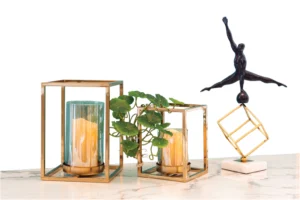
Of trinkets, chandeliers and everything be dazzling
Your home decor is an extension of your personality and style. It’s a reflection of your tastes, preferences, and values. Believing in the notion, Satori started its journey in 2012, to provide city dwellers with start-of-the-art home decor items. Conceptualized and founded by Shaon Tanvir, Satori is a pioneering brand in the world of high-end home decor items. All of its products are handpicked and imported from Dubai, Thailand & China based on customers’ demand. Currently, they have three branches in the city, two in Banani and the other one in Gulshan. Stepping into any Satori showroom, anyone is immediately enveloped in an aura of opulence. Majestic chandeliers, installed in intervals, illuminate the space, guiding your path, while framed mirrors capture and reflect your presence, enhancing a sense of warm welcome. Everywhere you look, there are countless trinkets and treasures. Feels like you have entered into the celebration of art, aesthetics, and all things visually captivating. “As pioneers in the industry, we specialise in importing and curating modern luxury home décor items that stand as a testament to our commitment to quality and style. More than a selling platform Besides selling retail home decor items, Satori provides complete home décor solutions according to individual clients’ needs or architectural design They also offer complete lighting solutions for residences, developers,’ corporates, resorts, boutique hotels, and more. “We specialise in providing customised lighting and total lighting solutions and often collaborate with architects and interior designers,” added Shaon Tanvir. The brand offers a wide array of unique design products, starting from miniature sculptures to grand chandeliers. One of its focused categories is lighting like table & floor lamps, wall lights, chandeliers, ceiling lights, track, spot and LED lights, ambiance lights, etc. Fast-moving gifts and small décor items like candle stands, showpieces, flowers, vases, cushion covers, runners, mirrors, metal wall art, and paintings are also some of the most sought-after items by the brand. Additionally, you will also find carefully selected signature small furniture like consoles, coffee and side tables, and other feature pieces at Satori. Adapting to Dynamic Trends As urbanisation and contemporary living redefine our lifestyles, Satori stands at the forefront, attuned to the evolving demands of its clientele. According to Shaon Tanvir, Satori has been playing a pivotal role in reshaping customer perceptions regarding home decor, transforming once-deemed luxuries into modern-day essentials. “What was once considered a luxury is now deemed a necessity,” she remarked, highlighting the brand’s role in reflecting and accommodating shifting consumer needs. Tanvir also emphasises the profound impact of travel and social media on consumer preferences. With increased exposure to diverse lifestyles and design aesthetics, customers now seek to replicate the lavish home decor they encounter online, demanding accessibility to such lifestyle elements within their own homes. Satori takes pride in popularising numerous unconventional decor items, introducing novel concepts to the local market. What distinguishes Satori and maintains its stronghold in the competitive home decor segment is its product offerings in the dynamic market landscape. The brand’s success lies in its ability to curate a selection of unique and trendy items, renowned for their aesthetic appeal. Satori not only introduces fresh decor concepts to the local market but also sources distinctive designs of established items, offering exceptional value to its customers. If you are looking for interesting items to bring added dynamics to your space, or simply looking for an ideal gift for someone’s housewarming party, Satori certainly deserves your attention.
Read More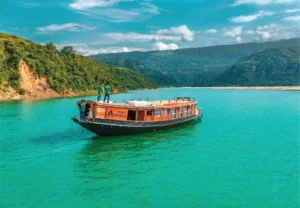
TANGUAR BLUES
If you have ever had the blessing to travel extensively in Bangladesh, there is something in particular about her geography that you must have noticed: the plethora of her beautiful waters. Being the largest delta on earth, perhaps it is unsurprising that Bangladesh has her own unmatched collection of breathtaking, fericious, and soothing wetlands, rivers, and other different types of water bodies, and of course the mighty Bay of Bengal, where every drop meets. A notable part of Bangladesh’s water bodies are wetland ecosystems in the north-eastern part of Bangladesh, which are physically a bowl or saucer-shaped shallow depression, locally called a “haor”, which is basically known as a backswamp. During monsoons, haors receive surface runoff water from rivers and canals to become vast stretches of enchanting, turbulent waters. Over the course of the past few years, Tanguar Haor, located in Dharmapasha in Tahirpur upazila, Sunamganj district of greater Sylhet region, and the foothills of India’s Meghalaya, have cemented their place as a sensation amongst the minds of all types of tourists and travelers. Especially with the rise of travel vlogs and other types of travel-related videos in this time of social media and influencer culture, the popularity of spaces like Tanguar Haor skyrocketed. Even in off seasons, tourists and travelers of all types flock to Tanguar Haor to immerse themselves in it or to simply witness its allure. But what makes Tanguar Haor so addictive is the essence of its inexplicable aura of spirituality. Shutting your eyelids and just listening to the sounds of Tanguar Haor’s bluest of waters will engulf you and take you to a serene wonderland that is impossible to encapsulate with words. Spaces like Tanguar Haor always have their own stack of mythical tales and different kinds of histories. One such thing that goes hand in hand is music. The original stories of local music genres and the backdrops of many legendary creations are closely related to water. One such is a type of folk music called “Ghetu Gaan”, which originated from such types of wetland areas where parts of the year were dry and everyone was busy working in the fields, taking care of livestock etc. and had nothing much to do during the entire monsoon, is when the inhabitants, especially the boatmen and local poets and musicians, organically started crafting such music. Another very interesting fact about this art practice is that teenage boys were dressed up as girls to perform and dance in Ghetu Gaan. In fact, the plot of the last ever movie made by the legendary Bangladeshi novelist and filmmaker Humayun Ahmed, “Ghetuputro Komola,” revolves around the practice of Ghetu Gaan. The practice itself has a lot of very interesting and tragic histories. Although this particular practice is almost extinct now, other kinds of music are still an integral part of our lives. Tanguar Haor is also one of the largest natural water reservoirs in South Asia. This natural wonder is the second largest freshwater wetland in Bangladesh spread over an area of about 126 square kilometres, and is a reservoir of trees, fish, birds and natural biodiversity. More than 30 fountains from the world’s rainiest Meghalaya hills merge in this haor. The Tanguar Haor is called the mother of all haors and the mother of fisheries as well, with a catchment area of 12,665 hectares (31,275 acres) of land. Tanguar Haor is the largest wetland consisting of 51 haors in 18 mauzas of two upazilas (sub-districts) in Sunamganj. 30 square kilometers of water-logged main haor and the rest is residential and agricultural land. There are 88 villages in and on the banks of the Haor area. When the water dries up in the winter season, the banks (‘kanda’ in local language) of about 24 beels wake up, only the inner part of the kanda (banks) has the original beel, and the local farmers cultivate winter crops and boro paddy in the dry part. During this time the area was also used as a pasture. Migratory birds take shelter in the high banks (kanda) of Haor, submerged in water during monsoons. The haor is also known in Bangla as “Naikuri Kanda’s Chaikuri Beel” to the local people. IUCN is working to protect the biodiversity of this region. Tanguar Haor’s landscape is characterised by its seasonal flooding and drying cycles, creating a dynamic and ever-changing environment. During the monsoon season, the haor swells as it receives water from the surrounding hills and rivers, covering the land in a shimmering expanse of water. In contrast, the dry season reveals a mosaic of shallow lakes, marshes, and lush green fields, exposing the intricate network of channels and water bodies that define the region’s unique ecosystem. This cyclical transformation is a key feature of Tanguar Haor’s nature, influencing its diverse flora and fauna and contributing to its rich biodiversity. The haor is home to a rich variety of aquatic and terrestrial flora that thrives in the wetland ecosystem. Its waterlogged environment supports a profusion of aquatic plants, including water lilies, lotus, and various submerged grasses. These plants play a vital role in providing habitat, shelter, and food for the area’s diverse aquatic fauna. Along the highway’s edges, you’ll find an assortment of riparian vegetation, such as reeds and sedges. These plants help stabilise the shoreline, prevent erosion, and offer refuge to various small mammals and birds. Mats of floating vegetation, including duckweed and water hyacinth, are common sights on the lake’s surface. These mats provide a crucial food source for herbivorous aquatic animals and create hiding places for fish. During the dry season, the area’s submerged grasslands emerge, providing feeding grounds for waterfowl and grazing areas for cattle. These grasslands are also important for the farm’s agricultural activities. It is home to over 200 species of fish. The seasonal flooding provides an ideal breeding environment for many of these fish, sustaining local fishing communities. The wetland is also home to various reptiles and amphibians, including snakes, turtles, and frogs. Some of these species
Read More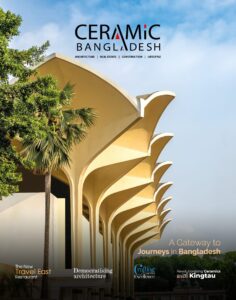
Kamalapur Railway Station: A Gateway to Journeys in Bangladesh
Kamalapur Railway Station, officially known as Dhaka Central Railway Station, stands as a bustling gateway to the vibrant capital city of Dhaka. Nestled in the heart of the city, this vital transportation hub connects travellers to all major cities in Bangladesh. As the largest and busiest railway station in the country, Kamalapur serves as a crucial link, facilitating journeys both near and far. Its rich history, architectural significance, and constant activity make it an iconic landmark. With a unique design and historical roots, Kamalapur Railway Station weaves together the fabric of Bangladesh’s rail network. The station’s significance has increased following the opening of the Padma Bridge. Kamalapur Railway Station (KRS), steeped in history, stands as Dhaka’s historic gateway. Its iron-clad colonial-era architecture evokes memories of a bygone era, a bridge between past and present. But Kamalapur is more than just a transit point; it embodies the spirit of a nation on the move—a pulsating heartbeat that reverberates across Bangladesh. Kamalapur Railway Station stands as a vital link in Bangladesh’s transportation network, connecting people, cultures, and commerce. As trains arrive and depart, the passengers weave intricate stories etched into the very walls of this magnificent station. Here, hope mingles with anticipation, dreams find their rhythm, and reunions unfold. The station’s bustling platforms witness resilience—the quiet strength of travellers forging ahead despite life’s twists and turns. And within its echoing halls, new beginnings take root, fueled by the promise of distant horizons. Kamalapur Railway Station, standing tall against the passage of time, is a living testament to Bangladesh’s architectural ingenuity. It’s not merely a physical structure; it’s a gateway to aspirations, connections, and the beating heart of a nation. As passengers step onto its platforms, they become part of a grand narrative—a journey that transcends mere destinations and becomes an enduring legacy of rail travel in Bangladesh. Architectural Marvel Kamalapur Railway Station stands as a captivating blend of modernity and tradition. More than a mere transportation hub, it represents an architectural marvel that seamlessly connects the past with the present. Designed by the renowned American architects Daniel Dunham and Robert Boughey (Bob Buie) of Louis Berger and Consulting Engineers Ltd. in the 1960s, Kamalapur Railway Station serves as a symbolic gateway to Dhaka. Daniel Dunham, a young architect fresh from completing his studies at Harvard’s Graduate School of Design (GSD), took charge of Berger’s fledgling Dhaka office. His task was to tackle an extensive backlog of new projects. The station’s architecture draws inspiration from both modernist principles and traditional neo-Islamic influences, as well as Bengali styles. It stands as a testament to Dhaka’s modern architectural spirit. Architect Daniel Dunham skillfully blended modernist elements with traditional Bangladeshi architecture. The station’s most striking feature is its parabolic shell roof—a true engineering masterpiece. Stretching over the platforms, this roof provides shelter to passengers. The lattice-like concrete structure fosters openness and allows natural light to filter through, creating a welcoming ambiance. Kamalapur Railway Station officially opened on May 1, 1968, during President Ayub Khan’s tenure. Its construction cost at the time was Taka 5 crores 30 lakh. When the value of one vori of gold stood at only 100 takas, A year after its inauguration, the Provincial Office of the Railway Postal Service found its new home within this remarkable station building. Design Features The station building is well-suited for tropical climates, providing protection from rainwater like an umbrella. It incorporates various functional spaces, including ticket booths, administrative offices, passenger lounges, waiting areas, and restrooms, all under an integrated canopy-based roof. The structure comprises 36 square domes supported by a total of 49 columns. Above these columns stands a roof featuring 36 slender concrete umbrella-type domes. Each column extends 59 feet high, branching out to support the roof. The open-air design capitalises on Dhaka’s cross breezes while safeguarding interior spaces from monsoon rains. The Kamlapur Railway Station’s thin concrete shell dome-umbrella design, completed by the consultants, has become a local icon, cherished by prominent architects as a cultural heritage piece. The parasol roof continues to define the station’s unique skyline. Architect Dunham immersed himself in Bangladeshi culture, learning Bengali and adapting to local craftsmanship and construction practices. Instead of designing an enclosed monolithic structure with mechanical heating and cooling systems, Dunham leveraged Dhaka’s tropical climate. His innovative roof system provides shade over the station’s offices and facilities, supported by a versatile field of columns. The construction technique involves thin concrete shells, which Dunham explored during his thesis at the GSD. After Dunham’s departure, architect Robert Boughey took over the post, designing tessellating concrete shells for the roof, reminiscent of pointed arches seen in Islamic architecture. These shells were cast on-site using reusable materials. Kamalapur Railway Station, with its remarkable parabolic shell roof, stands as an engineering marvel. This expansive structure spans the platforms, providing shelter to passengers. The station’s circular layout, boasting a diameter of 186 metres, centres around a soaring dome that reaches a height of 26 meters. Eight radial wings extend from the central hub, housing platforms, and tracks. The station’s architecture seamlessly blends modernist elements with traditional Bangladeshi motifs, reflecting the nation’s spirit. The concrete lattice structure allows natural light to filter through, creating an airy and open ambiance. High ceilings and spacious interiors enhance the feeling of grandeur. Kamalapur’s design prioritises functionality while maintaining aesthetic appeal. Geometric patterns, arches, and intricate details evoke the essence of Bengali culture. As a testament to Bangladesh’s identity and heritage, Kamalapur Railway Station stands proudly. The station is an engineering marvel that spans the platforms, providing shelter to passengers. Additionally, in other parts of the country, the Sylhet Railway Station in the north-eastern region and the Chilahati International Rail Station in the north-western part also feature a similar umbrella-like structure. These stations use national flower-shaped “shapla” shells supported by a forest of columns to cover their facilities. Historical Context Bangladesh Railway has been operating in the British period since 1862 in the eastern and western parts of the country, divided by the great river
Read More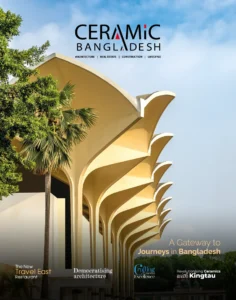
Kamalapur Railway Station: A Gateway to Journeys in Bangladesh
Kamalapur Railway Station, officially known as Dhaka Central Railway Station, stands as a bustling gateway to the vibrant capital city of Dhaka. Nestled in the heart of the city, this vital transportation hub connects travellers to all major cities in Bangladesh. As the largest and busiest railway station in the country, Kamalapur serves as a crucial link, facilitating journeys both near and far.
Read More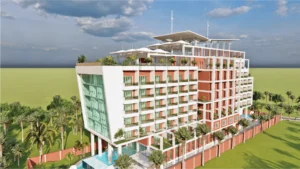
Democratising architecture: Design that inspires awe and closeness to home
It was as though the beauty, heritage, and history of Mymensingh were plotting the becoming of Architect Masudur Rahman Khan – his birth city. Growing up in vast and glorious Mymensingh, which runs along Old Brahmaputra’s shores and birthed the Nakshi Kantha, Maimansingha Gitika and Shilpacharya Zainul Abedin, the BUET-alum Architect fashions his edifices from the collective memories of his childhood.
Read More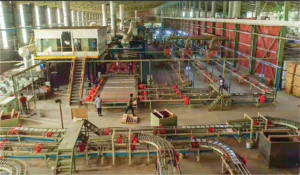
Crafting Timeless Excellence
BHL CERAMICS, the flagship brand owned by BHL GROUP Pvt. Ltd., has evolved over three decades as a dynamic business house and consumer products manufacturer. Since its inception in 2017, BHL Ceramic Co. Ltd. has become one of Bangladesh’s largest ceramic tile manufacturers, symbolizing artistry and creativity. The company’s mission is to reduce reliance on imported foreign tiles and boost domestic production, creating employment opportunities.
Read More
National Budget Thru Turbulent Waters Ceramic Industry Ignored in Budget
The recently unveiled Tk 7.97 trillion national budget for the 2024-25 fiscal year for Bangladesh aims to bringing a balance between controlling inflation and attaining economic growth. Economists, however, caution that higher borrowing and increased taxes on certain goods may prolong inflationary pressures. The budget’s reliance on domestic borrowing could lead to a “crowding-out effect,” restricting financing for businesses, particularly SMEs. Despite a target of 6.75 per cent GDP growth and plans to reduce inflation to 6.5 per cent, achieving these goals is deemed challenging. The budget proposes revenue of Tk 5.45 trillion with NBR tax amounting to Tk 4.80 trillion, leaving a Tk 2.56 trillion deficit to be primarily financed through bank borrowing, which may prompt money printing by the central bank and further inflation. Economists welcome the conservative approach but criticise the plan to increase electricity prices, potentially exacerbating inflation. The budget also includes initiatives for digital transformation and job creation in the IT sector, aiming to attract foreign investment. However, with foreign funding dwindling and significant tax increases on various goods, the effectiveness of these measures in achieving the stated economic targets remains uncertain. Bangladesh’s economic landscape is currently beset by numerous challenges, including stagnant investment, mounting debt repayment obligations, sluggish external sector growth, dwindling foreign exchange reserves, a fragile financial sector, tepid economic expansion, unemployment woes, and widening inequality, apart from soaring inflation. The proposed budget must confront immediate hurdles head-on through targeted budget allocations and fiscal policies. Although the budget is crafted for a single fiscal cycle, it serves as the conduit for translating the government’s economic strategies and political vision into reality. Hence, the proposed budget assumes paramount importance in tackling pressing issues such as safeguarding the interests of the impoverished, low-income, and lower-middle-income households, as well as addressing short to medium-term challenges such as fostering robust economic growth and curbing inequality. Given the prevailing economic exigencies, the FY2024-25 budget must pivot on four critical areas. Dr. Muhammad Abdul Mazid, a former chairman of the NBR, emphasised that this year’s budget cannot be compared to those announced in the past 8-10 years due to the turbulent global economy and several macroeconomic challenges facing Bangladesh. These challenges include a reserve crisis, dollar devaluation against the Bangladeshi Taka, higher inflation rates, and various governance issues. He asserted that overcoming the hurdles facing Bangladesh’s economy in the national budget will be difficult all of a sudden and in a shorter period. Instead, the government should focus on shaping a roadmap to navigate these crises. Dr. Mazid recommended that the budget should not follow the typical patterns of previous fiscal years; rather, it should include reforms in fiscal and monetary policy to address inflation, the dollar crisis, and reserve issues. Additionally, he suggested the formation of a banking commission to address loopholes in the banking sector. To curb inflation, the National Board of Revenue (NBR) could reduce duties on certain products, but effective market monitoring and management are essential to realise the benefits of such duty reductions. Strengthening the NBR’s capacity is crucial for enhanced revenue realisation. Moreover, Dr. Mazid stressed the importance of allowing concerned government organisations, such as the Anti-Corruption Commission (ACC), to operate independently to ensure effective governance. Ceramic Industry Overlooked The ceramic industry, part of the private manufacturing sector, has been significantly overlooked in the proposed national budget. Leaders of Bangladesh’s ceramic sector are urging for the removal of the 15 per cent supplementary duty on local tiles and the 10 per cent duty on domestic sanitary products. They point to rising raw material and gas prices, which have increased production costs. By eliminating these duties, they believe consumer prices would decrease. Md Shirajul Islam Mollah, a Member of Parliament and President of the Bangladesh Ceramic Manufacturers and Exporters Association (BCMEA), had previously proposed removing additional duties on raw material imports and increasing tariffs on foreign ceramic products to the National Board of Revenue (NBR) before the 2024-25 fiscal year’s budget announcement. These measures would reduce imports, save foreign exchange, and boost employment in the country. Despite the relevance of these proposals, none were addressed in the budget. The domestic ceramic market, valued at Tk 8,500 crore. Although domestic companies control over 80 per cent of the market, they face tough competition from imports due to high production costs. On one hand, due to the dollar crisis, L/Cs (letters of credit) are not being opened for importing sufficient raw materials and machinery. Additionally, despite high prices, necessary gas for producing finished goods is not being supplied. On the other hand, amidst dollar crisis, the Bangladesh Bank has announced a second term reduction in cash incentives for ceramic exports—from 10% to 6%—within a span of six months. Meanwhile, the cost of doing business continuously increases. Over the past year and a half, Bangladesh has received loans from the IMF in three installments, but despite implementing several conditions attached to the loan, there has been no such improvement; rather than deterioration. Addressing Fiscal Challenges Economists believe, in the face of daunting economic hurdles, Bangladesh must embark on a prudent fiscal course to steer through turbulent waters. With inflationary pressures mounting and investment stagnating, the budget for the 2024-25 fiscal year demands meticulous attention to fiscal prudence. The government’s traditional reliance on banking sector borrowings to bridge budget deficits exacerbates interest payment burdens amidst constrained fiscal space. Hence, a judicious fiscal consolidation strategy, entailing restrained spending and bolstered tax collection efforts, emerges as imperative. Empowering the Social Sector While substantial investments have buoyed physical infrastructure, the social sector languishes due to chronic underfunding. Education and healthcare sectors, in particular, warrant heightened attention, with allocations in FY2024 falling woefully short of requirements. Fostering human capital development through increased expenditure on education, healthcare, and skills development is indispensable for sustainable growth and inclusivity. Facilitating Small Business Growth Small businesses, the lifeblood of the economy, must be empowered through facilitated access to finance. The banking sector’s burgeoning non-performing loans pose a formidable barrier to lending, stifling entrepreneurial endeavours. Elevating
Read More

